
- About
- Library
-
Essays
Eric Dinerstein William C. Young
- Plants
- Birds
FIELD NOTES FOR YELLOWSTONE, GRAND TETON, AND BOULDER
June 1 - 13, 2016
William Young
I flew into Denver Airport on Wednesday, June 1, and took a bus to Boulder to visit my friend Doris. I spent a few days in Boulder before Doris and I left for a nine-day trip to Yellowstone and Grand Teton National Parks. On Thursday, I hiked around the Wonderland Lake area, and on Friday, I birded around Walden Ponds. Both of these areas had a lot of birds and beautiful vistas, and they are not far from where Doris lives.
 Wonderland Lake - Photo by William Young
Wonderland Lake - Photo by William Young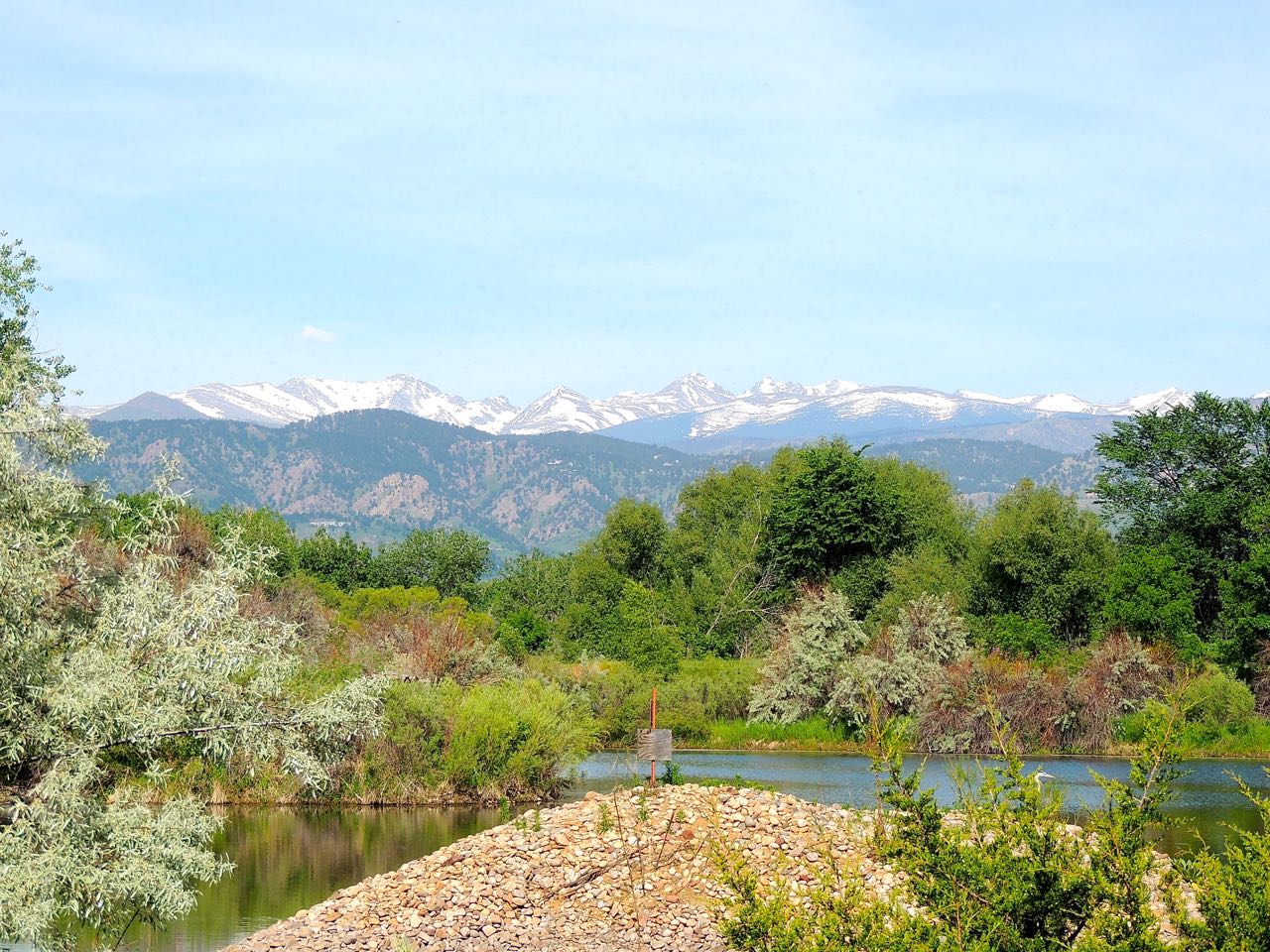 Walden Ponds - Photo by William Young
Walden Ponds - Photo by William YoungWe left on Saturday and stopped to visit Doris's mother, sister, and brother in Fort Collins before heading north. We made a slight detour through the Pawnee Grasslands in northern Colorado before continuing to Thermopolis, Wyoming, which is east of Yellowstone. We spent the night in Thermopolis and visited the state park there the next morning. We then drove through Cody, Wyoming, which is named after "Buffalo Bill" Cody, on our way toward the northeast entrance to Yellowstone. We drove to a motel in Red Lodge, Montana, by way of the Beartooth Highway, which goes through Beartooth Pass at an elevation of close to 11,000 feet. The scenery was spectacular, and the next morning, we retraced our route and drove on the Beartooth Highway in the other direction. We arrived in Cooke City, Montana, for lunch. After lunch, we entered Yellowstone and explored the eastern portion of the park.
We spent the next four nights in Gardiner, Montana, which is outside the northwest entrance to Yellowstone and across the border from Wyoming. We explored Yellowstone, and we took side trips to Henrys Lake, Idaho, which is southwest of Gardiner, and Jardine, Montana, which is northeast. On Friday, June 10, we left Gardiner and headed to Jackson, Wyoming, which is near the south end of Grand Teton National Park. The next day, we explored the park and took a raft trip on the Snake River. On Sunday, we made the 500-mile drive from Jackson to Boulder, and I flew back to Washington, DC, the next morning.
We had no guides and minimal schedules for the trip, and we went wherever we felt like, often on the spur of the moment. Each year, Yellowstone accommodates more than 4 million visitors, and they are putting substantial strains on the park. There are also new problems, and we saw signs saying that drone-flying in the park was prohibited.
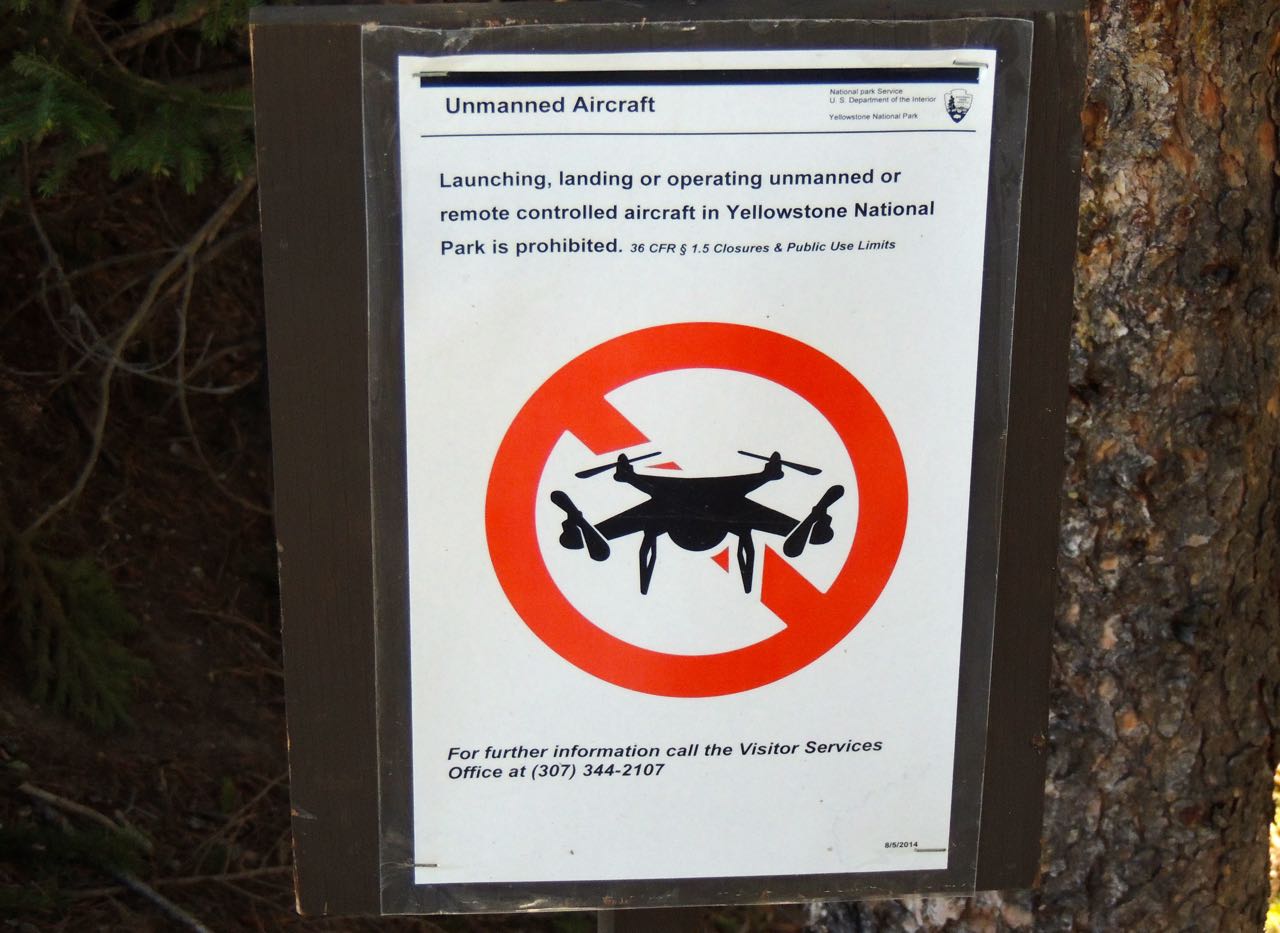 Drone Sign - Photo by William Young
Drone Sign - Photo by William YoungI chose early June for the trip, because I thought we would avoid some of the crowds who came on family vacations. School had not let out in many places, so we did not see a lot of children. We still saw a lot of tourists. In one area where a tour bus had parked, a woman asked me if I was from Northern Virginia. She is a member of my local bird club, and she recognized me.
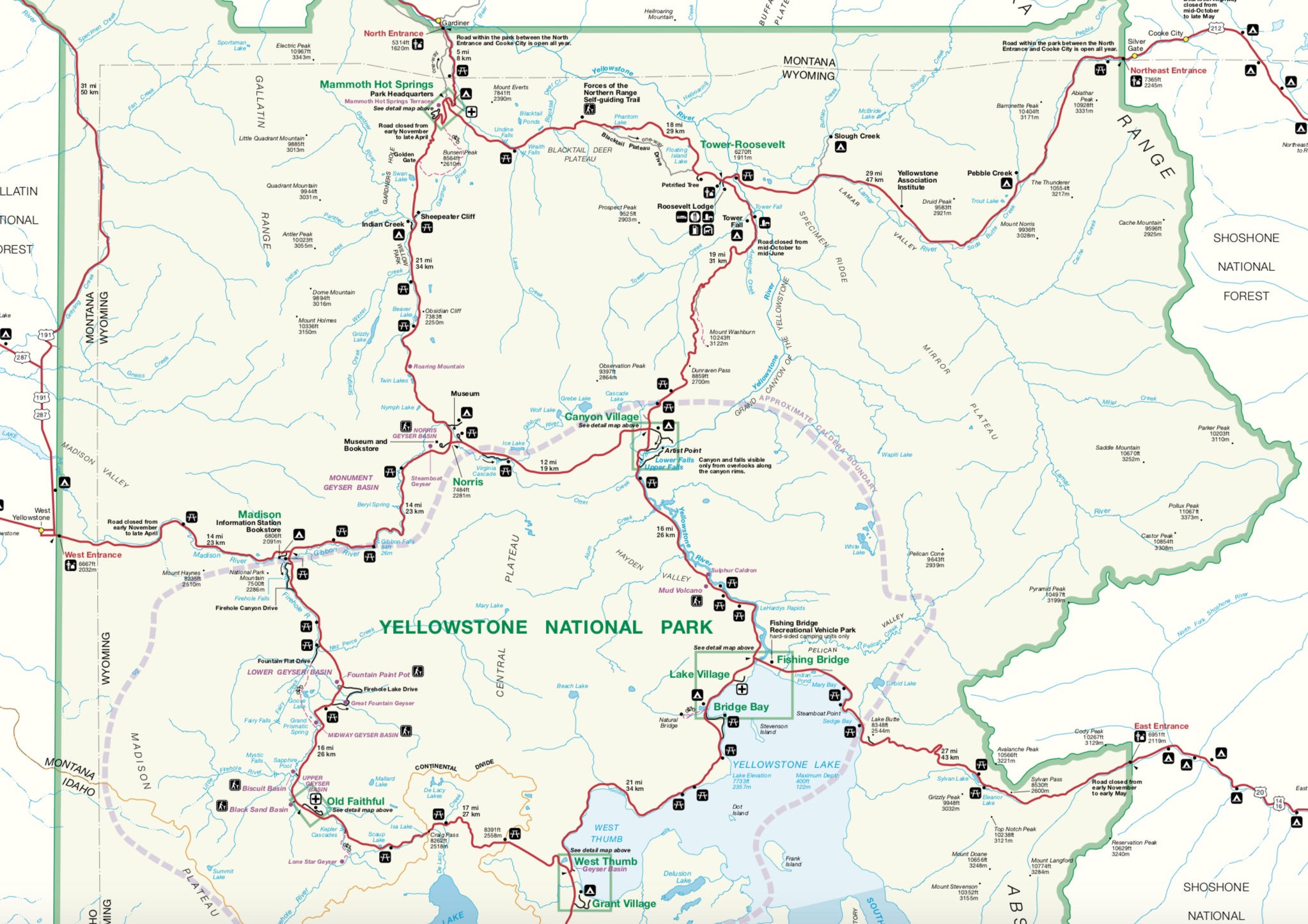 Yellowstone National Park
Yellowstone National ParkYellowstone is huge, covering more than 2.2 million acres. Most of the attractions are on a road pattern shaped like a figure eight. We drove in through the northeast entrance, which is a continuation of the Beartooth Highway. About 25 miles into the park is the turnoff for Slough Creek. If you stay on the highway instead of going to Slough Creek, you reach an intersection at the Tower-Roosevelt area — the top right portion of the figure eight. If you drive south for 20 miles, you will reach Canyon Village, passing Mount Washburn, Dunraven Pass, and the Washburn Hot Springs Overlook. Canyon Village is at the right-middle of the figure 8. If you drive south another 35 miles, you will reach the West Thumb at the bottom right of the figure eight. Much of this drive in this final section is along Yellowstone Lake.
 Beartooth Highway - Photo by William Young
Beartooth Highway - Photo by William YoungFrom the West Thumb, you can drive west about 20 miles and reach the Old Faithful Geyser, which is the biggest tourist attraction in Yellowstone. The geyser erupts about every 60-to-90 minutes, and the park has erected bleachers from which people can watch. From Old Faithful, you can drive north for 30 miles to reach the Norris Geyser Basin, due west of Canyon Village at the west middle of the figure eight. The Norris area has active geysers that periodically erupt. A horrible incident occurred while we were there. When we were returning to our car, we saw one of the rangers running at full speed toward another ranger. After we left, we saw many emergency vehicles speeding in the direction from which we had just come. The next morning, we read that a young man from Oregon fell into one of the hot springs and died. Because the water is so hot, there was no way anyone could rescue him. Visitors are supposed to stay on the boardwalk, and he was 225 yards off of it when he fell in.
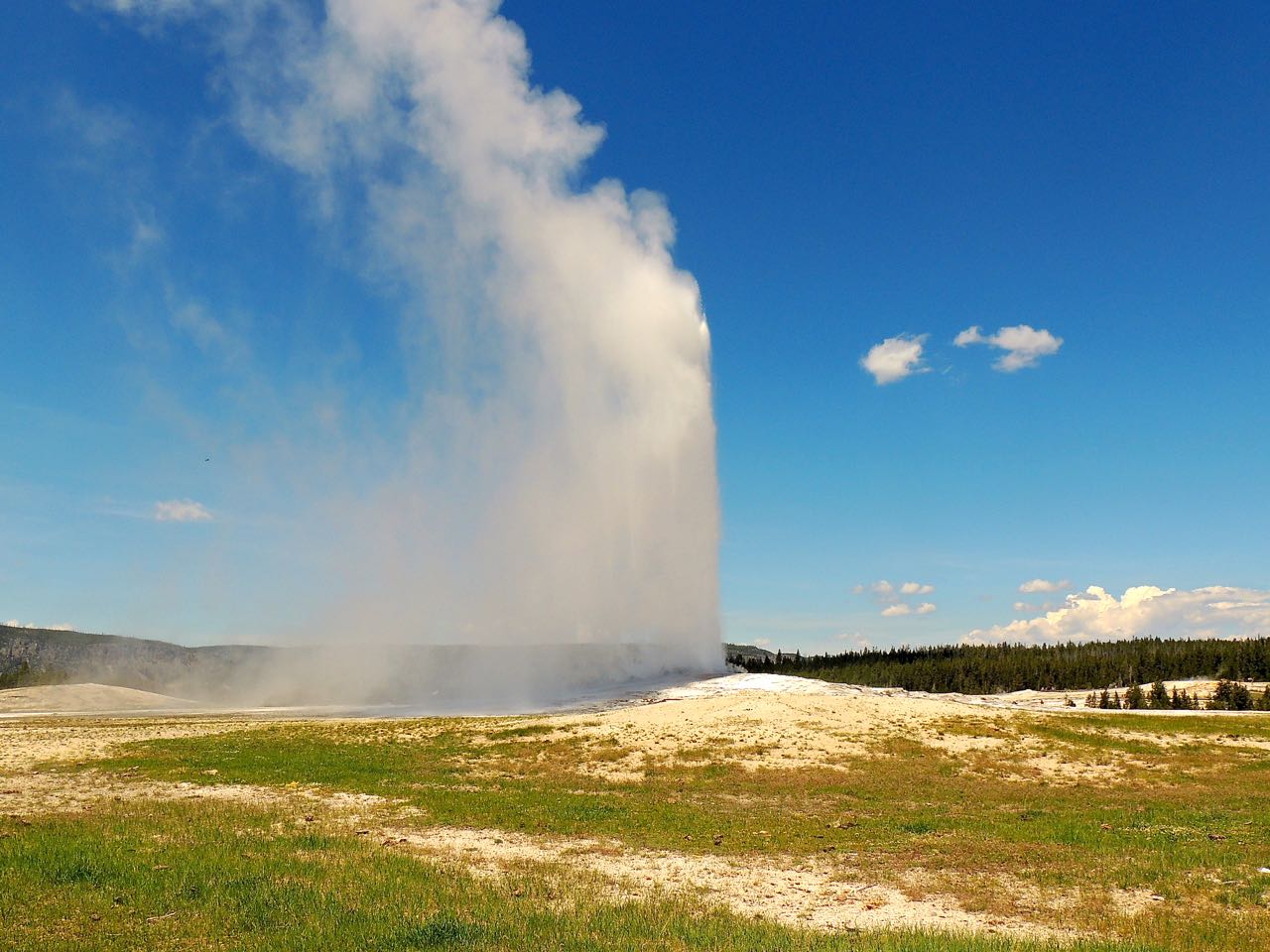 Old Faithful - Photo by William Young
Old Faithful - Photo by William YoungIf you head east from the Norris Geyser, you can see lakes and other attractions on the 12-mile drive to Canyon Village. If you instead head north, you can drive 20 miles toward the Mammoth Hot Springs near the northwest corner of the park, with a lot of wildlife viewing areas along the way. The Albright Visitors Center is near the Mammoth Hot Springs. The springs are worth seeing for their remarkable color and texture. The area around the Mammoth Hot Springs has many hiking trails. We wanted to hike on the Beaver Pond Trail, but it was closed. A few days earlier, a family with children had been there when a bear approached them. To try to distract the bear, the people threw food at it. The rangers were concerned that the bear might be aggressive and think that all humans would throw food, so we had to find a different path.
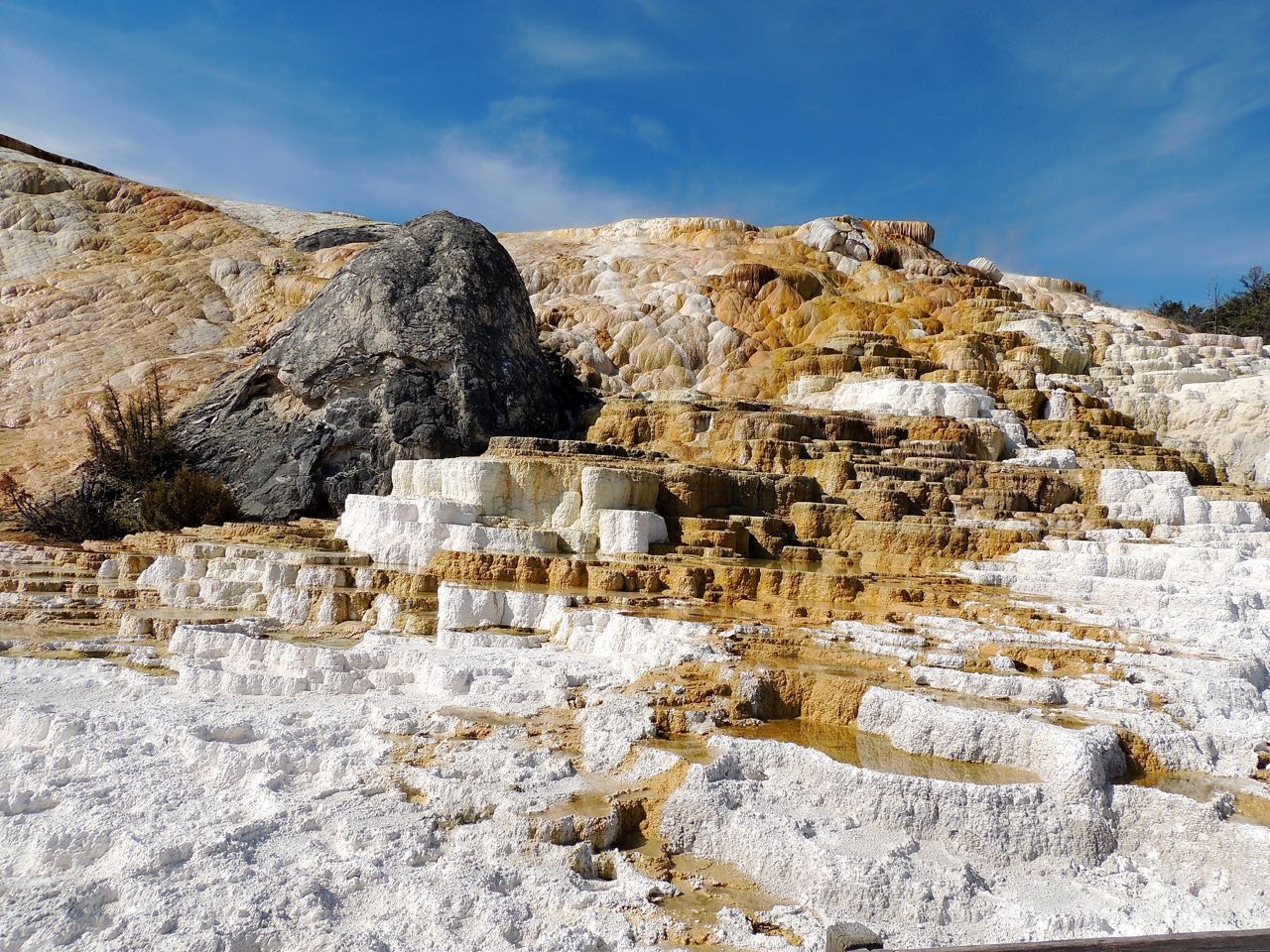 Mammoth Hot Springs - Photo by William Young
Mammoth Hot Springs - Photo by William Young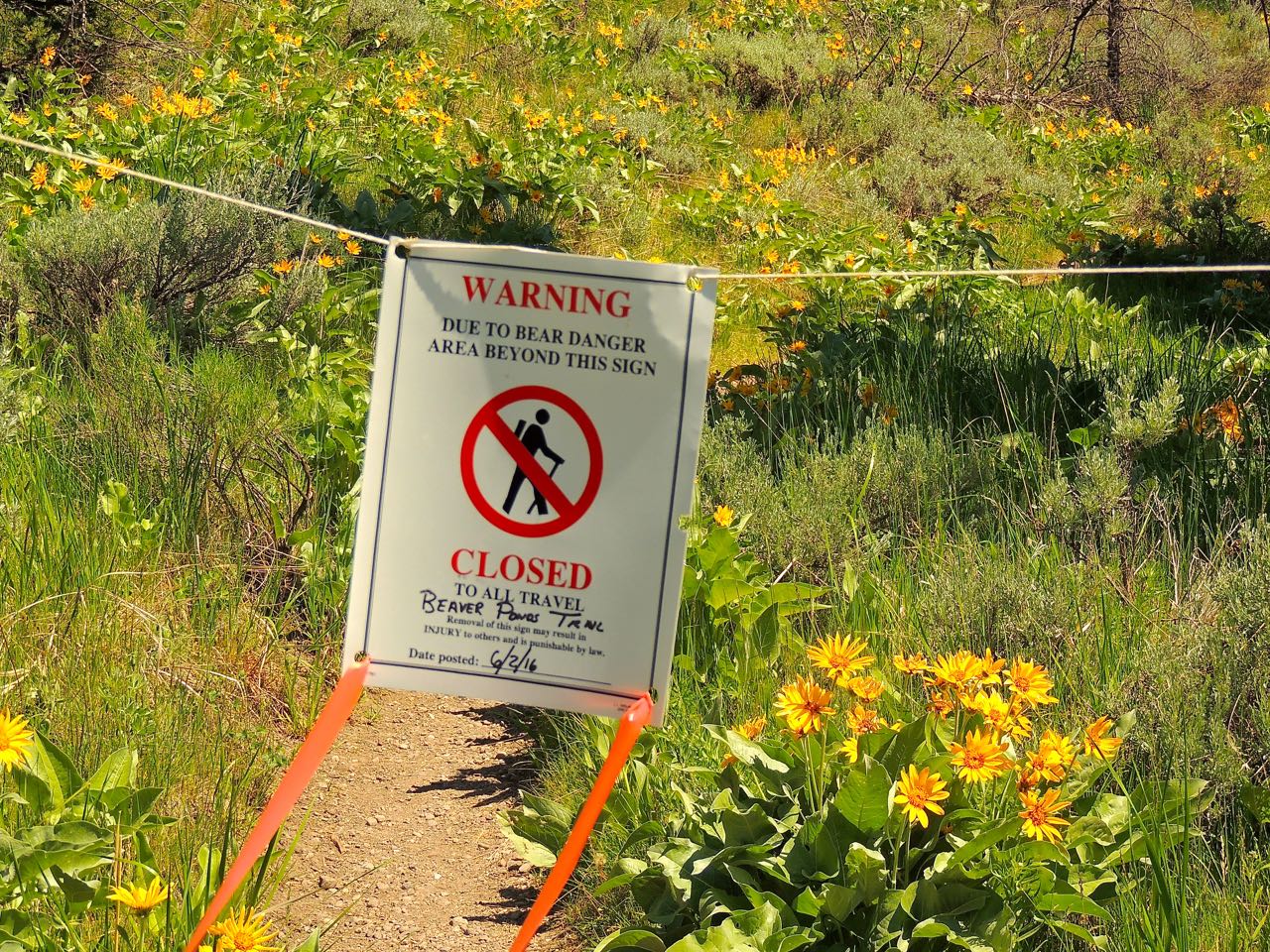 Trail Closure Sign - Photo by William Young
Trail Closure Sign - Photo by William YoungFrom the hot springs, you can either head north to Gardiner, which is about five miles away, or you can drive east for 20 miles to return to Tower-Roosevelt. On the ride back to Tower-Roosevelt, you will pass the Floating Island Lake, Wraith Falls, and a number of other areas with a lot of wildlife.
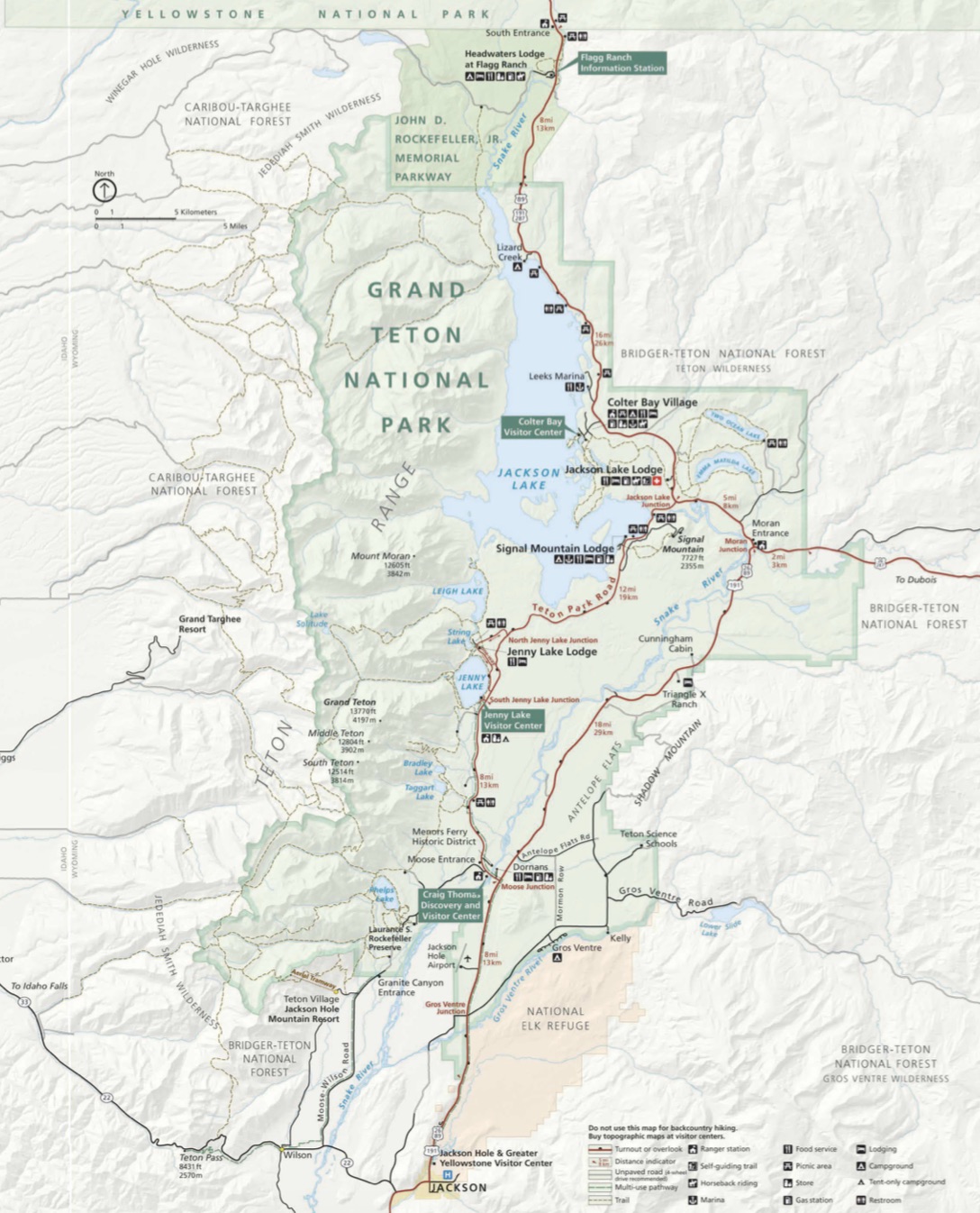 Grand Teton National Park
Grand Teton National ParkGrand Teton National Park is connected to the southern end of Yellowstone and is part of the Greater Yellowstone Ecosystem. It is named for Grand Teton, the tallest mountain in the Teton Range. Jackson, Wyoming, is near the south entrance to the park and the Jackson Hole and Greater Yellowstone Visitors Center. From the West Thumb in Yellowstone to this visitors center is about 80 miles. The drive takes you through gorgeous mountains and past many beautiful lakes, with a lot of side roads to explore. We stopped at both Jackson Lake and Jenny Lake to look around.
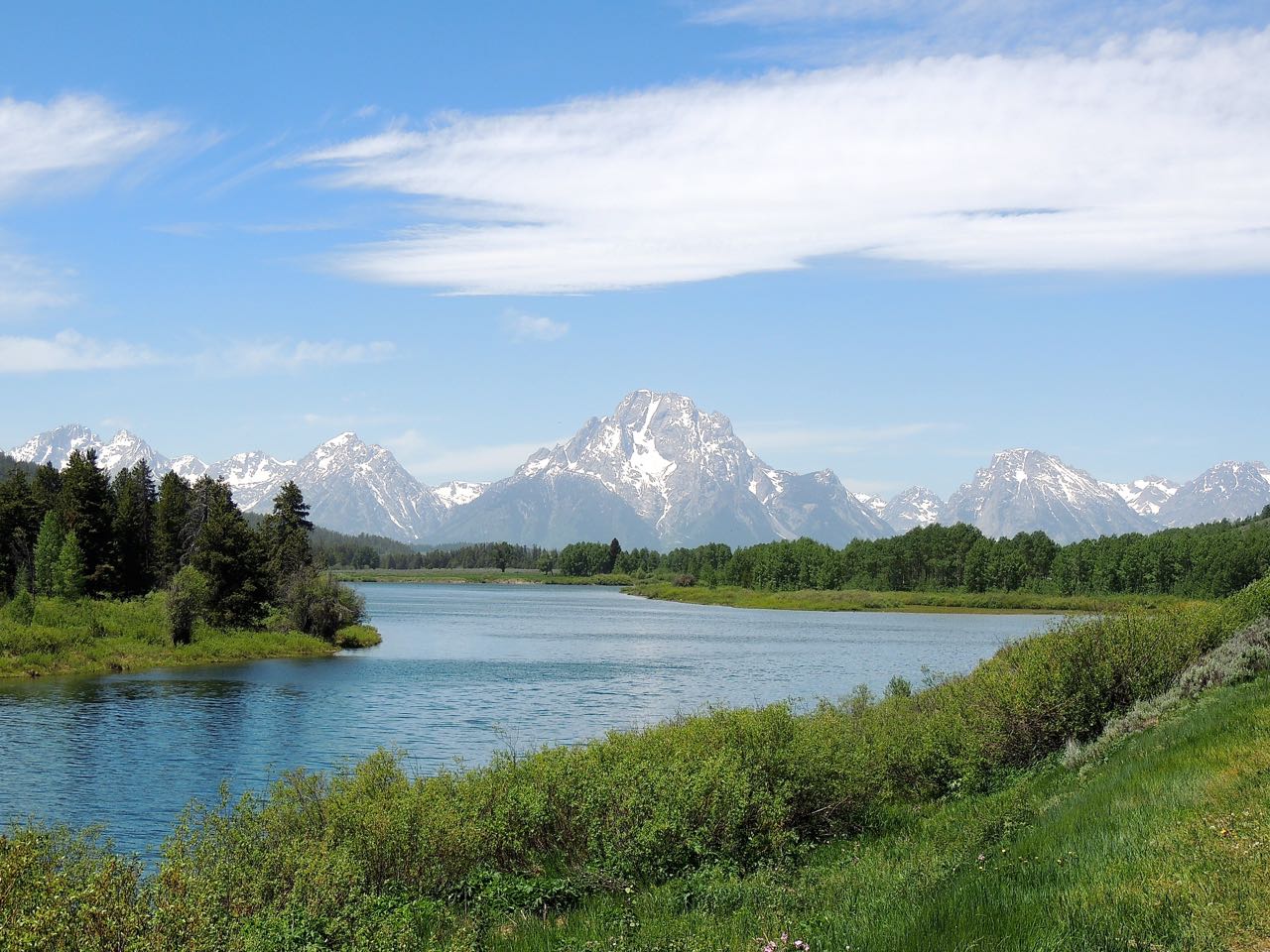 Jackson Lake - Photo by William Young
Jackson Lake - Photo by William YoungWe then went to the village of Moose, about 12 miles north of Jackson, to pick up tickets for a raft trip on the Snake River the following day. A bit north of there is Schwabacher Road, at the end of which was a wetland area with a lot of waterfowl and other birds. Before we took the raft trip, we drove a loop that included stops at Antelope Flats, Mormon Row, and Gros Ventre. In some of these areas, we saw lupines, which are flowers that can withstand the harsh Wyoming climate. They are so named because they were thought to ravenously exhaust the soil, showing lupine (wolf-like) characteristics. I had seen them sixth months earlier when I was in the harsh climate of Ushuaia on the southern tip of Argentina.
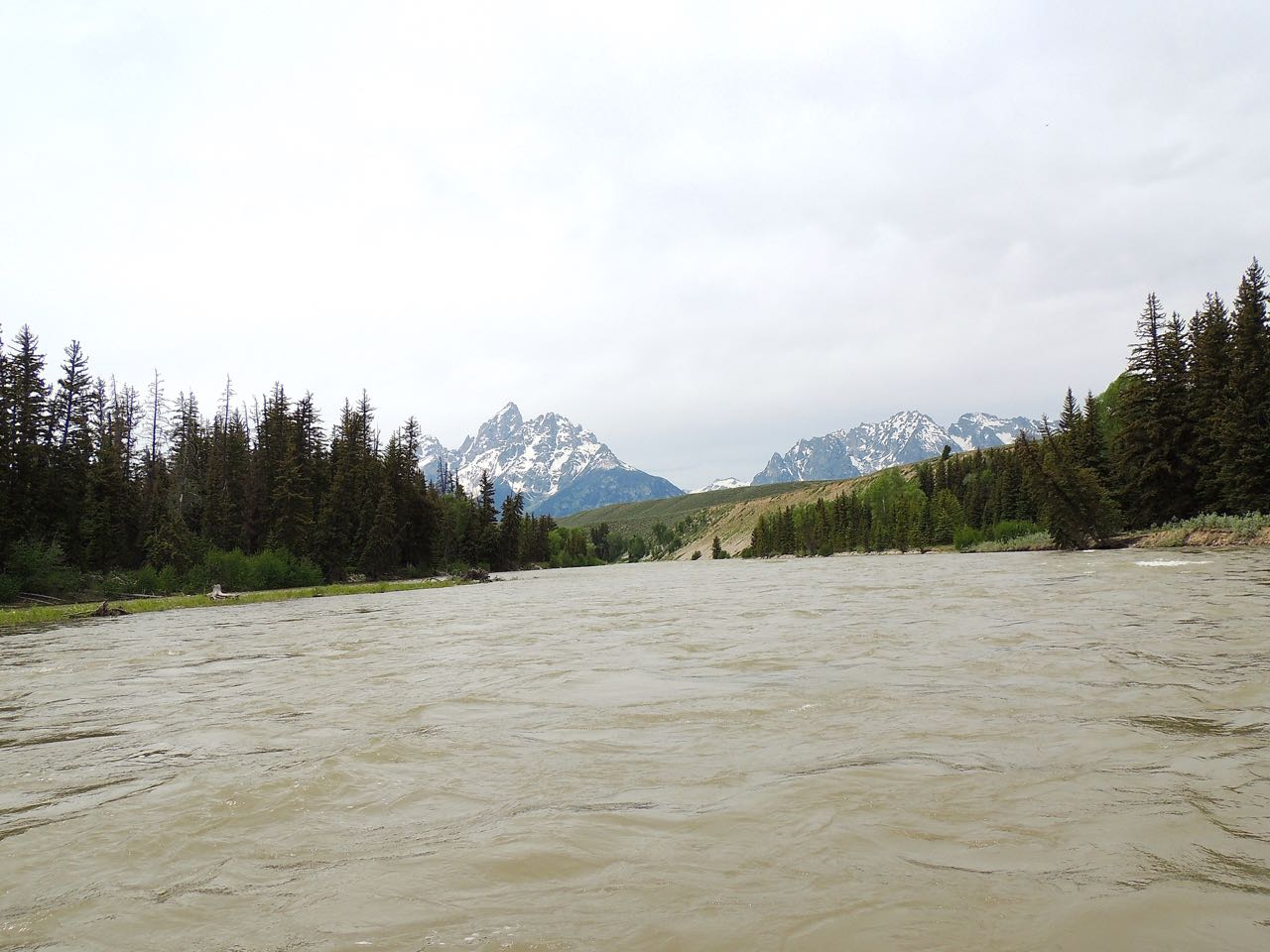 Snake River - Photo by William Young
Snake River - Photo by William Young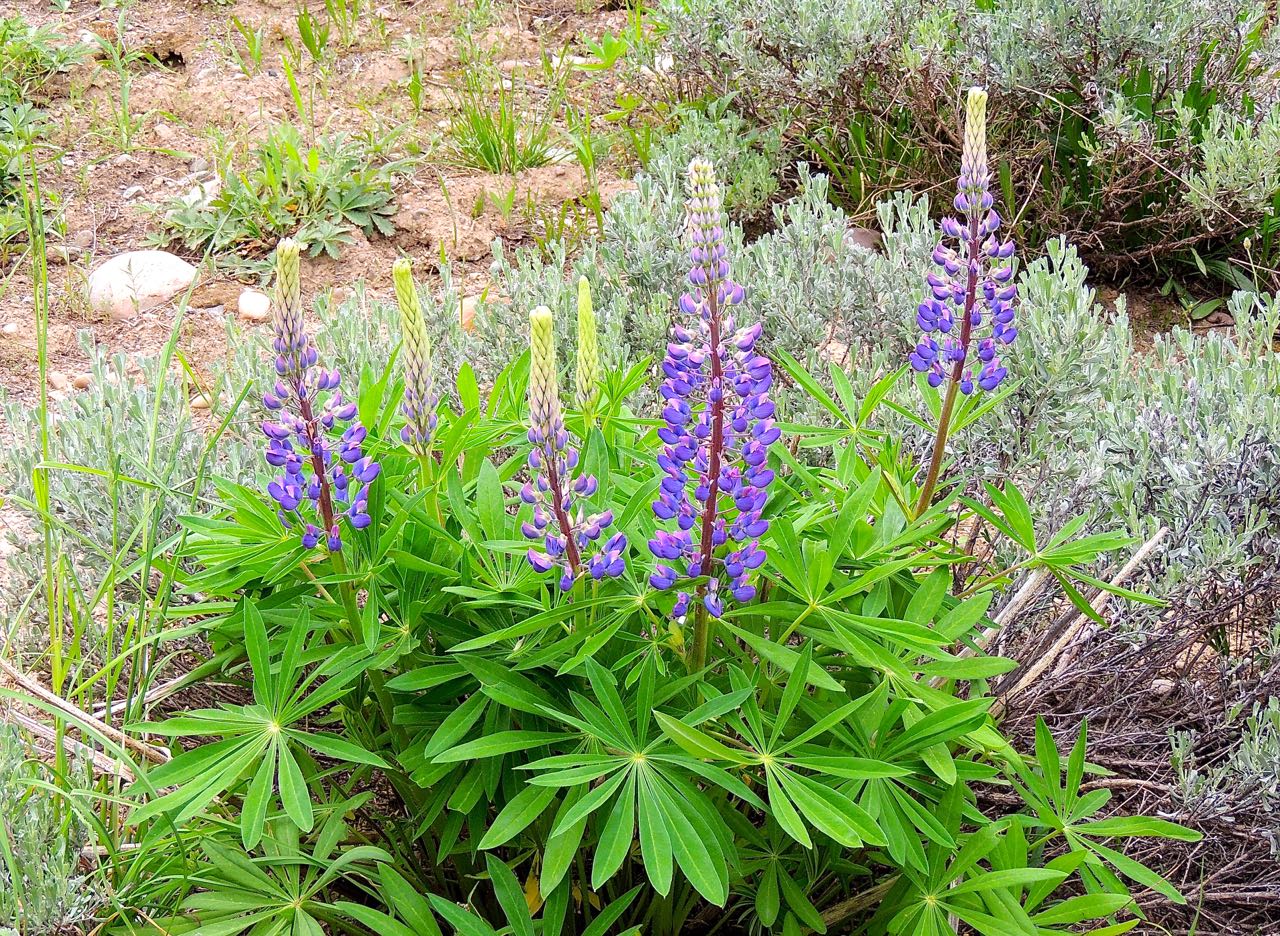 Lupines - Photo by William Young
Lupines - Photo by William YoungThe Tetons have 12 glaciers, and during the raft trip, we saw a few of them. After the trip, we drove to the Laurance S. Rockefeller Preserve, which is on the Moose-Wilson Road. The preserve is well maintained, and we hiked a three-mile loop to Phelps Lake and back. The large lake has the snow-capped Mount Albright in the background.
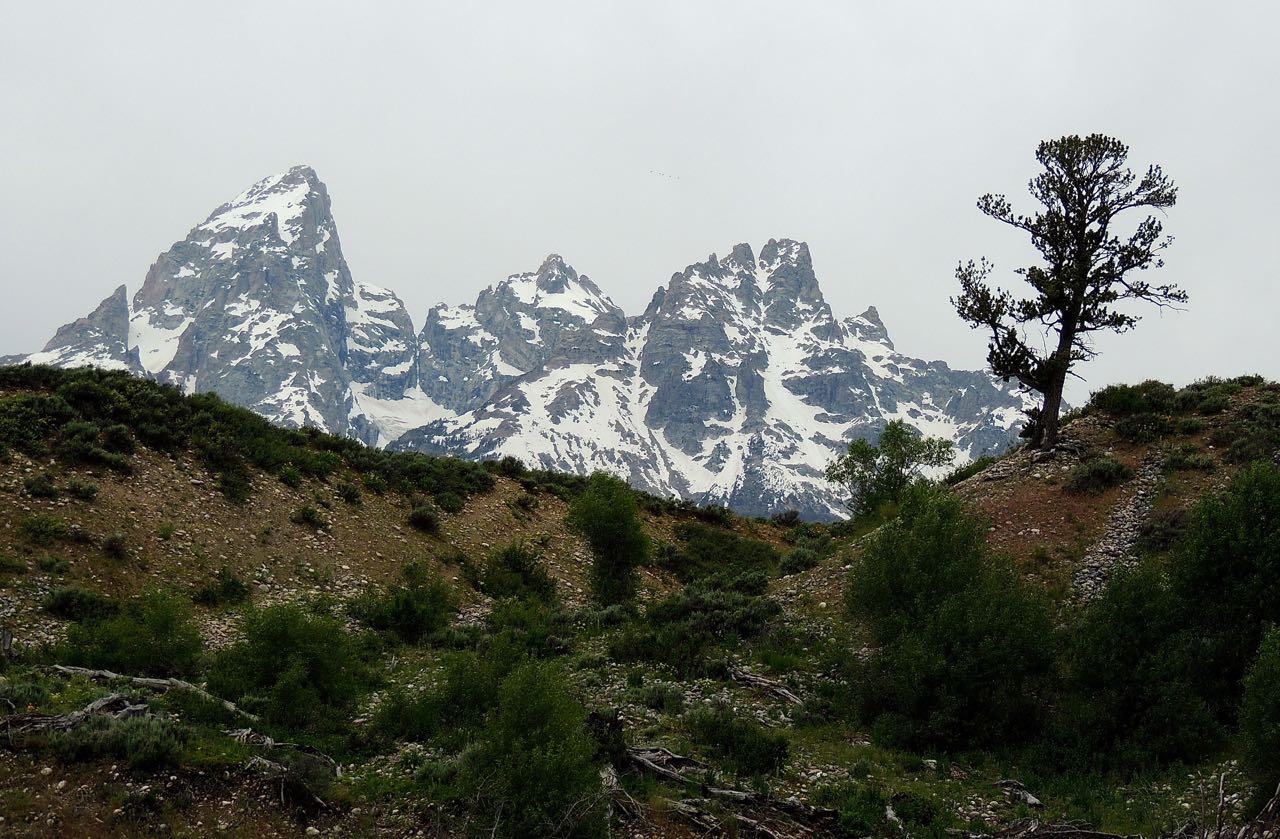 Glaciers in the Teton Range - Photo by William Young
Glaciers in the Teton Range - Photo by William YoungBelow is a summary of some of the wildlife I saw during my trip.
Waterbirds. I saw many waterbirds in numerous locations. Walden Ponds had a lot of White Pelicans, and I saw a few at fairly close range. They are one of the largest North American bird species. I also saw American White Pelicans at Henrys Lake, along with a Caspian Tern.
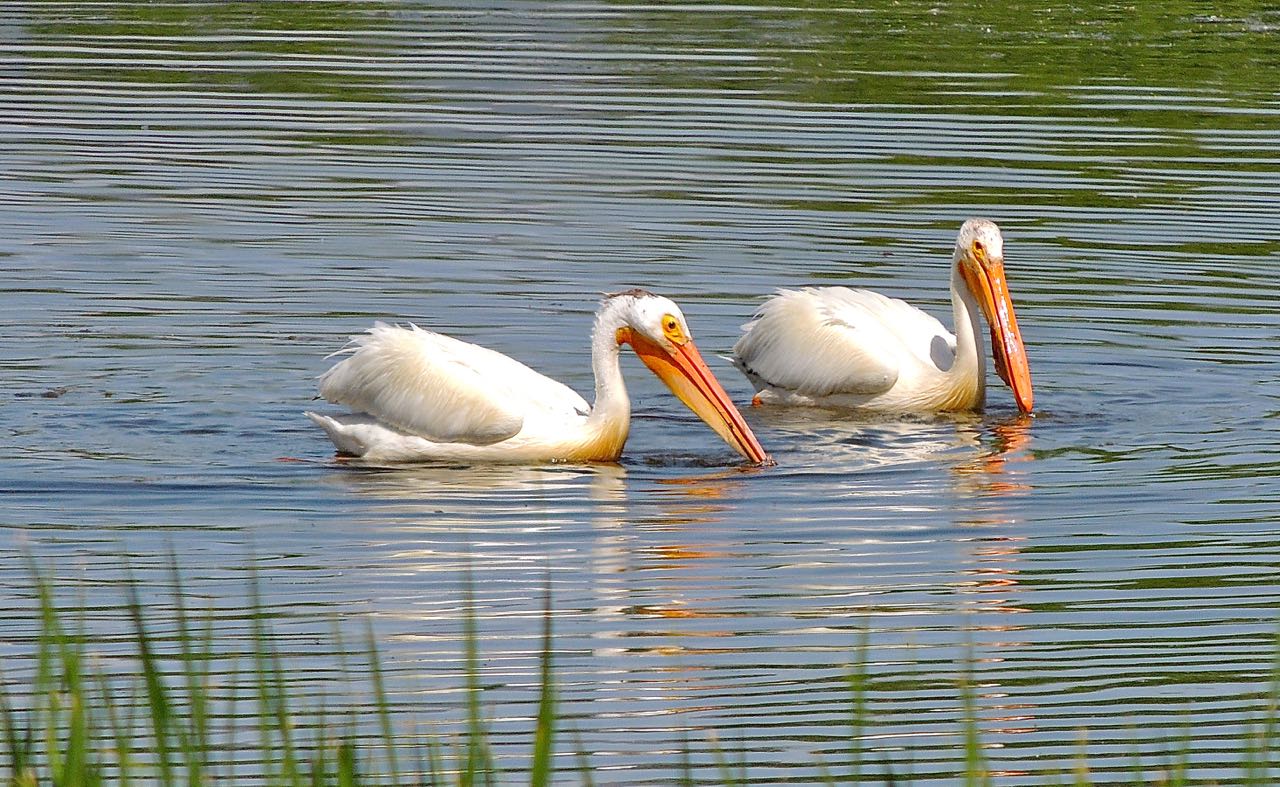 American White Pelicans - Photo by William Young
American White Pelicans - Photo by William Young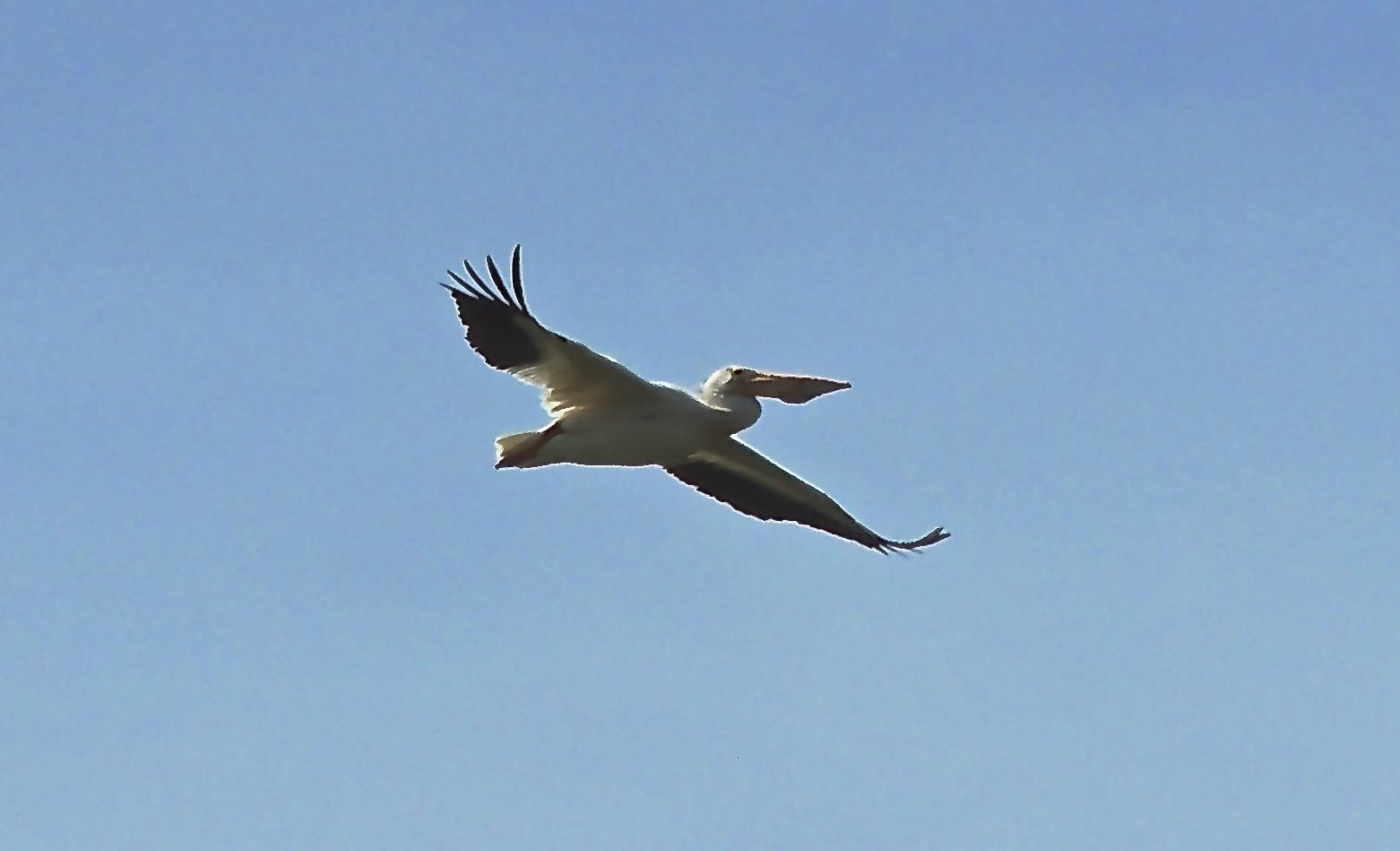 American White Pelican - Photo by William Young
American White Pelican - Photo by William YoungHenrys Lake had breeding plumage Red-necked Grebes and Eared Grebes, a couple of Pied-billed Grebes, and a Western Grebe. It had a quite a few ducks, including Gadwalls, Mallards, Ring-necked Ducks, and Common Mergansers. We drove by the Floating Island Lake in Yellowstone numerous times, and I saw Eared Grebes in breeding plumage each time; they have intense red eyes. Floating Island Lake also had Ruddy Ducks in breeding plumage and a few American Coots.
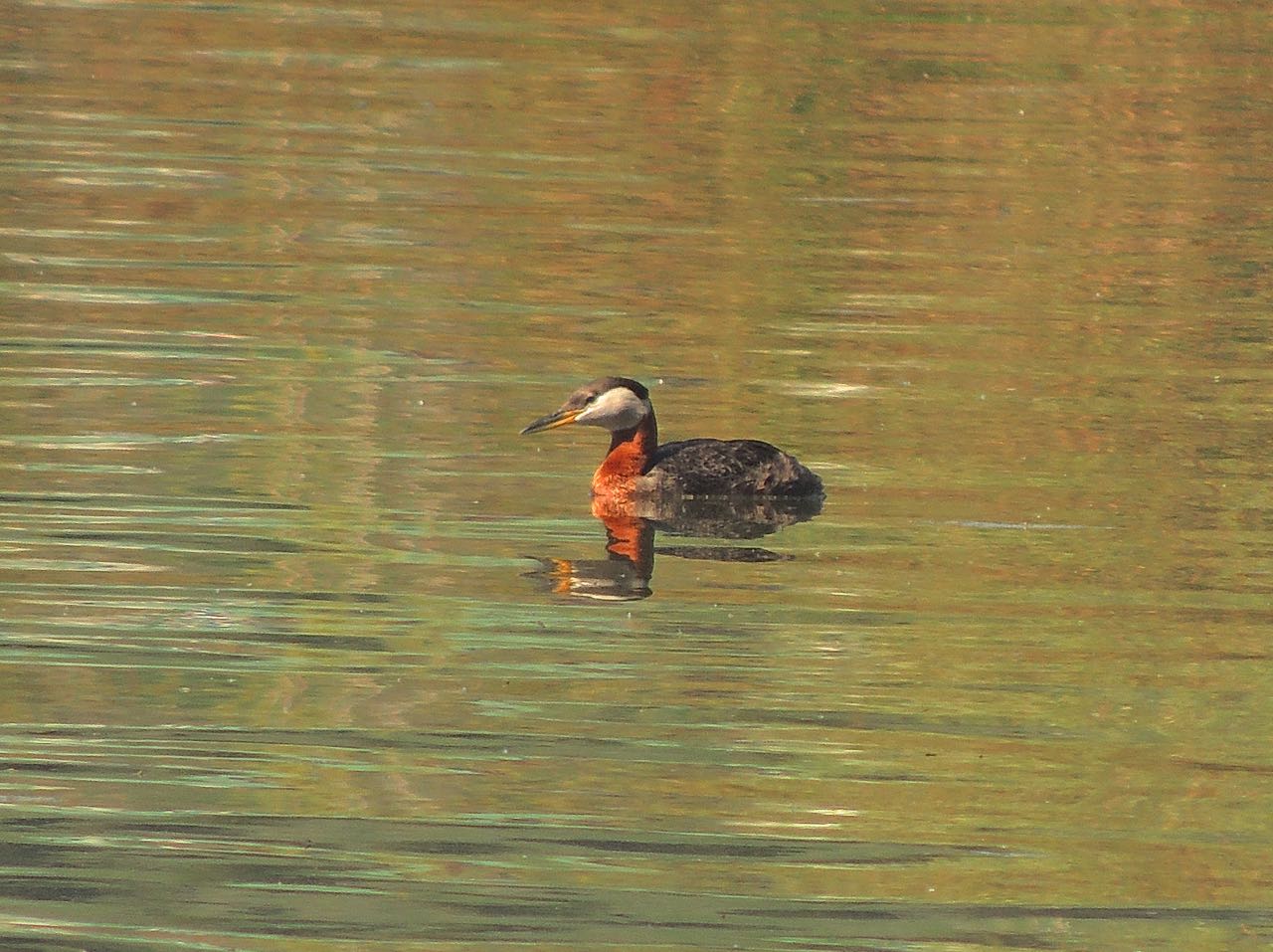 Red-necked Grebe - Photo by William Young
Red-necked Grebe - Photo by William Young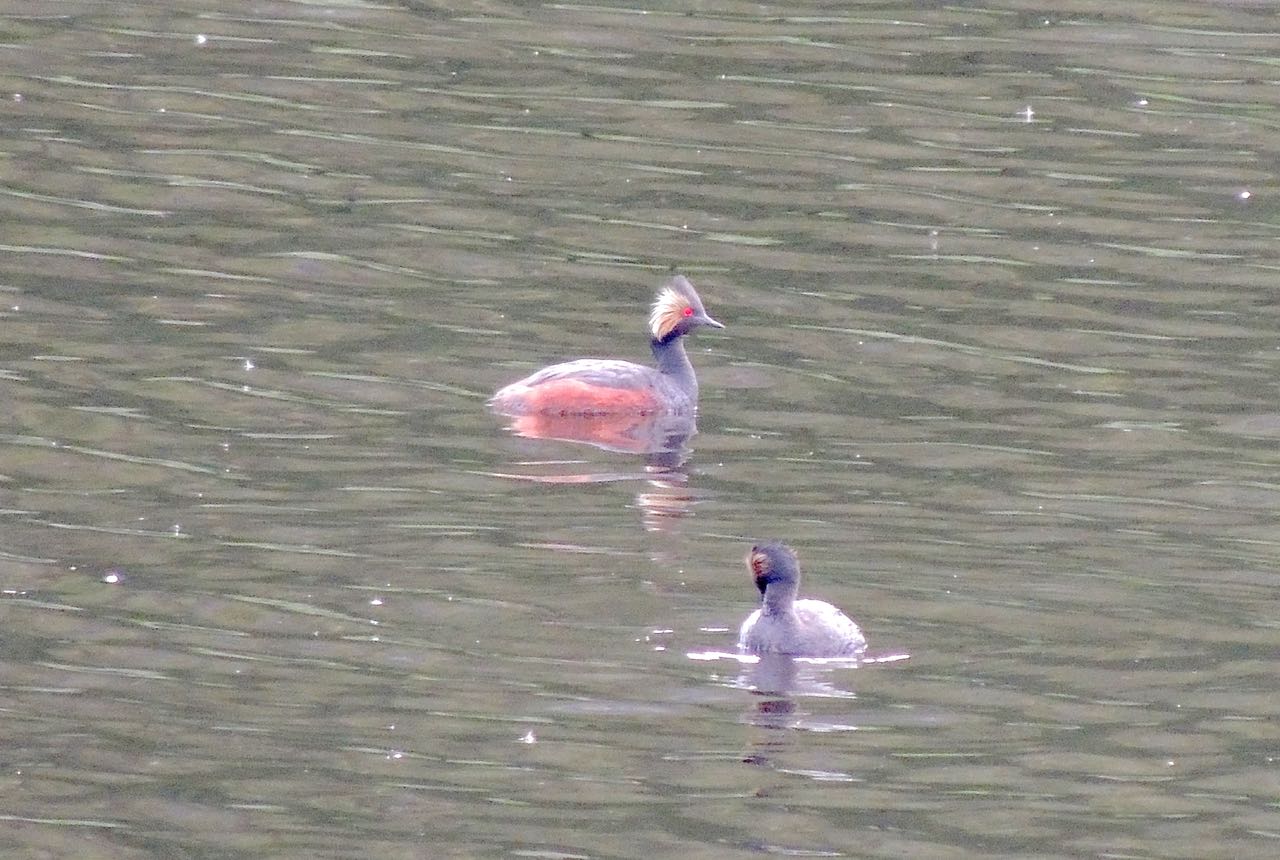 Eared Grebes - Photo by William Young
Eared Grebes - Photo by William Young Western Grebe - Photo by William Young
Western Grebe - Photo by William YoungIn other areas in Yellowstone, I saw Cinnamon Teals, Barrow's Goldeneyes, Buffleheads, and American Wigeon. In the wetlands at the end of Schwabacher Road, I saw American Wigeons and Barrow's Goldeneyes, along with a Spotted Sandpiper. I saw a lot of Spotted Sandpipers on the raft trip down the Snake River. The only plovers I saw were some Killdeers at the Mammoth Hot Springs, including a few chicks who appeared to have hatched recently.
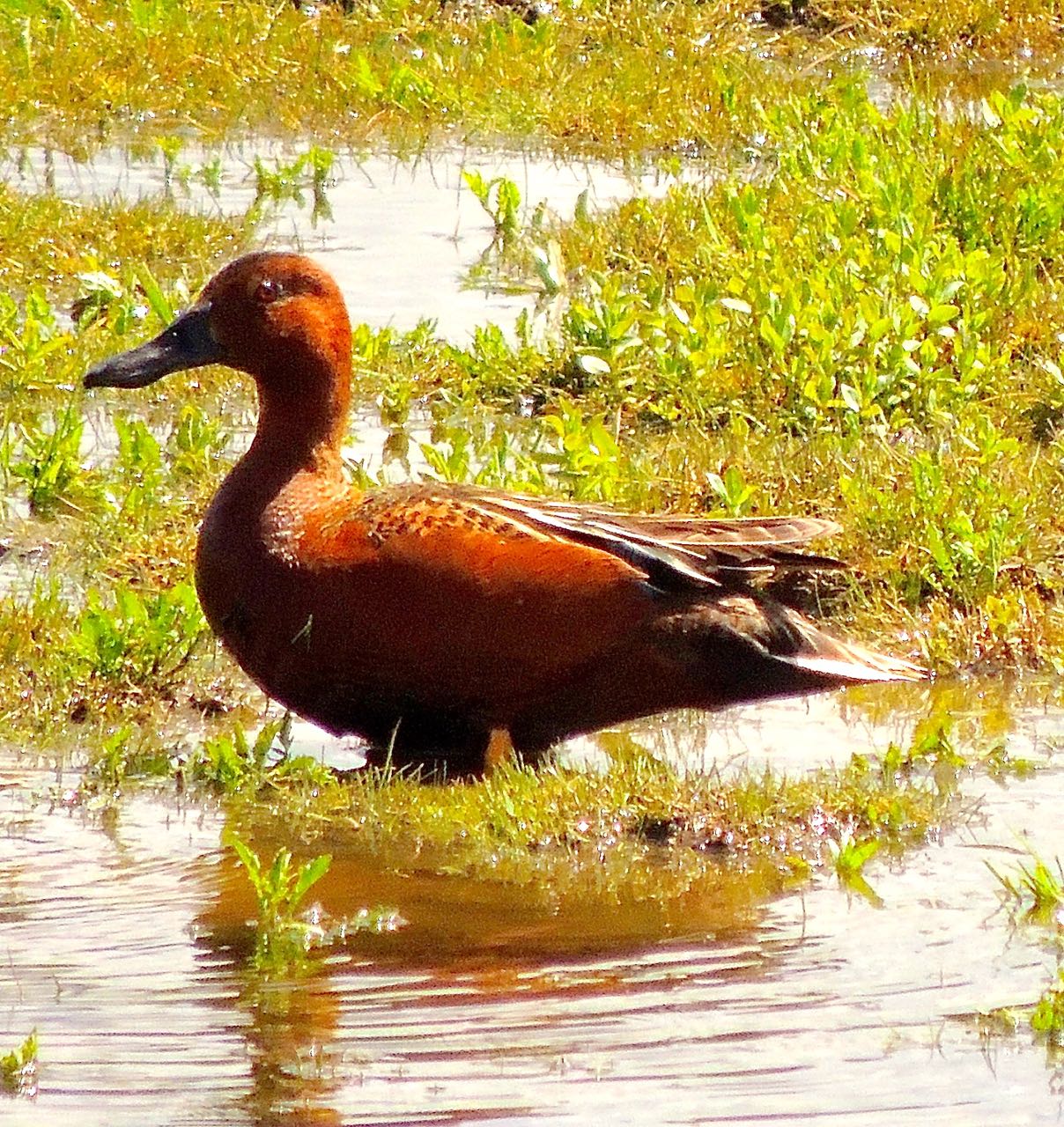 Cinnamon Teal - Photo by William Young
Cinnamon Teal - Photo by William Young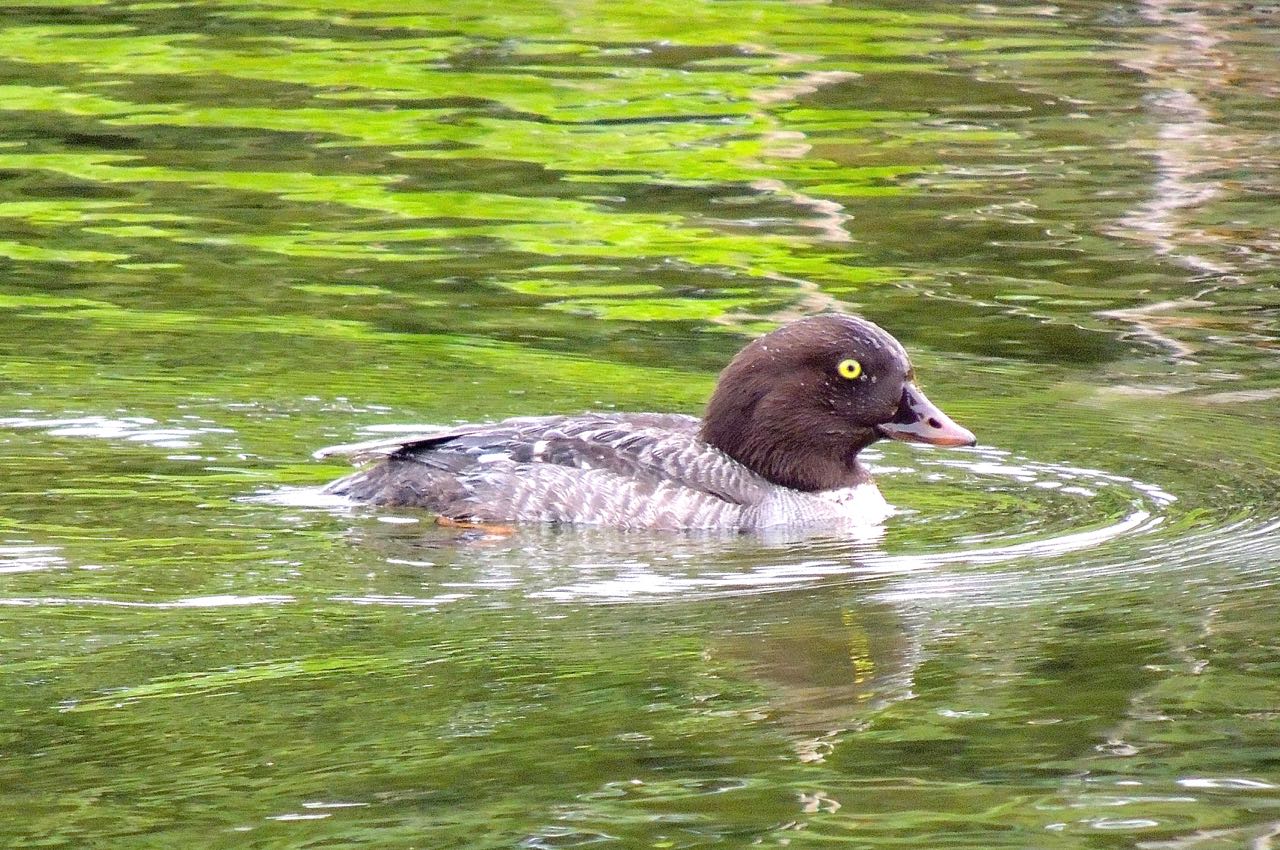 Barrow's Goldeneye - Photo by William Young
Barrow's Goldeneye - Photo by William Young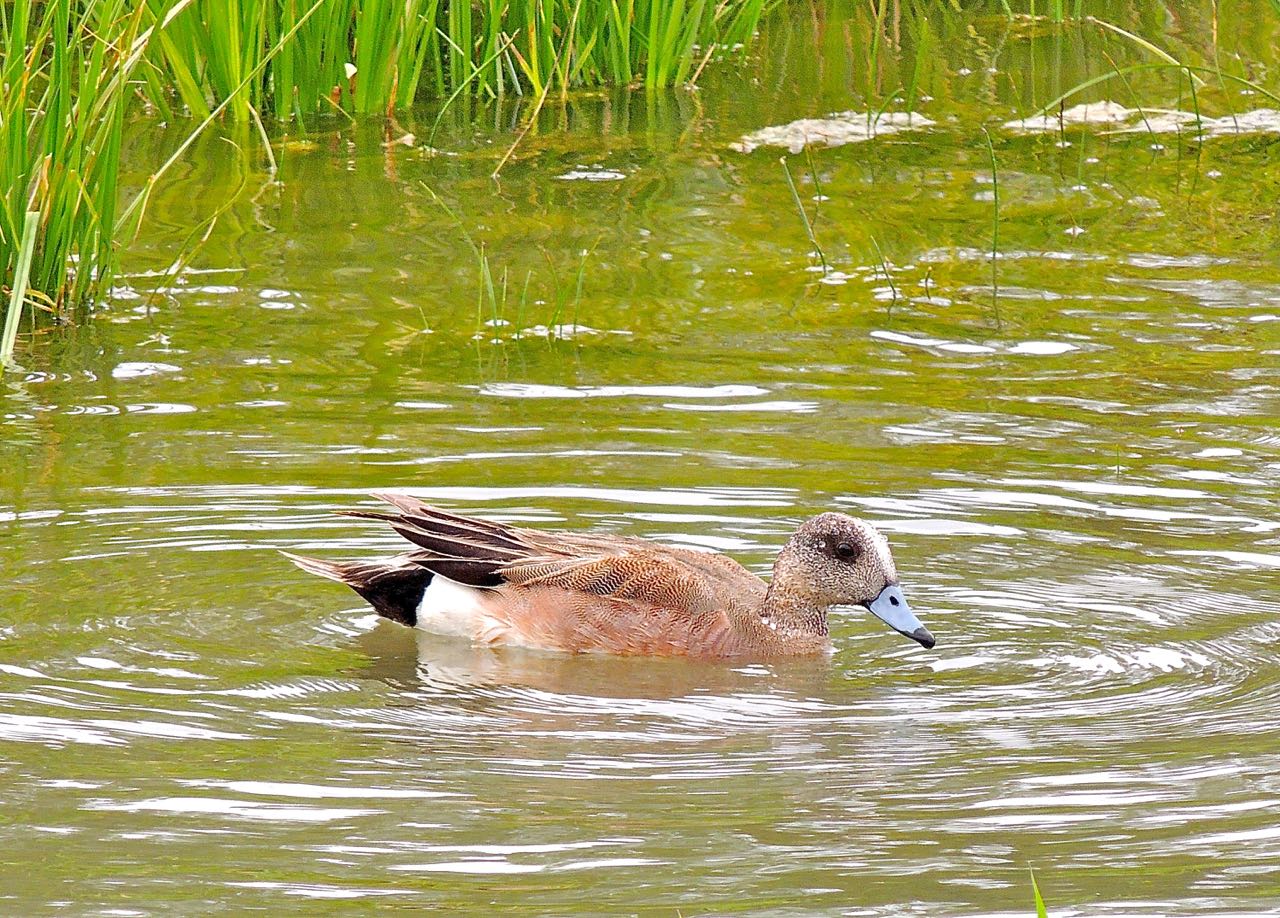 American Wigeon - Photo by William Young
American Wigeon - Photo by William Young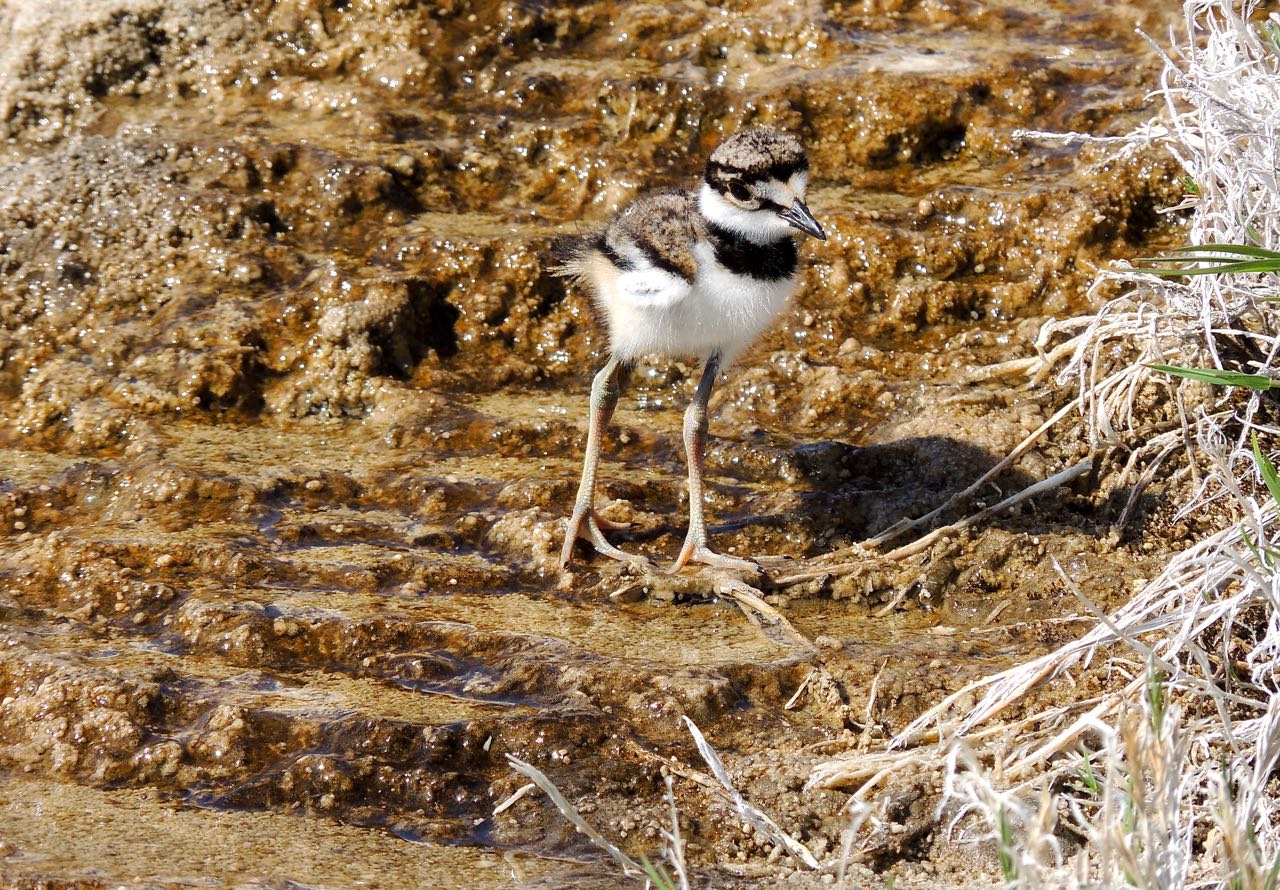 Baby Killdeer - Photo by William Young
Baby Killdeer - Photo by William YoungIn the fast running water near Dunraven Pass, north of Canyon Village, were a few Harlequin Ducks. They came out of the water and stood on rocks not far from the shore.
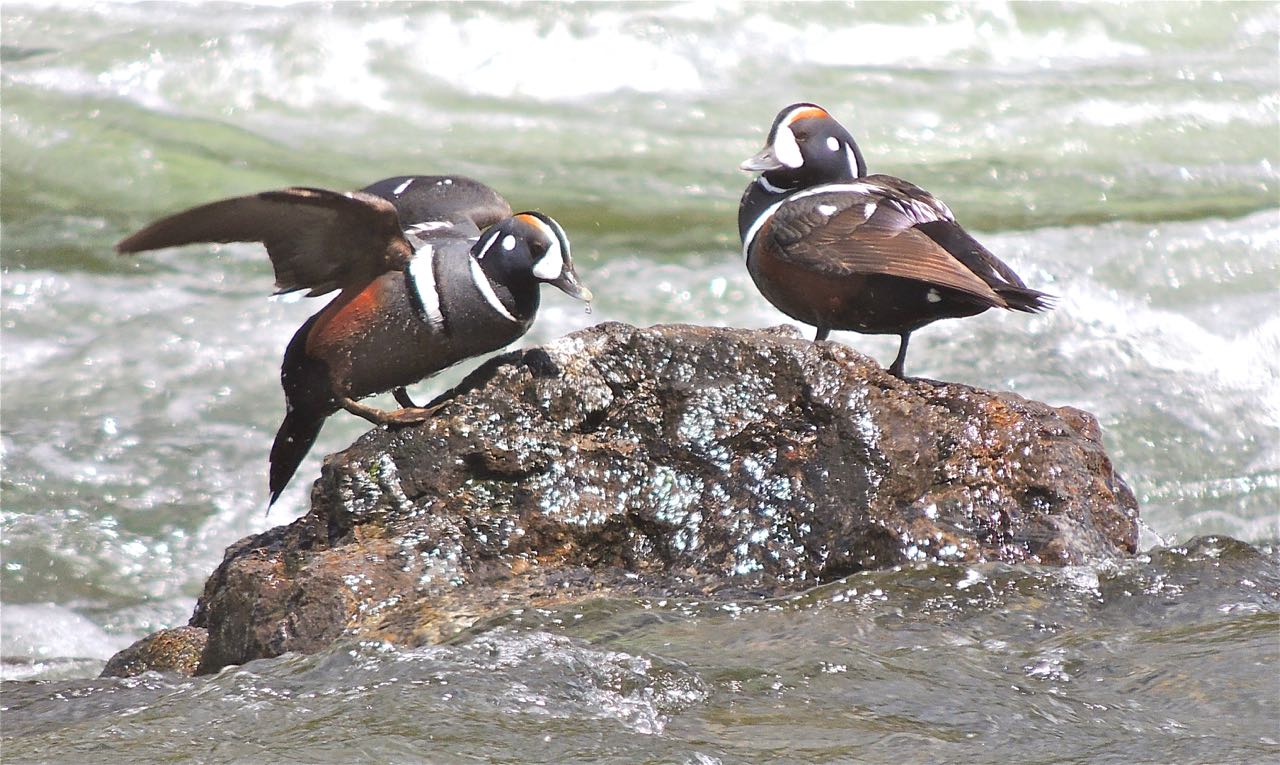 Harlequin Ducks - Photo by William Young
Harlequin Ducks - Photo by William YoungSouth of the Mammoth Hot Springs were two young Sandhill Cranes. One of them was standing in a field when a Grizzly Bear sow walked behind it.
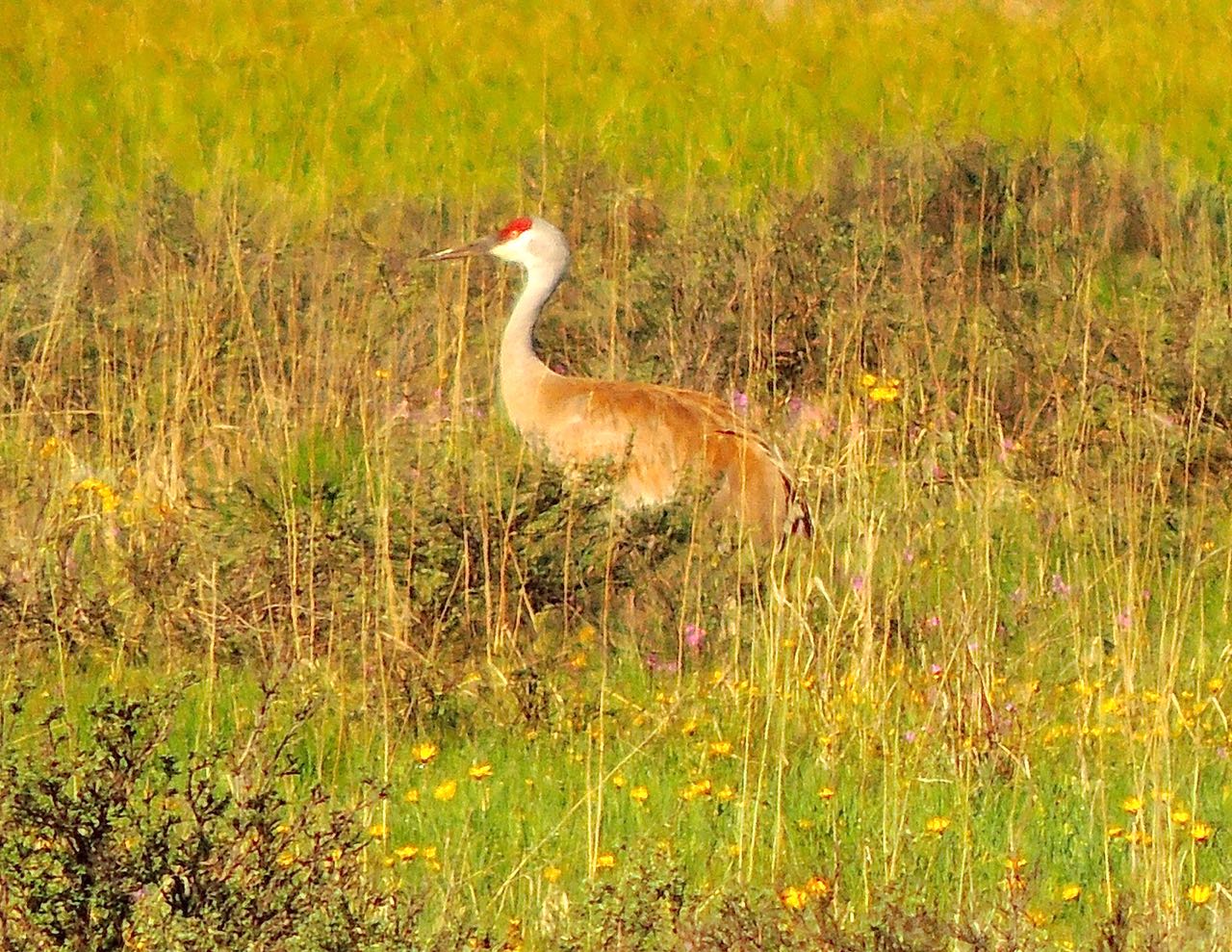 Sandhill Crane - Photo by William Young
Sandhill Crane - Photo by William YoungWe stopped at a place called Swan Lake and saw two Trumpeter Swans, who are one of the special waterfowl species at Yellowstone. Trumpeter Swans were critically endangered during the 20th century, but they have since made somewhat of a recovery. All of the ones I saw wore large bands so that they could be identified from a distance. Usually, swans float and reach their long neck down to eat submerged vegetation. These swans stood in shallow water and did the same thing, which looked odd. We saw a couple more at the South Twin Lake, a little further down the road.
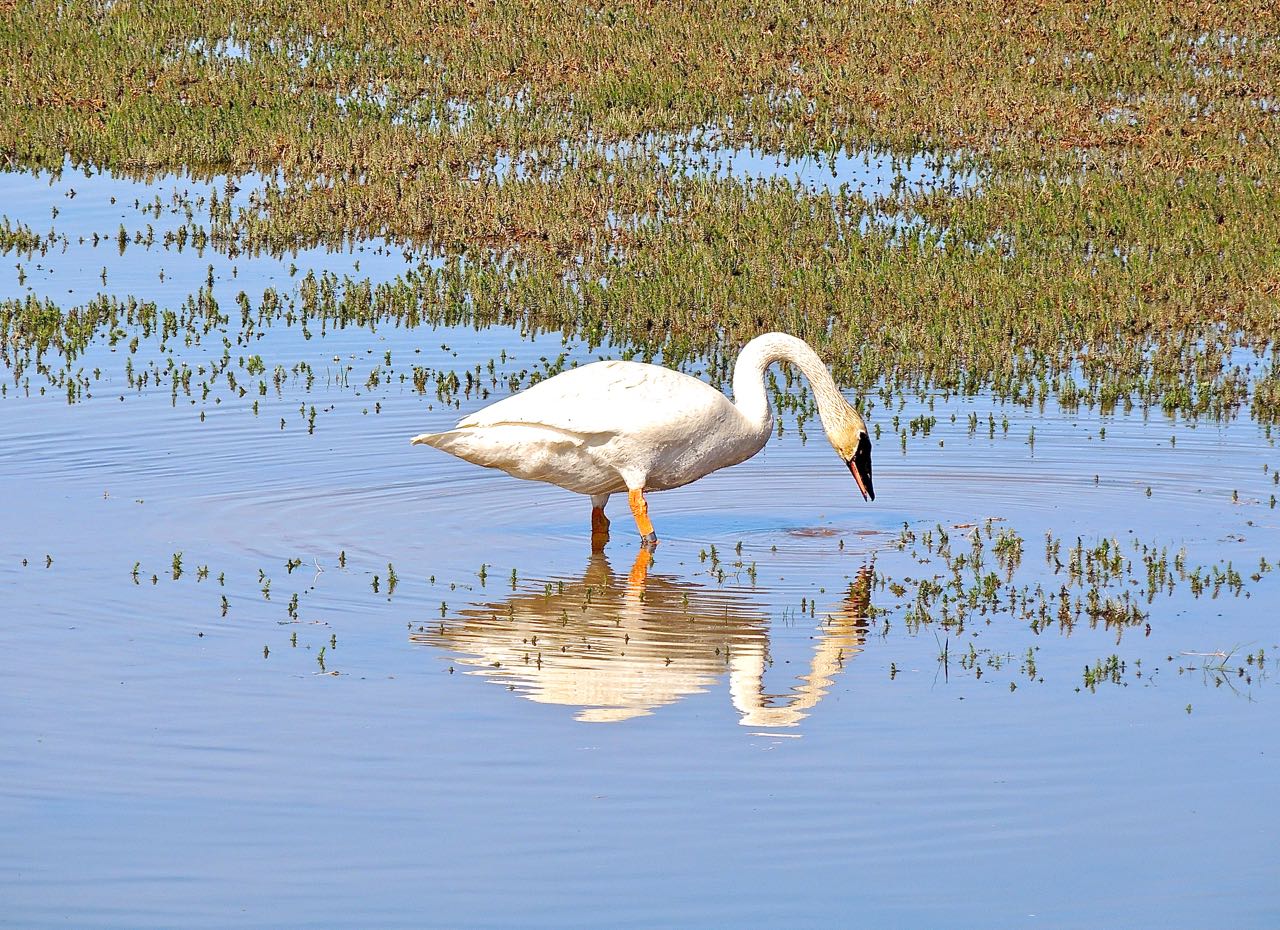 Trumpeter Swan - Photo by William Young
Trumpeter Swan - Photo by William Young
Hawks and Owls. I did not see many raptors on the trip. I saw three Bald Eagles on the Snake River raft trip. I saw a couple of Ospreys in a spectacular nest. Canyon Village is named for its proximity to the Grand Canyon of the Yellowstone, which is 800 to 1,200 feet deep and from 1,500 to 4,000 feet wide. The canyon has a rushing river with waterfalls, and it has a beautiful variety of colors and textures resulting from the lava rock which contains various iron compounds. In the middle of all this is a huge stone pedestal with an Osprey nest on top. This must be one of the most breathtaking backdrops for any Osprey nest in the world.
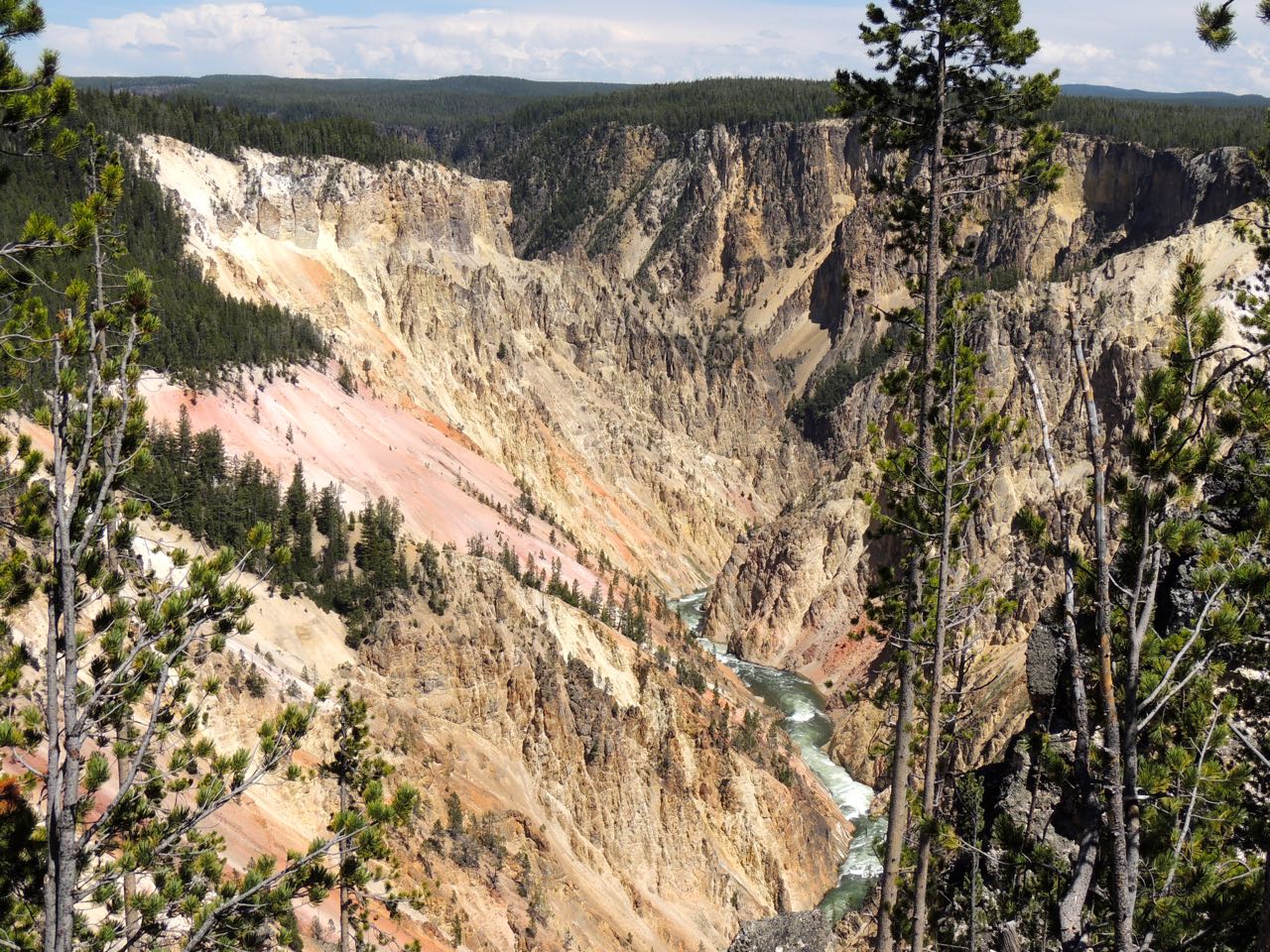 Grand Canyon of the Yellowstone - Photo by William Young
Grand Canyon of the Yellowstone - Photo by William Young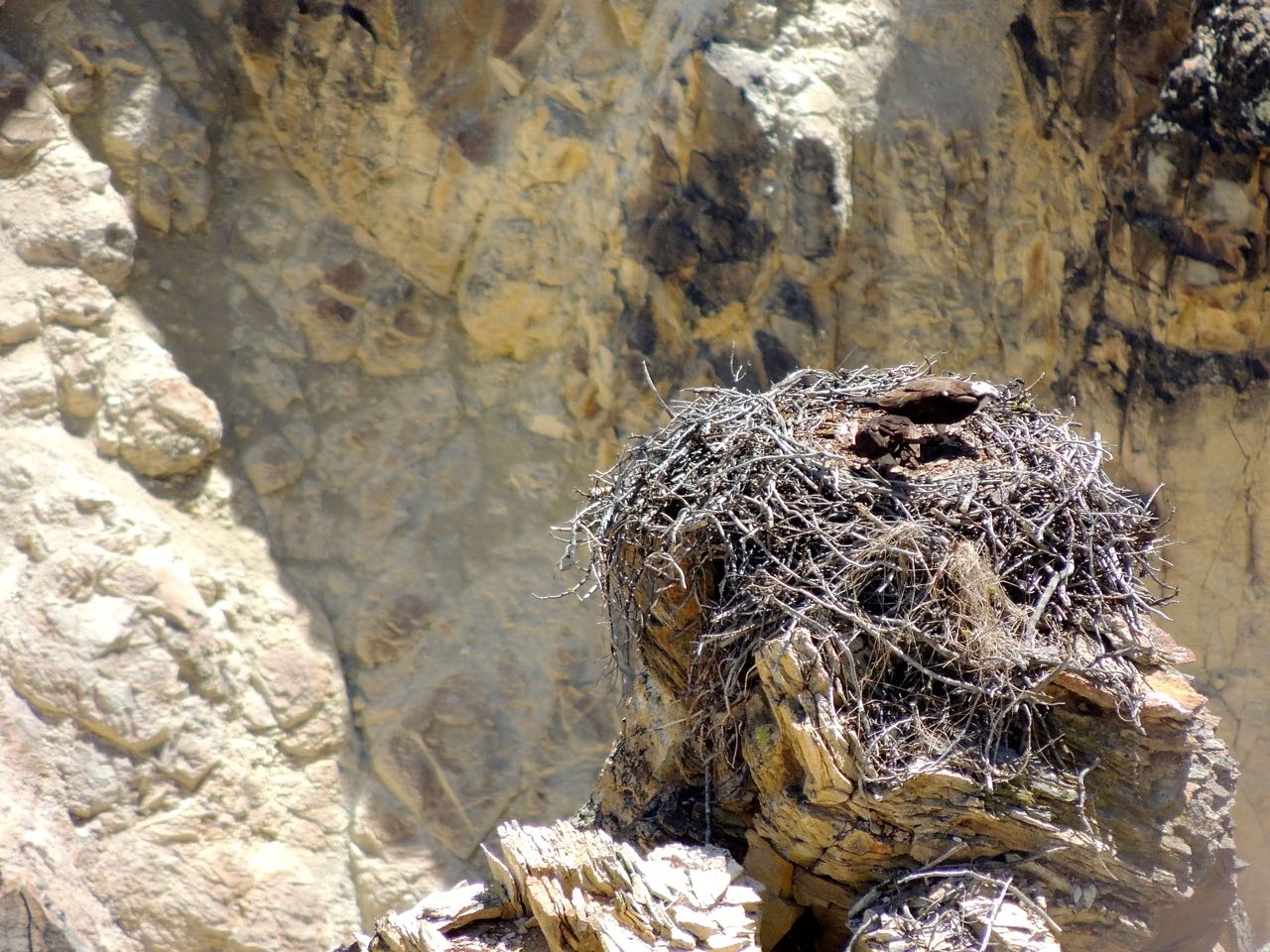 Osprey Nest - Photo by William Young
Osprey Nest - Photo by William YoungWe had good luck with owls. On our first day at Yellowstone, we saw a Great Gray Owl nest with three owlets in the crevice of a rock face on the north portion of the park. The nest was far away, but I could see the owlets with a telescope. Behind the Albright Visitors Center at the northwest entrance, we saw two Great Horned Owlets under the eaves of one of the buildings. I also saw one of the adult owls. Our motel in Gardiner was not very far from the visitors center, which allowed us to check on the owls frequently as we travelled in and out of the park. One day, we saw one of the owlets on the roof of the visitors center. The owlet was learning to fly, and it tried to jump from the roof to a nearby pine tree. It missed its intended perch and tumbled to the ground right in front of us. After gathering its composure, it flew to an area on the other side of the building and landed on an island of grass near where elks were grazing. The next day, we saw both owlets in a tree, while an adult was on the roof of a nearby building. The adult flew to the other end of the roof, and she had a rodent in her mouth — I think it was a pocket gopher. She then flew to the tree where the owlets were and gave the gopher to one of them. Great Horned Owls do not rip apart their food as hawks do, and instead, swallow it whole.
 Great Gray Owl Nest - Photo by William Young
Great Gray Owl Nest - Photo by William Young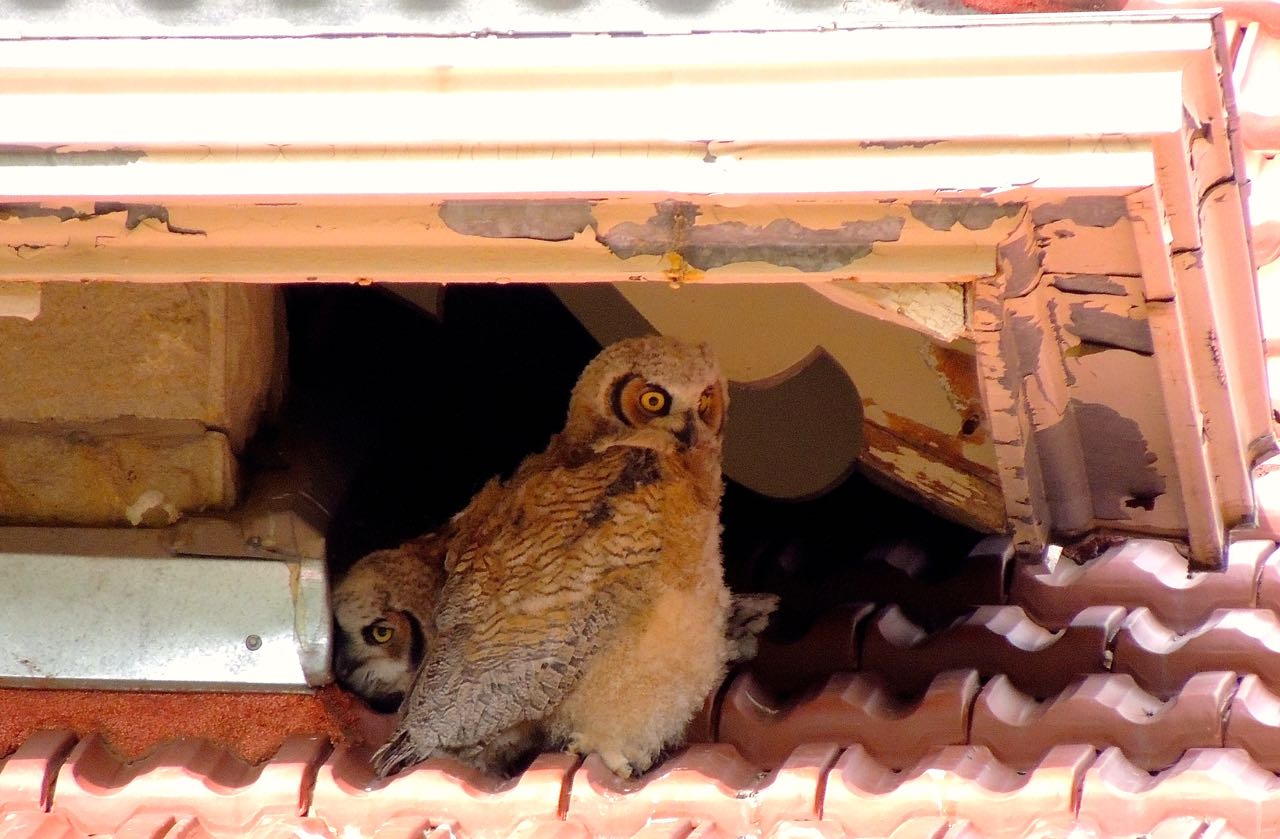 Great Horned Owlets - Photo by William Young
Great Horned Owlets - Photo by William Young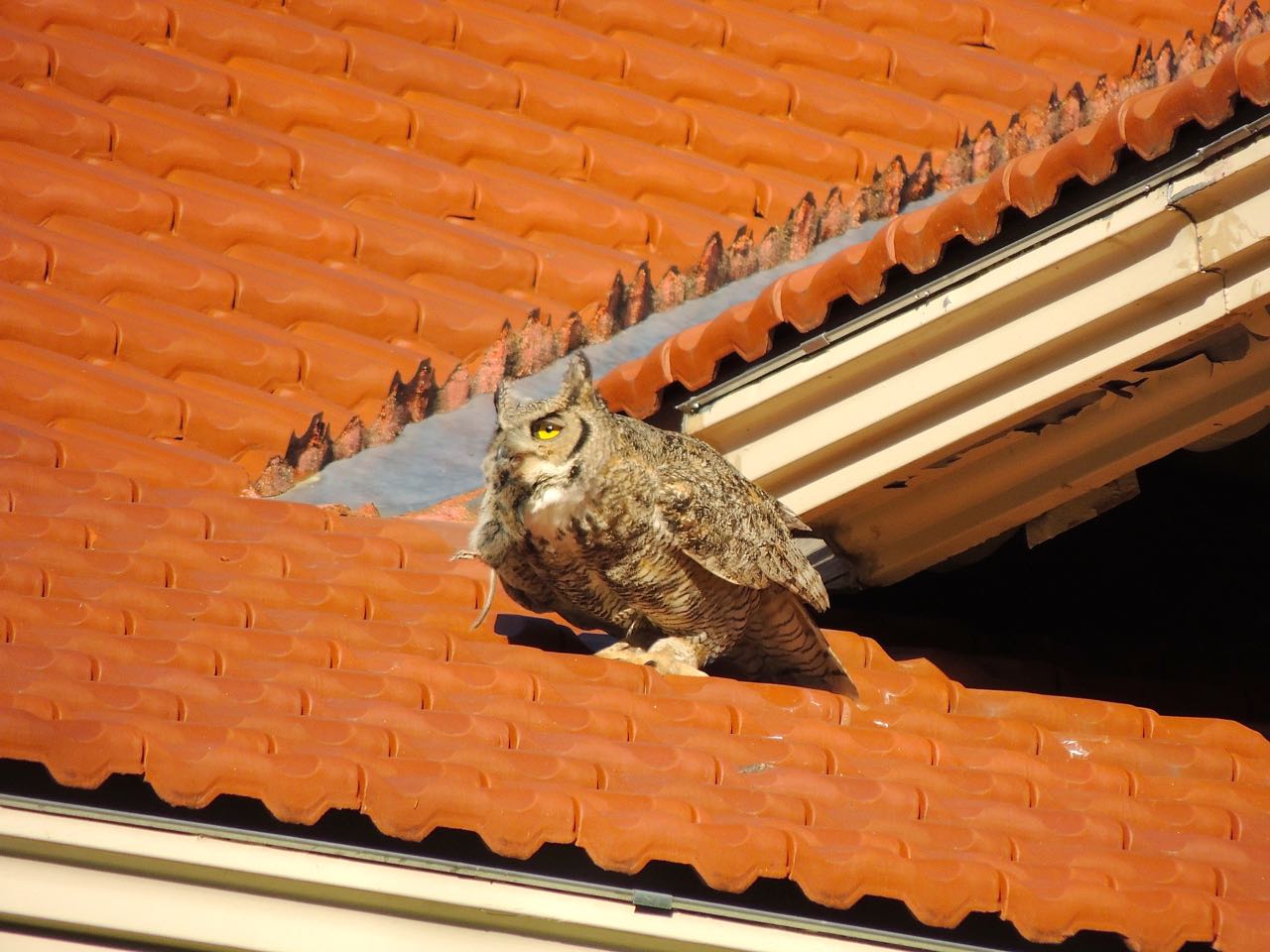 Great Horned Owl - Photo by William Young
Great Horned Owl - Photo by William Young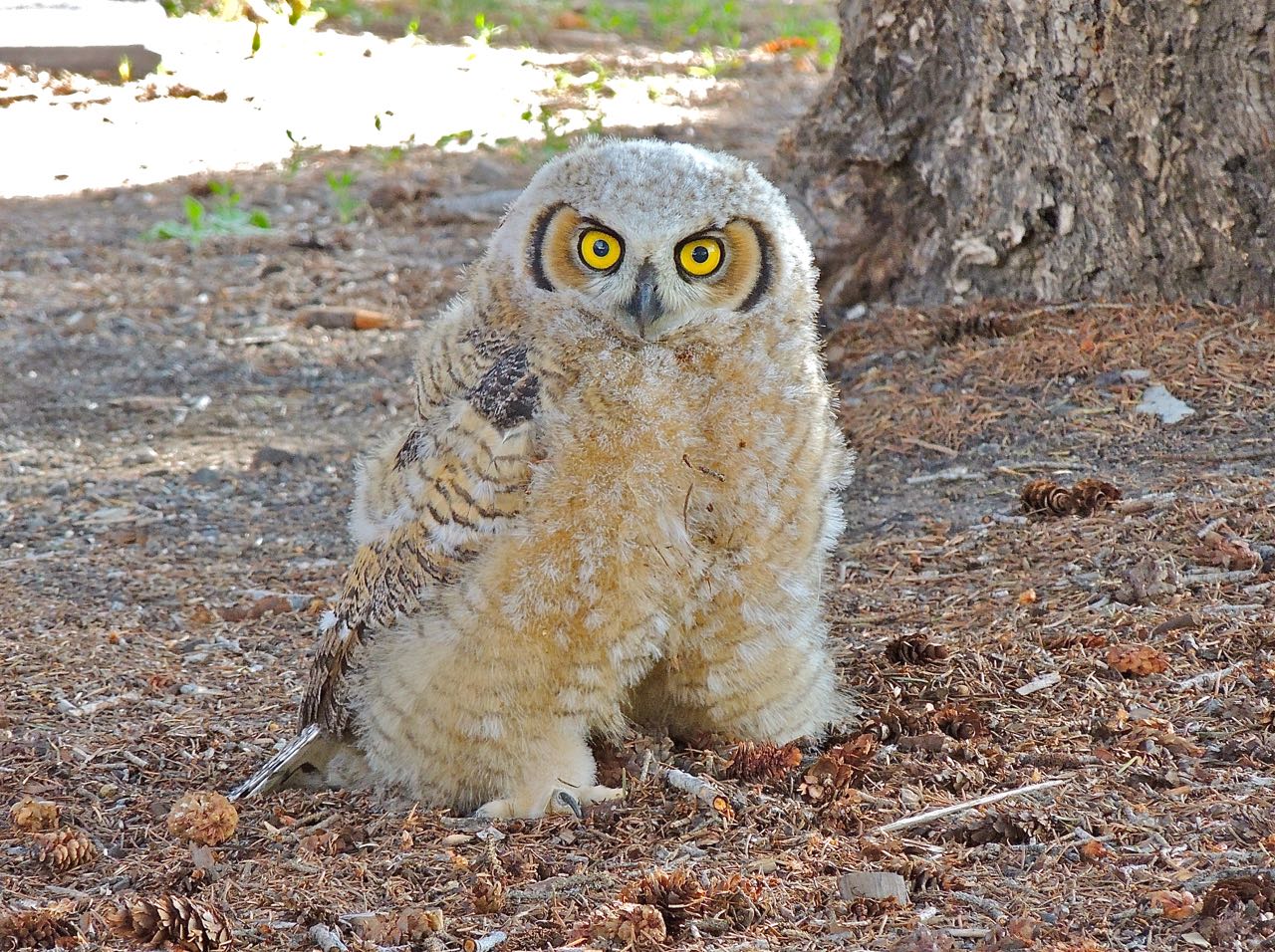 Great Horned Owlet - Photo by William Young
Great Horned Owlet - Photo by William Young
Land Birds. We spent a lot of time driving and spent only a small portion of the trip hiking in places where we could see land birds.
Common Ravens were common in Yellowstone. We saw and heard them frequently. At one stop, I saw one vocalizing from the top of a conifer. At Old Faithful, we heard them go through their impressive repertoire of vocalizations, and I saw some on the ground in front of the bleachers. I had close looks at Black-billed Magpies at Walden Ponds. Gray Jays hung around the visitors area at Jenny Lake. These birds are sometimes called "camp robbers", because they hang around picnic areas and try to steal food. At Wonderland Lake, a female Northern (Red-shafted) Flicker foraged on the ground.
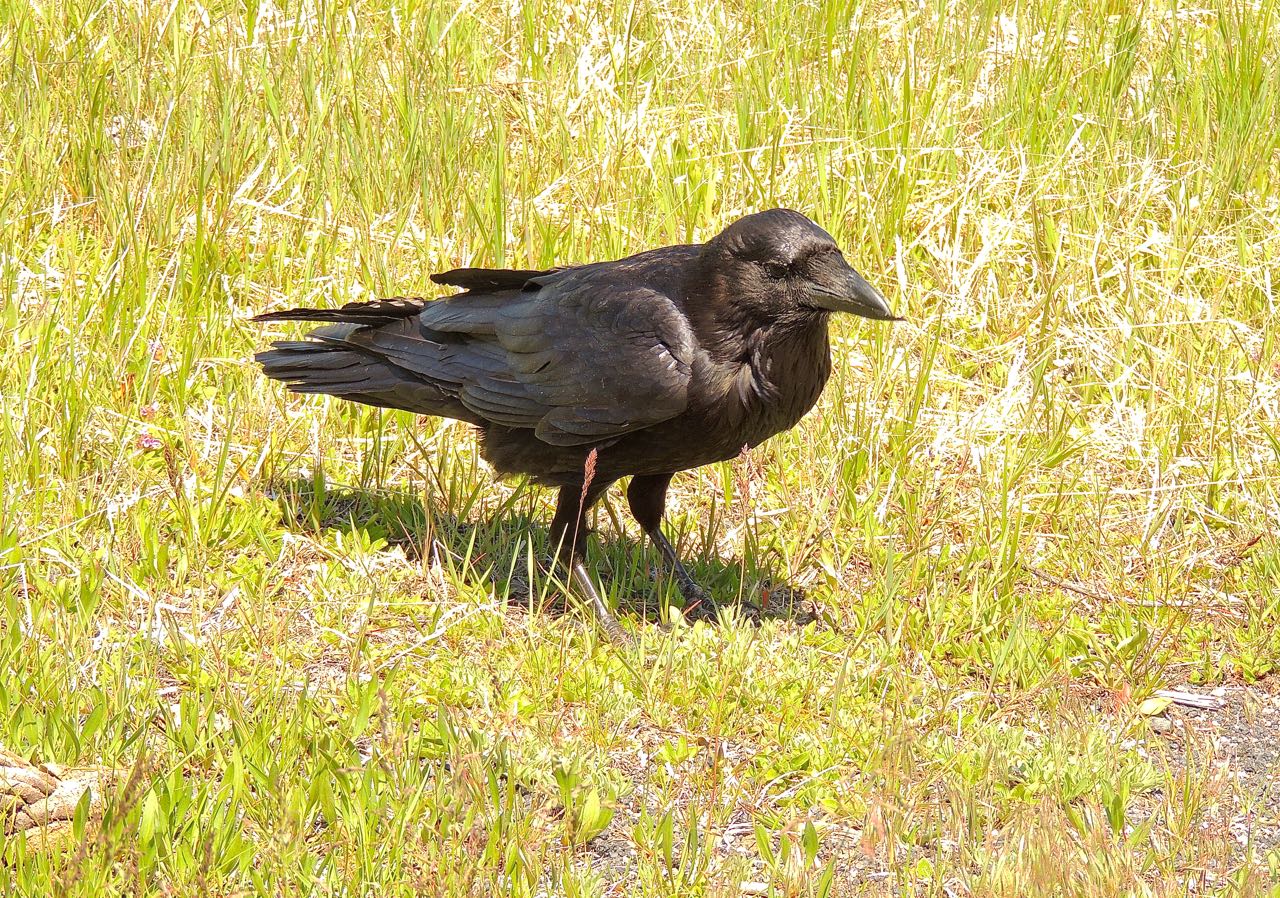 Common Raven - Photo by William Young
Common Raven - Photo by William Young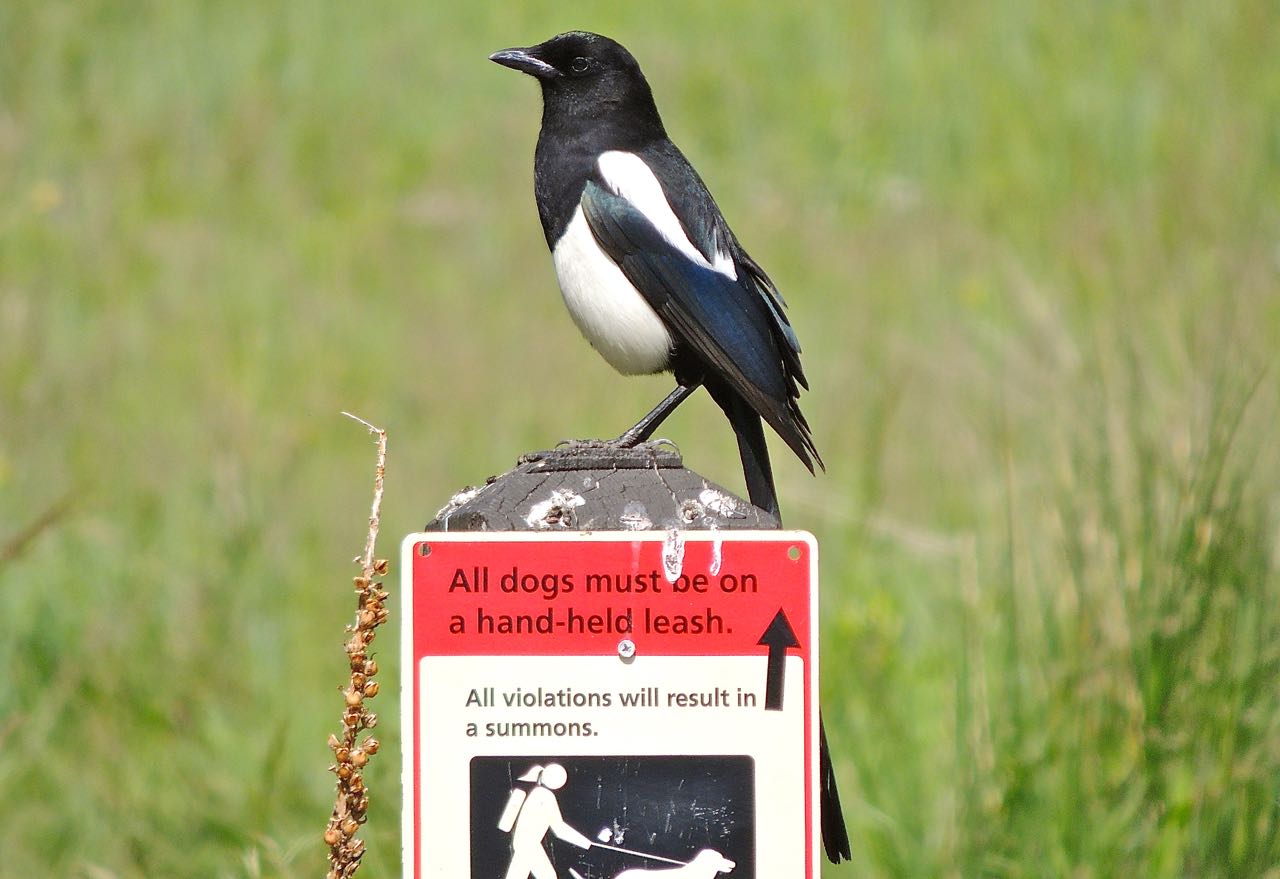 Black-billed Magpie - Photo by William Young
Black-billed Magpie - Photo by William Young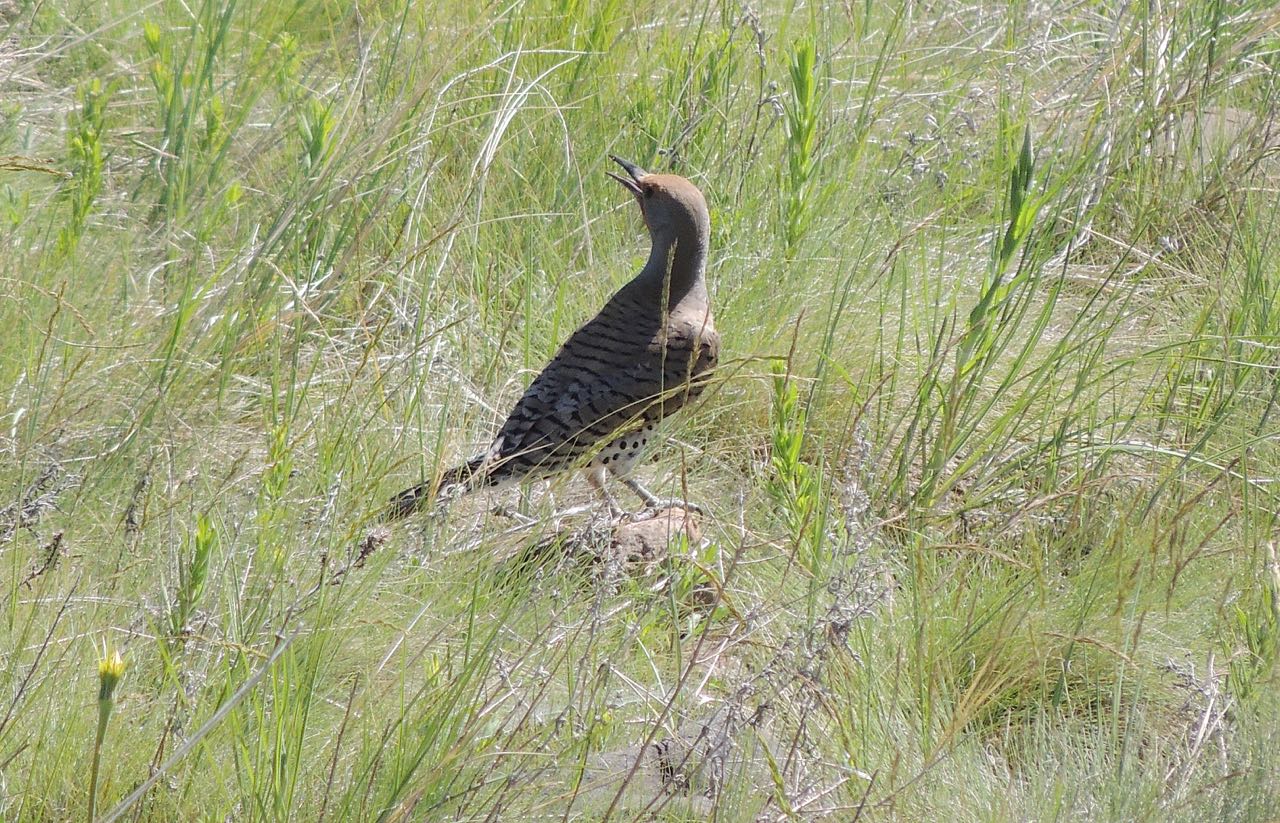 Northern (Red-shafted) Flicker - Photo by William Young
Northern (Red-shafted) Flicker - Photo by William YoungI saw a lot of swallows. Cliff Swallows nested under a bridge near our motel in Thermopolis, and I saw many flying around. Northern Rough-winged Swallows nested in the rocks at the state park in Thermopolis. I saw Barn Swallow nests under the eaves near the bathrooms on Schwabacher Road. At Yellowstone, I saw a Violet-green Swallow in bright sunlight and saw both of those colors. Violet-green Swallows flew around Cooke City when we had lunch there. On our raft trip on the Snake River, Barn, Violet-green, Tree, and Cliff Swallows hawked insects over the water.
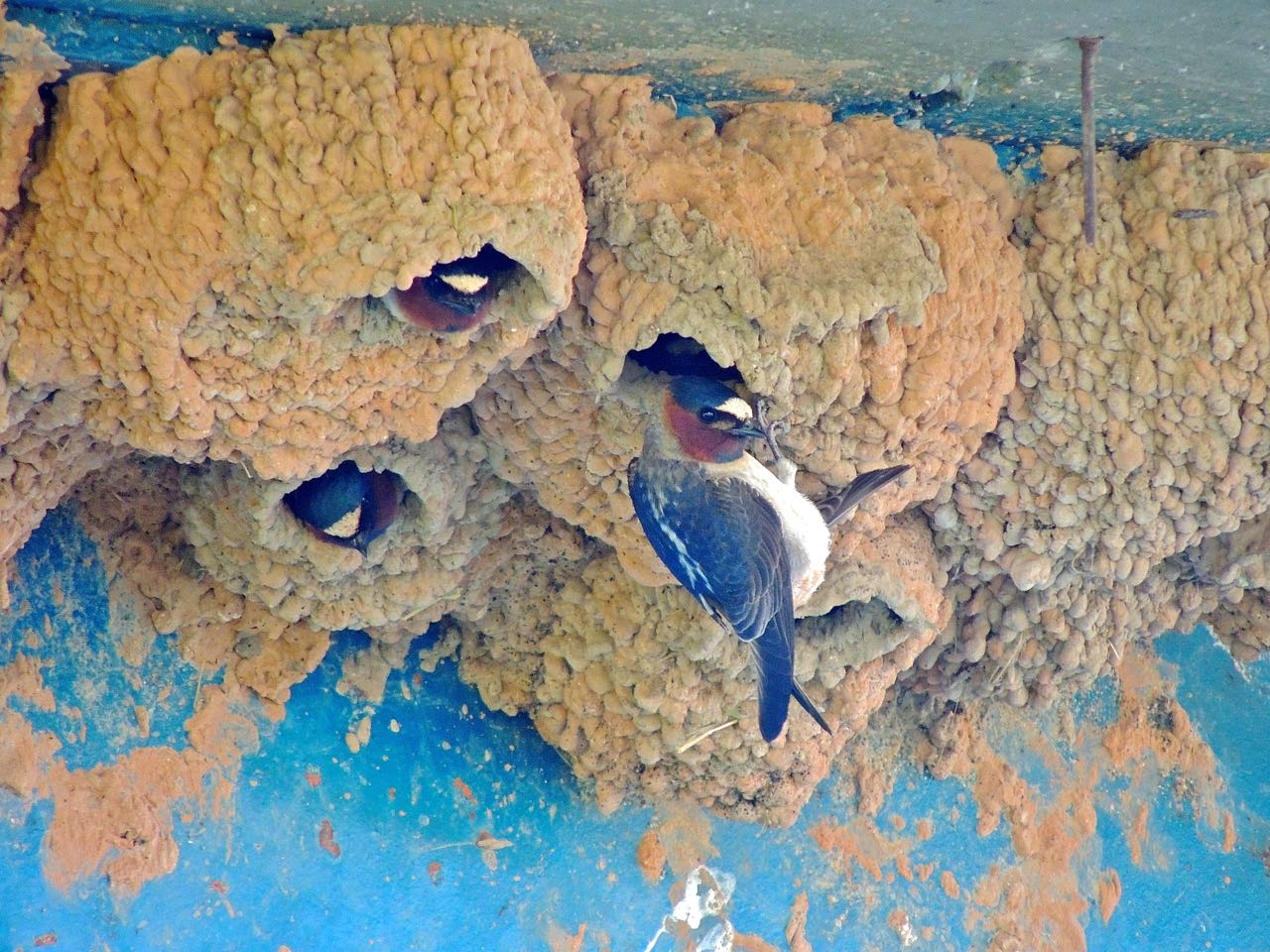 Cliff Swallows at Nest - Photo by William Young
Cliff Swallows at Nest - Photo by William Young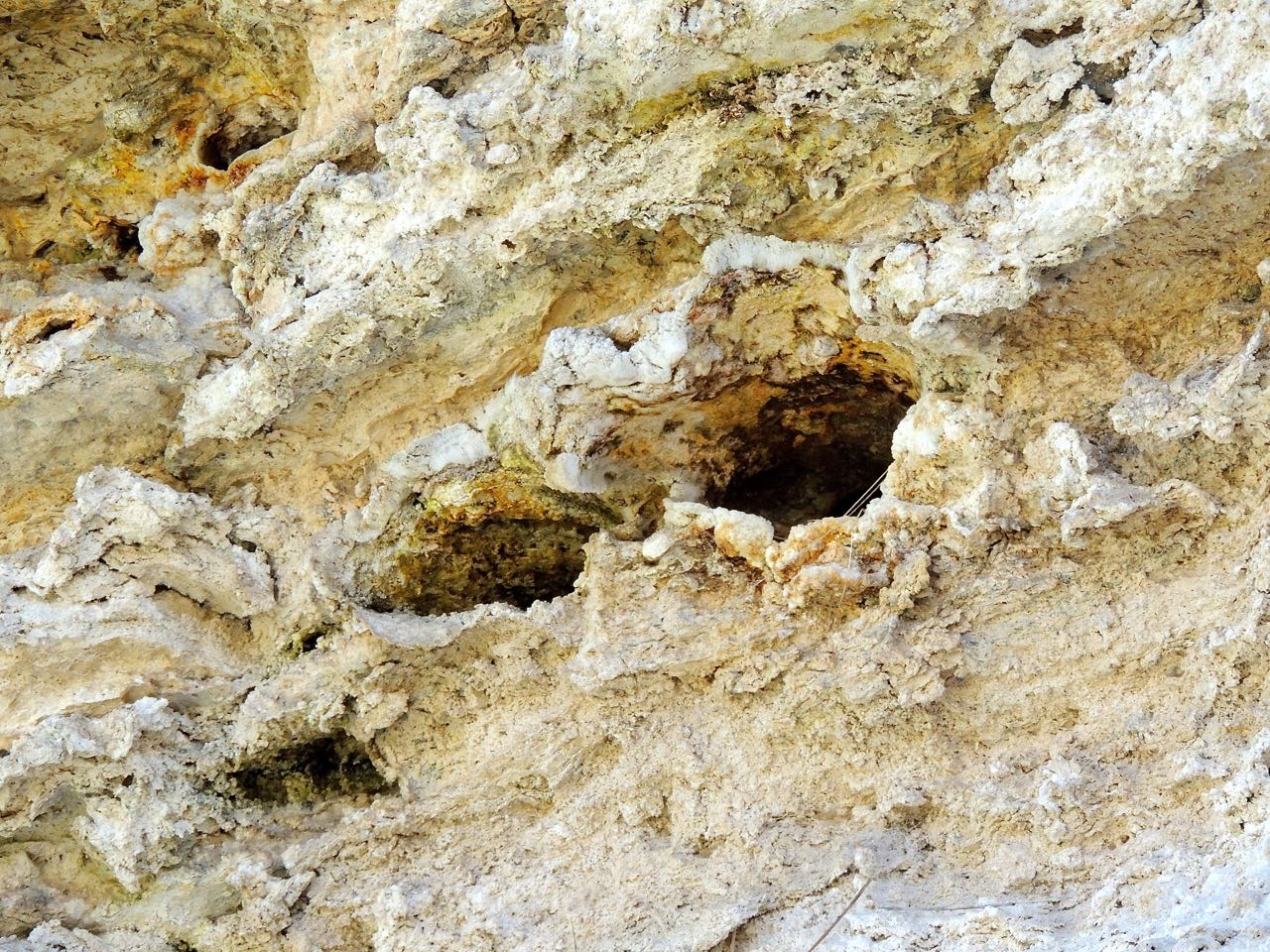 Northern Rough-winged Swallow Nests - Photo by William Young
Northern Rough-winged Swallow Nests - Photo by William Young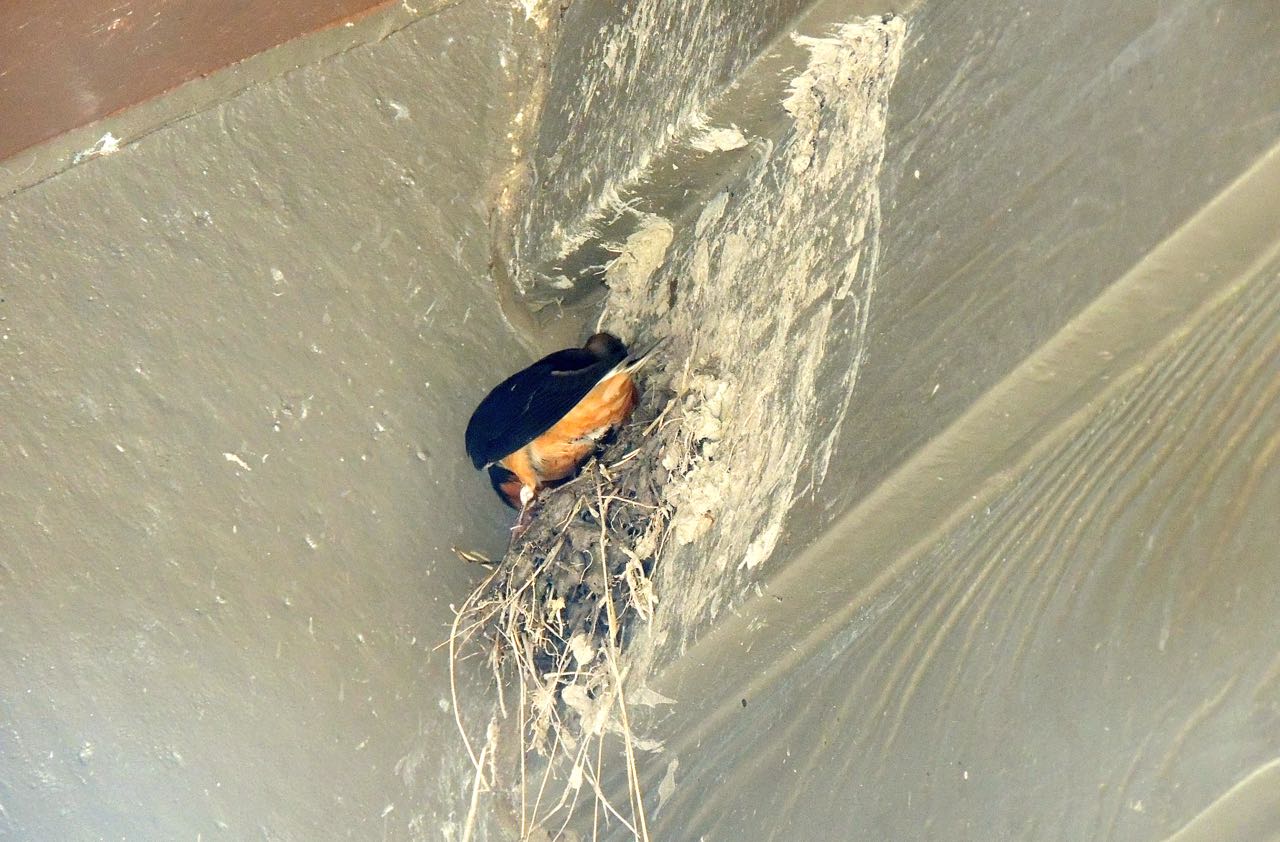 Barn Swallow at Nest - Photo by William Young
Barn Swallow at Nest - Photo by William Young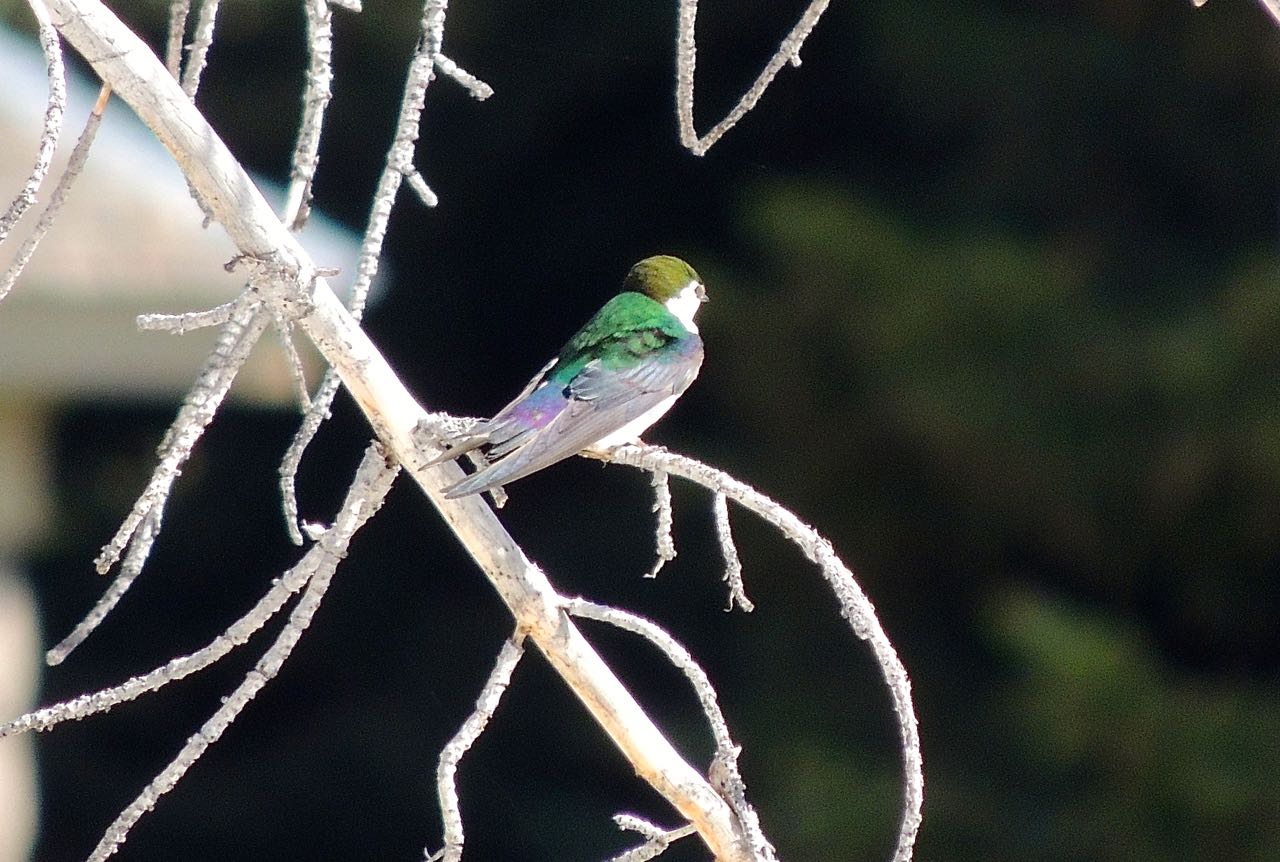 Violet-green Swallow - Photo by William Young
Violet-green Swallow - Photo by William YoungWhen we drove through the Pawnee Grasslands, we saw Horned Larks and Lark Buntings. Both species perched on fenceposts. The bunting is black, with white on the wings, and it is the state bird of Colorado. We also saw Horned Larks on the ground at one of the rest stops before we reached Thermopolis.
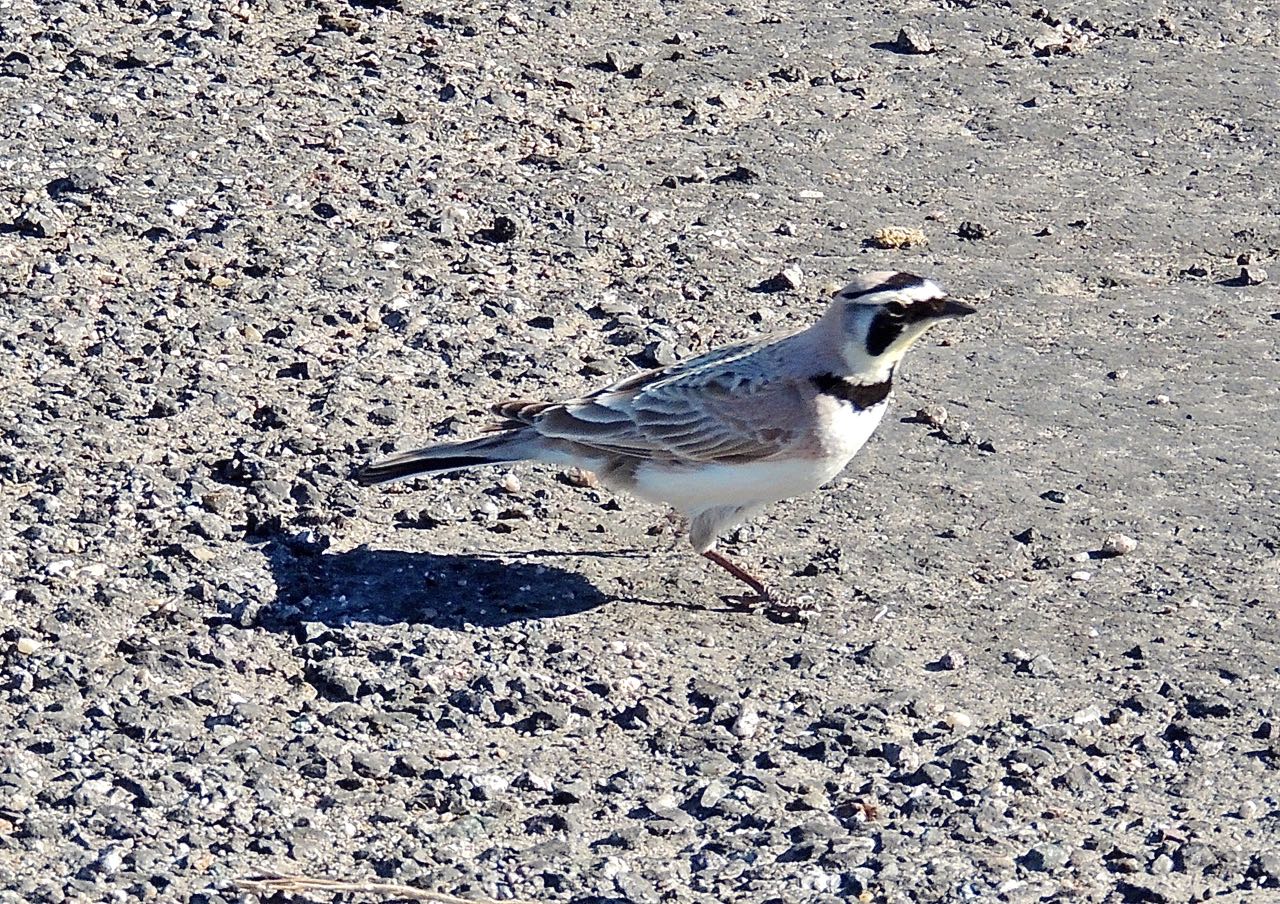 Horned Lark - Photo by William Young
Horned Lark - Photo by William Young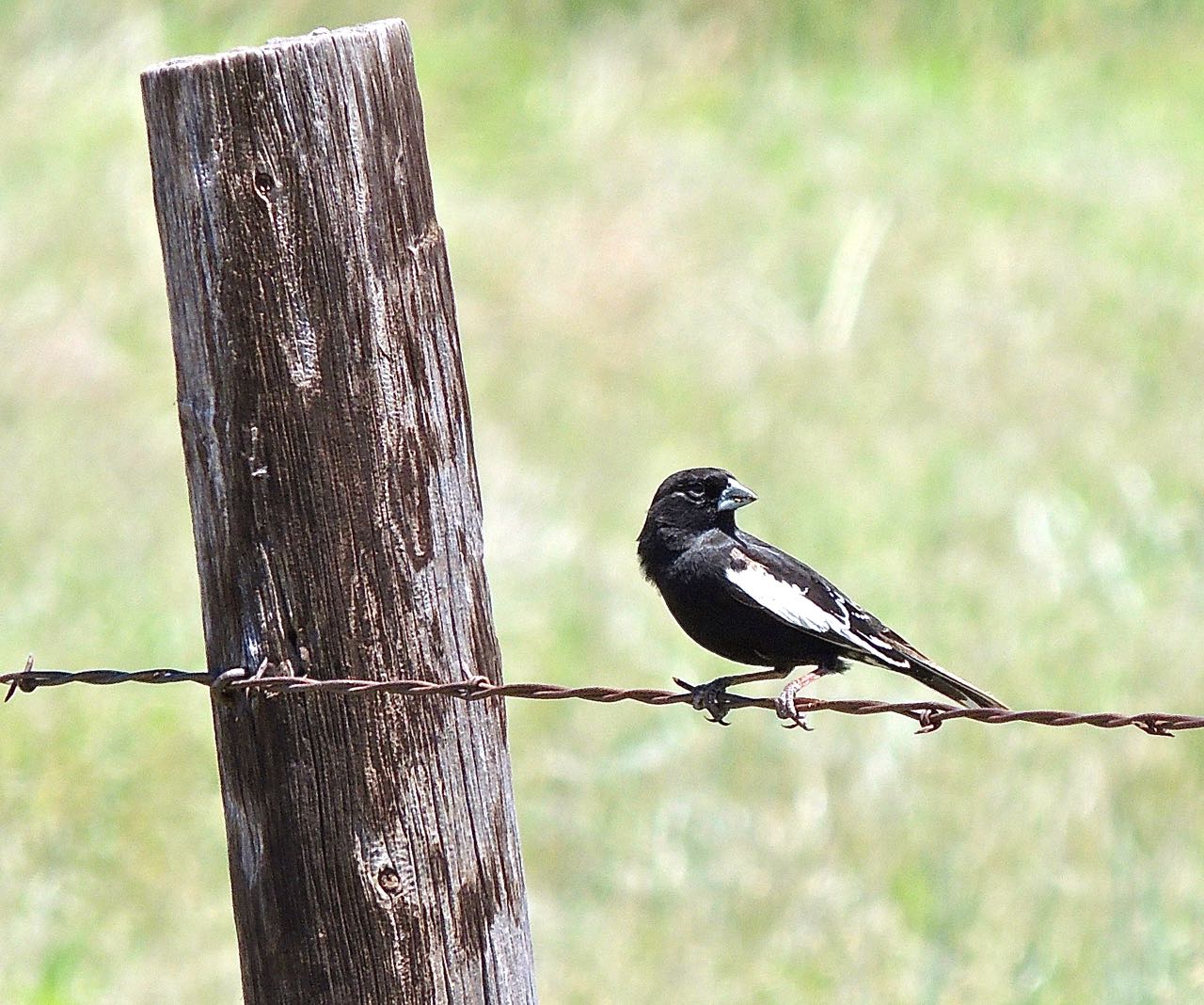 Lark Bunting - Photo by William Young
Lark Bunting - Photo by William YoungOn the Beartooth Highway, we were at high altitude. At one stop, I saw Lincoln's Sparrows. At other stops, I saw White-crowned Sparrows, American Pipits, Horned Larks, Mountain Bluebirds, and the pink-sided race of the Dark-eyed Junco. A Mountain Bluebird perched on the reflector on the back of a vehicle, staring angrily at his reflection in the back window.
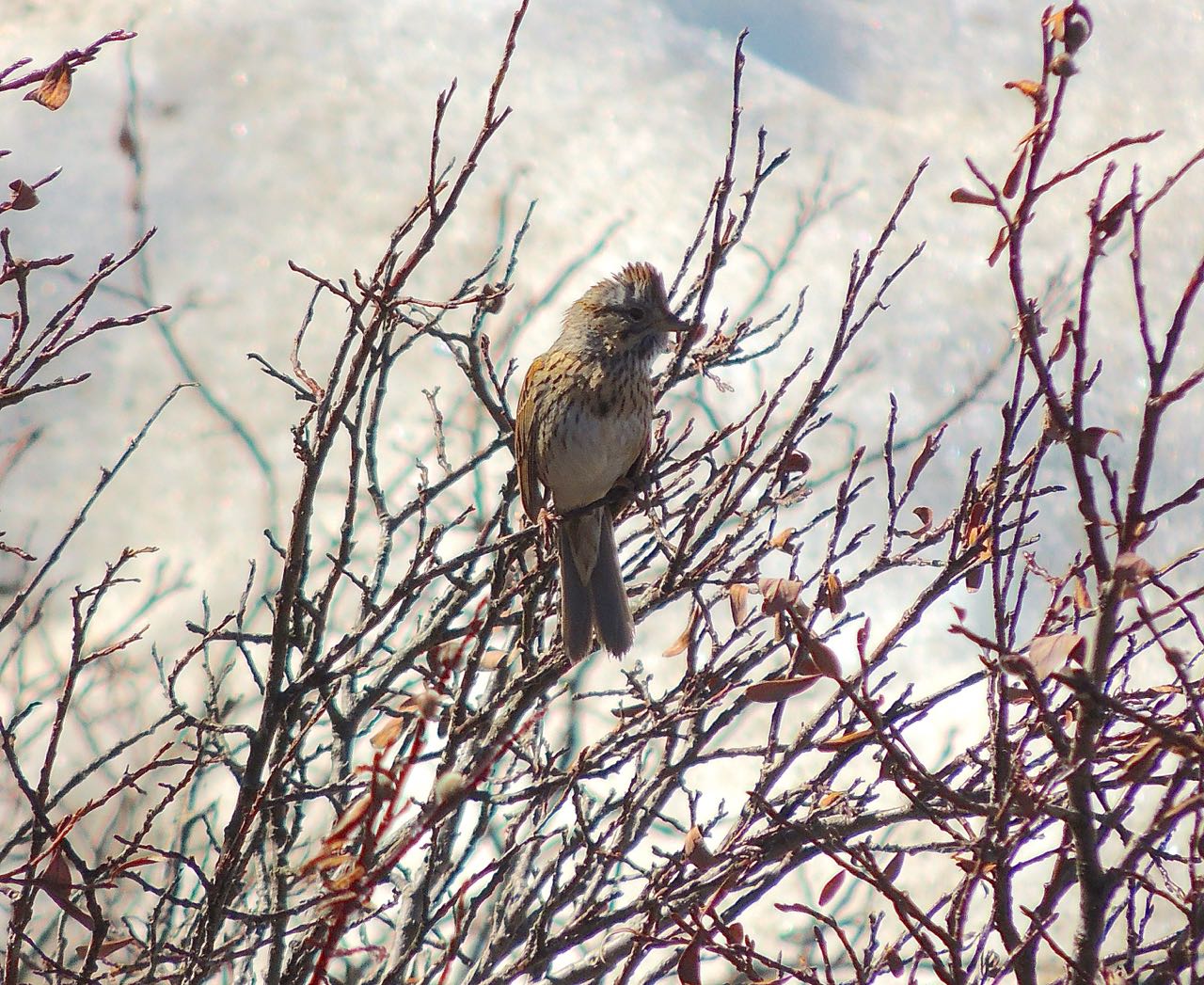 Lincoln's Sparrow - Photo by William Young
Lincoln's Sparrow - Photo by William Young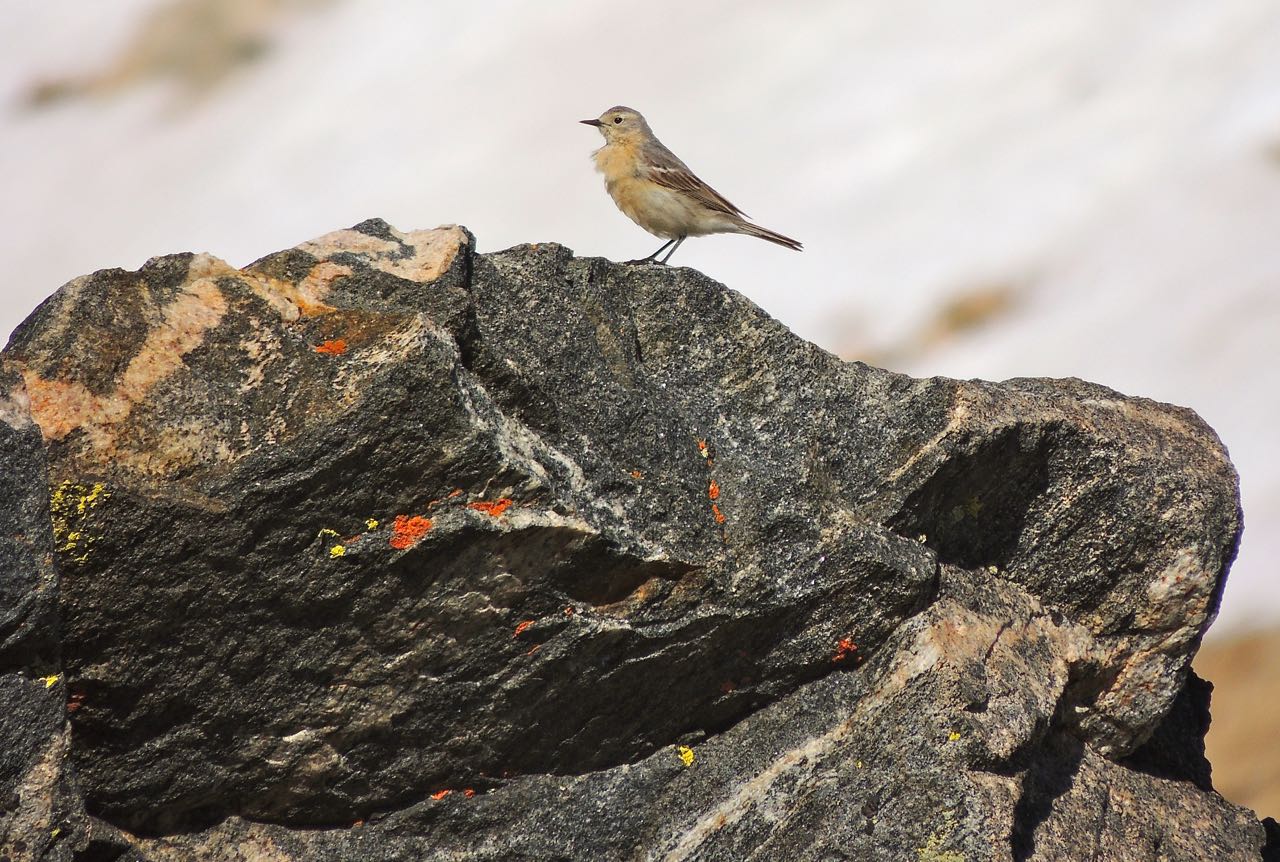 American Pipit - Photo by William Young
American Pipit - Photo by William Young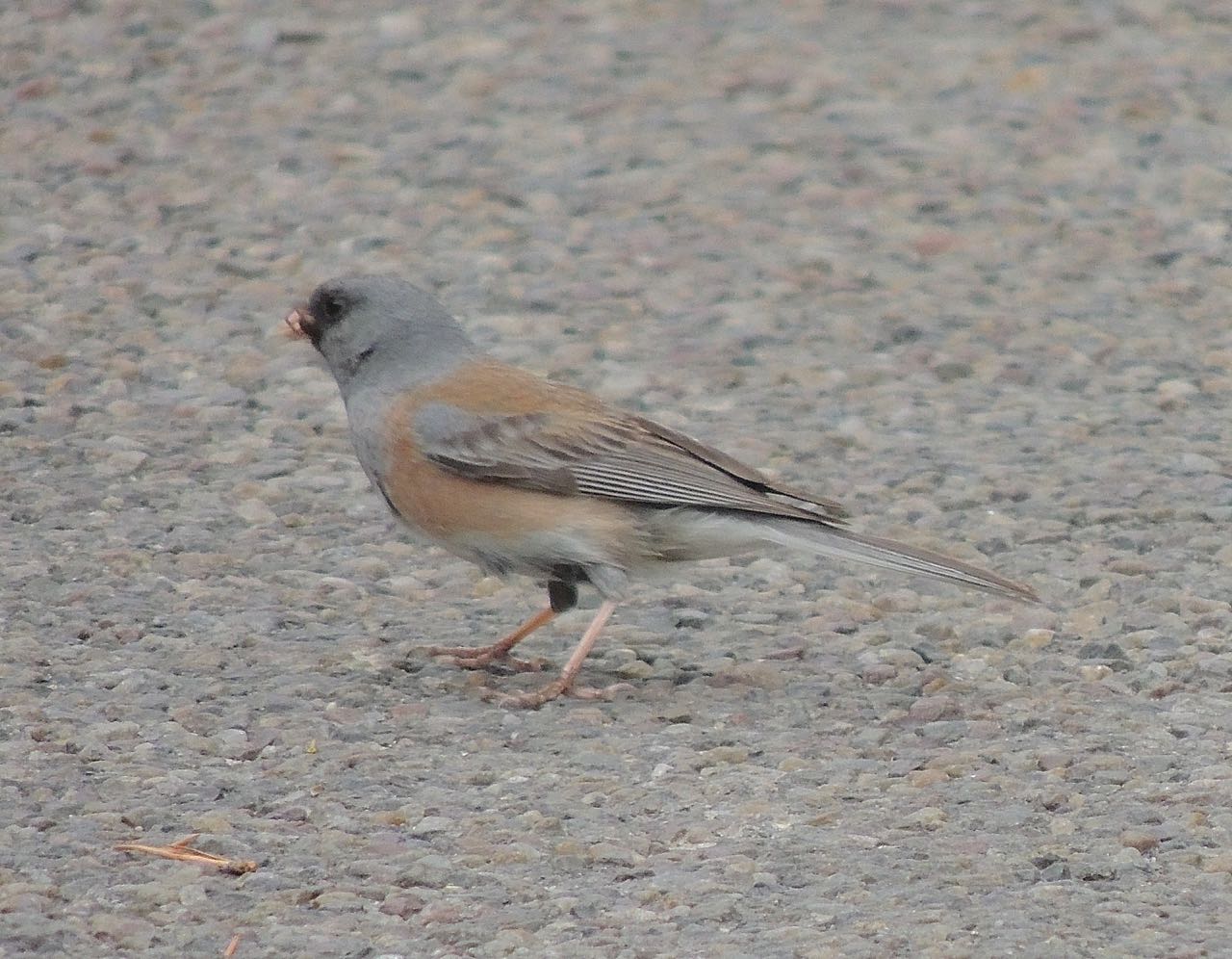 Dark-eyed (Pink-sided) Junco - Photo by William Young
Dark-eyed (Pink-sided) Junco - Photo by William Young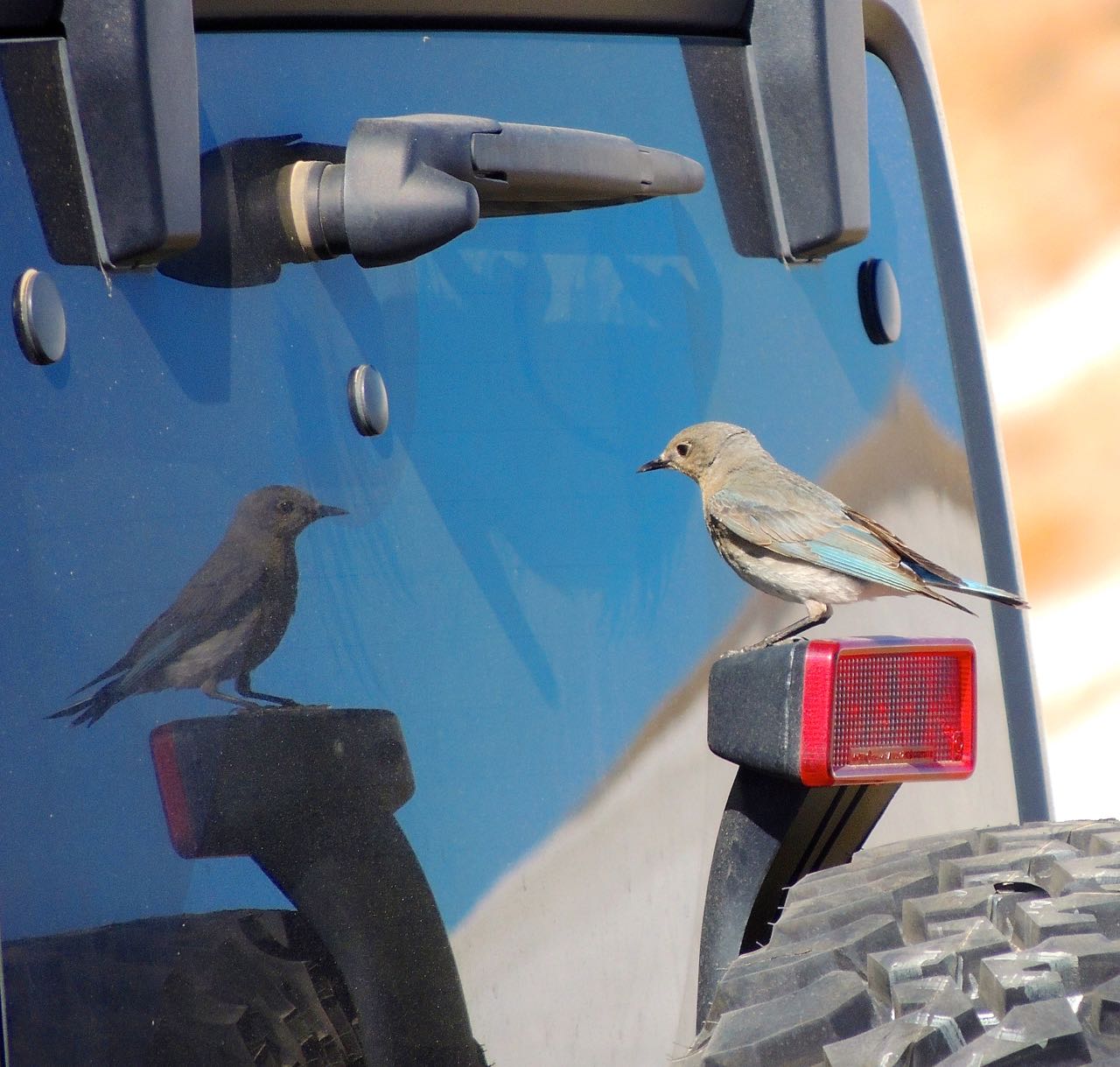 Mountain Bluebird - Photo by William Young
Mountain Bluebird - Photo by William YoungI saw the Audubon's race of the Yellow-rumped Warbler, who has a yellow throat rather than a white one like the ones in the East. I had my best look at one in Jardine. Yellow Warblers were in the bushes around Schwabacher Road, and I saw one chase a Broad-tailed Hummingbird. Also on Schwabacher Road, I saw a singing Savannah Sparrow. White-crowned Sparrows were common, and I had close looks at some near the entrance to the Beaver Pond Trail.
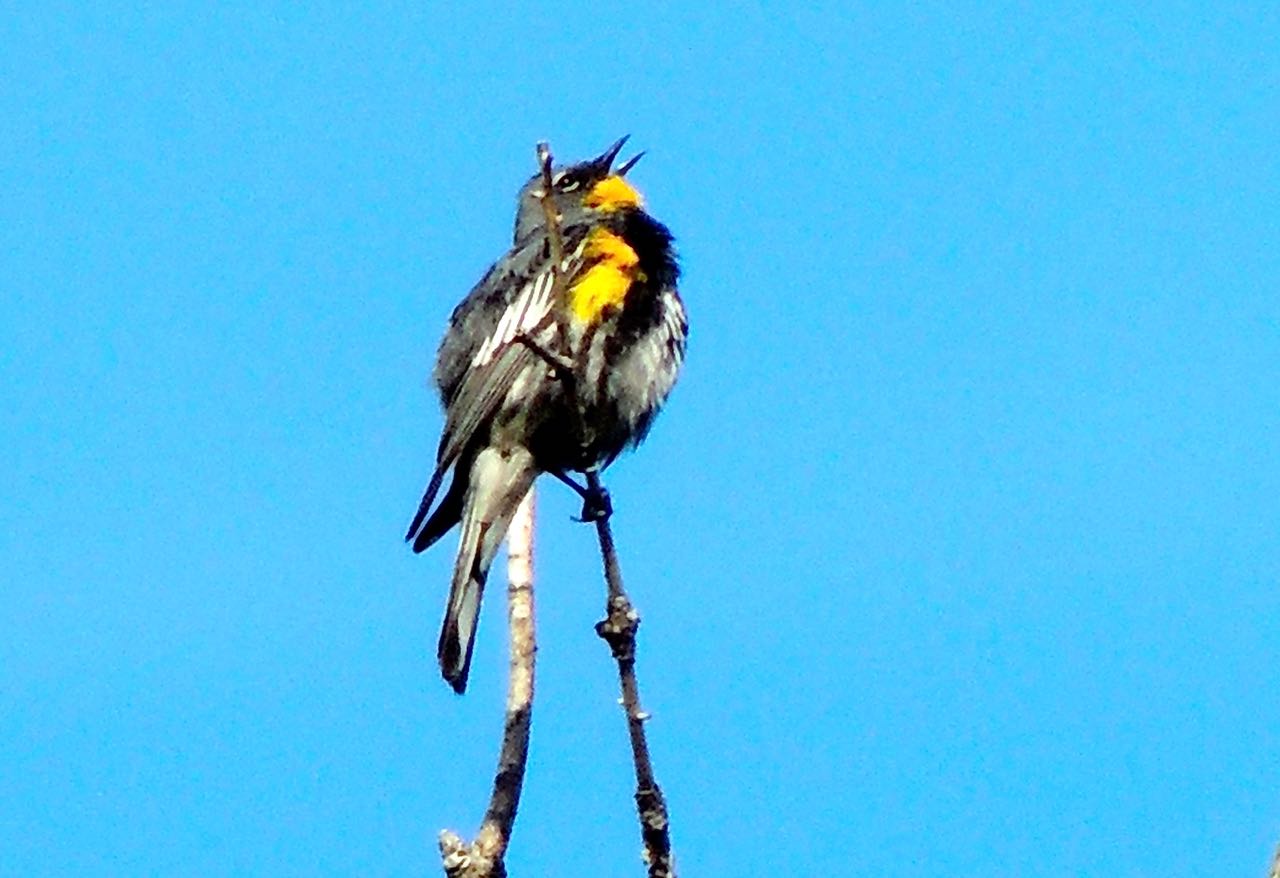 Yellow-rumped (Audubon's) Warbler - Photo by William Young
Yellow-rumped (Audubon's) Warbler - Photo by William Young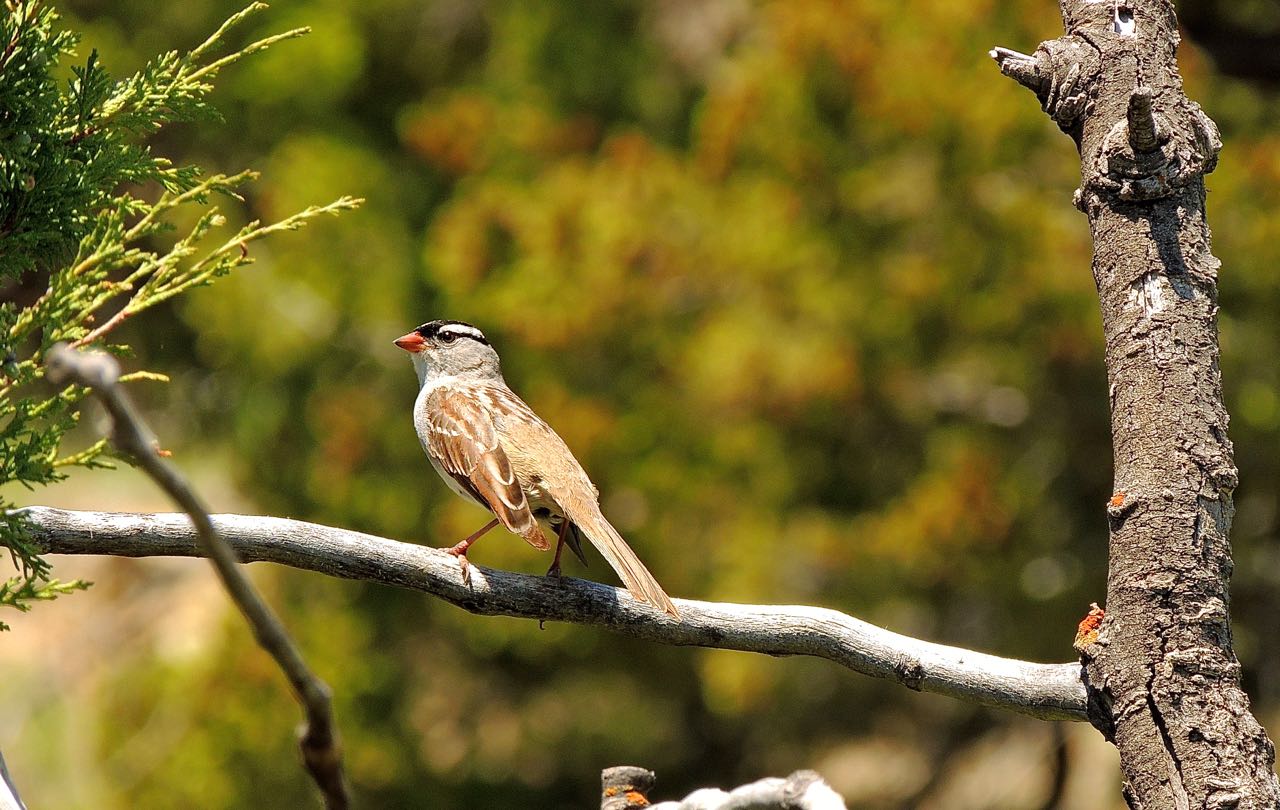 White-crowned Sparrow - Photo by William Young
White-crowned Sparrow - Photo by William YoungOn a hike to Wraith Falls, I had close looks at a Townsend's Solitaire, who is in the thrush family. In the same area, I saw Brewer's Blackbirds. On our numerous stops at Floating Island Lake, I usually saw or heard Yellow-headed Blackbirds. Their call sounds like someone being choked. At Wonderland Lake, some breeding plumage Bullock's Orioles sang in the trees. On our attempted walk on the Beaver Pond Trail, I saw a male Western Tanager, who was bright yellow-and-black, with a splash of red on the face.
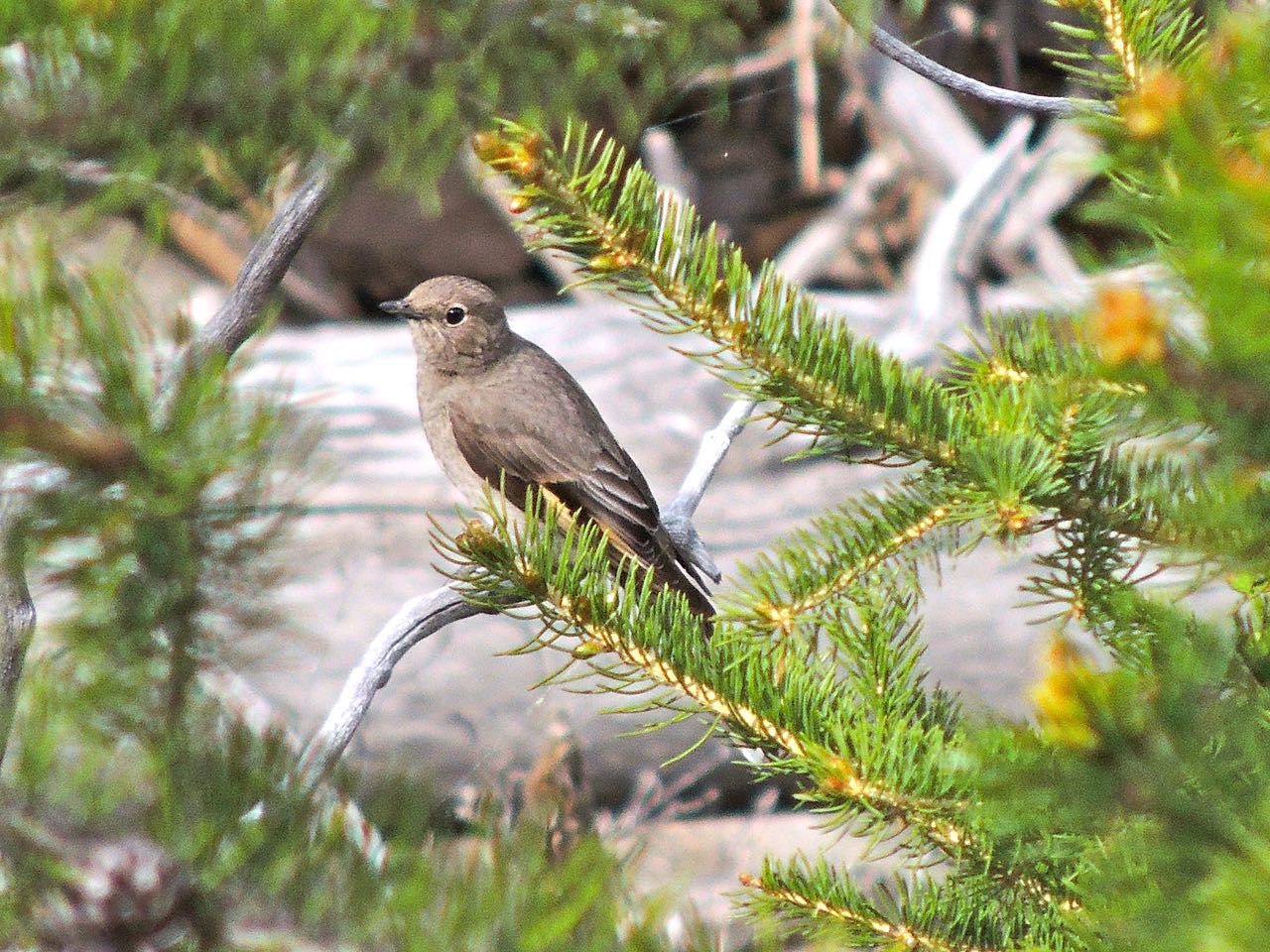 Townsend's Solitaire - Photo by William Young
Townsend's Solitaire - Photo by William Young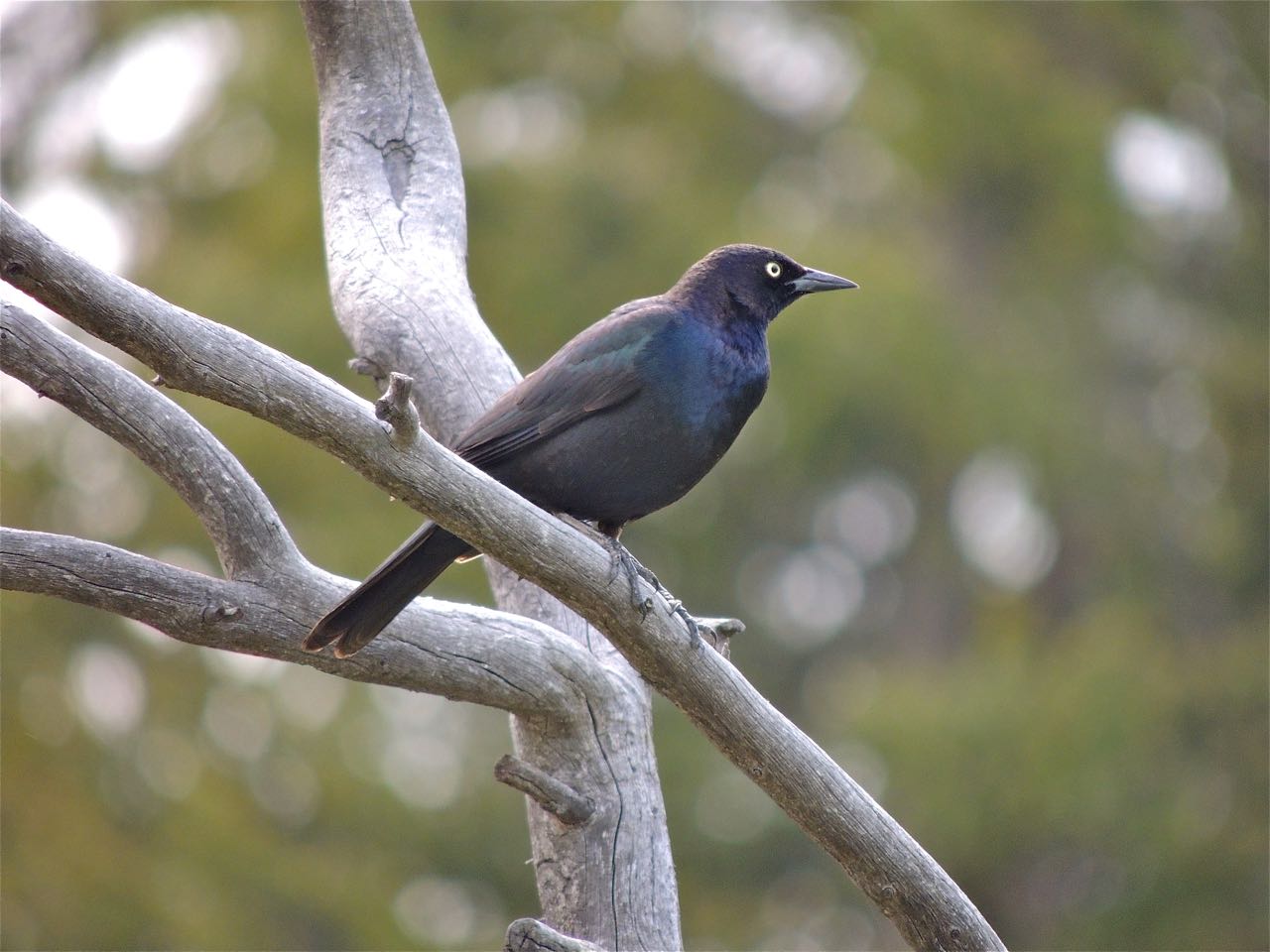 Brewer's Blackbird - Photo by William Young
Brewer's Blackbird - Photo by William Young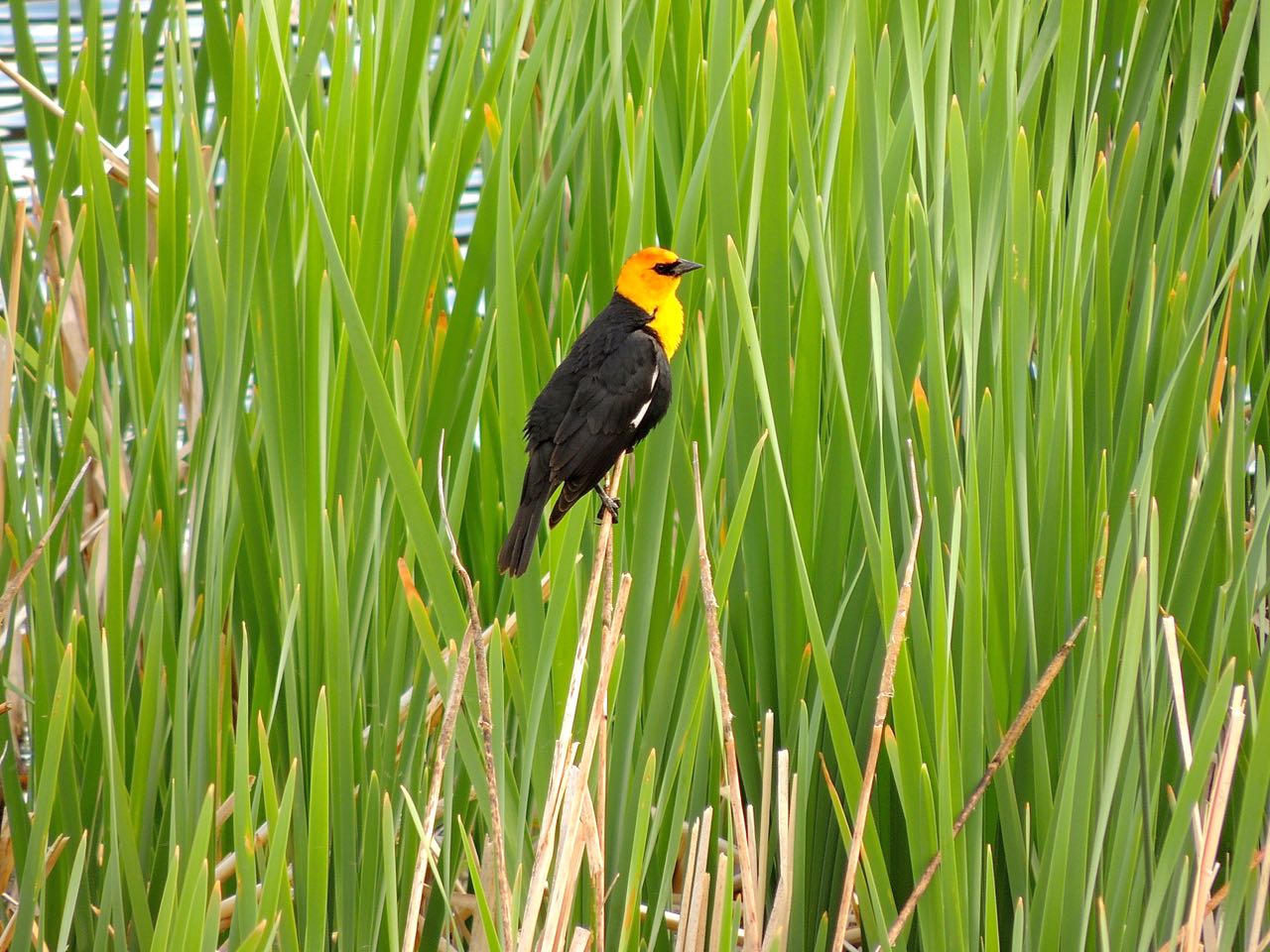 Yellow-headed Blackbird - Photo by William Young
Yellow-headed Blackbird - Photo by William Young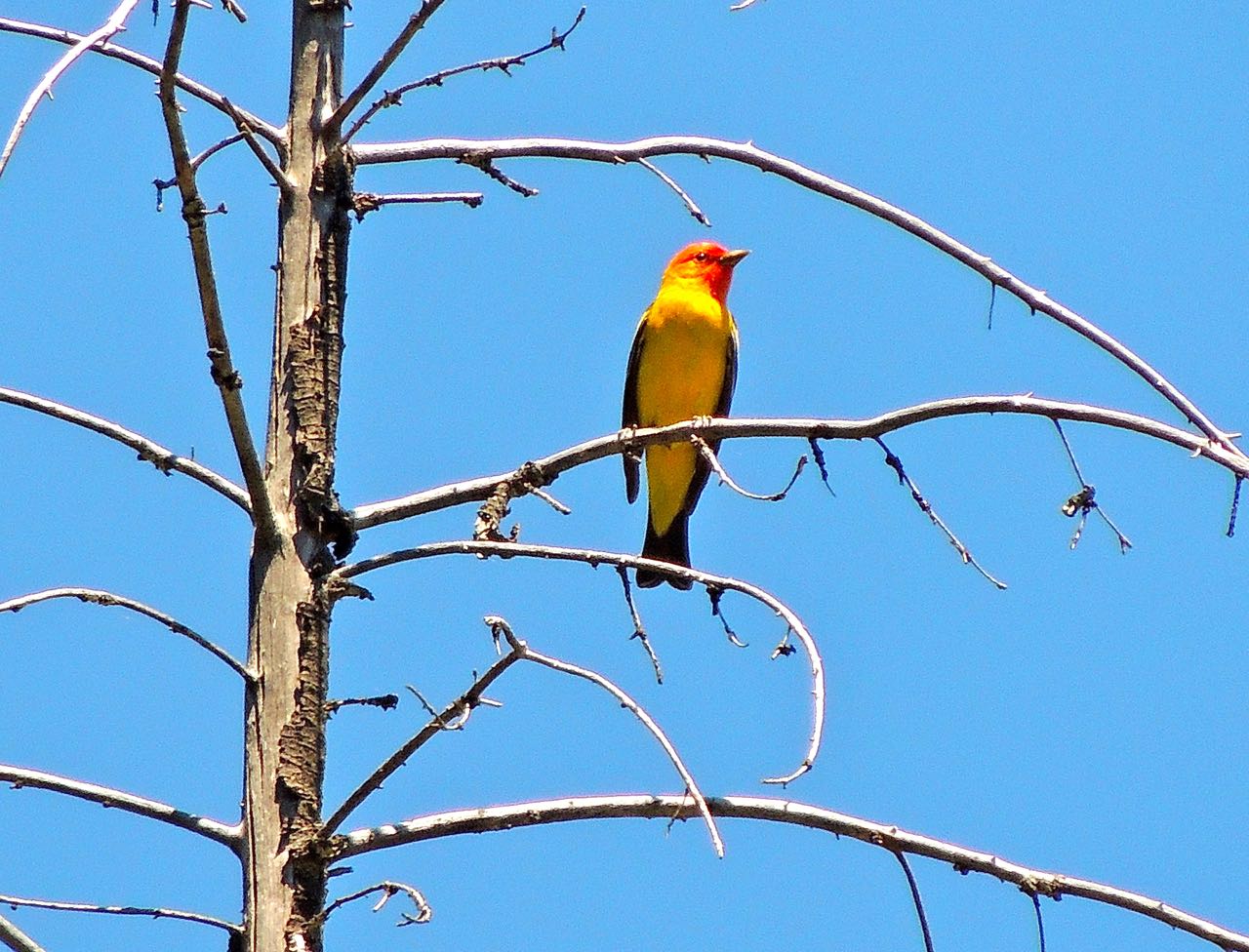 Western Tanager - Photo by William Young
Western Tanager - Photo by William Young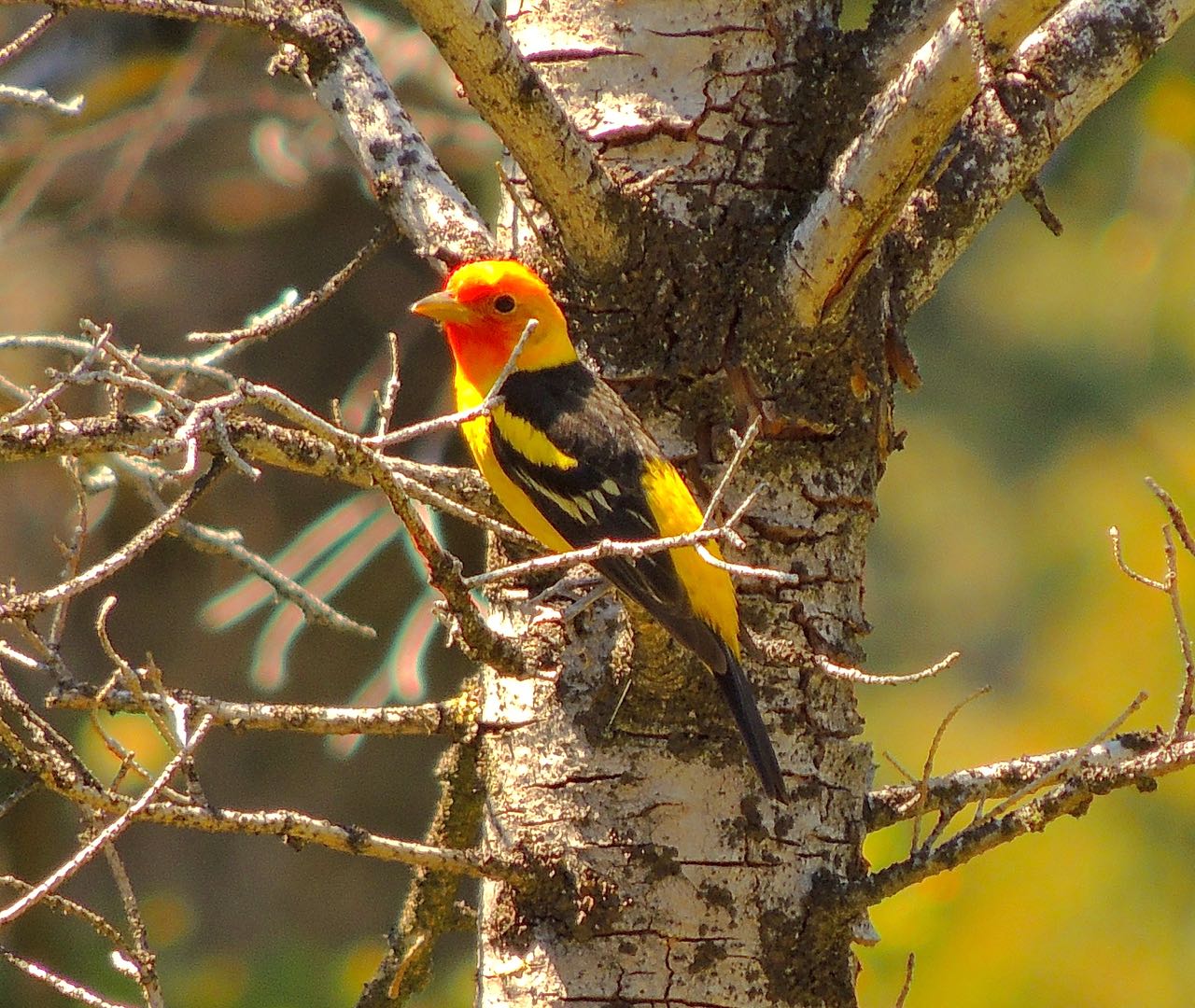 Western Tanager - Photo by William Young
Western Tanager - Photo by William YoungThe Lazuli Bunting was the songbird I most wanted to see. On our final morning in Yellowstone, I found one singing in a tree in a picnic area south of the Mammoth Hot Springs. I saw its lovely blue head, rufous breast, and white belly. On the Snake River raft trip, I saw an Indigo Bunting. The two species sometimes interbreed.
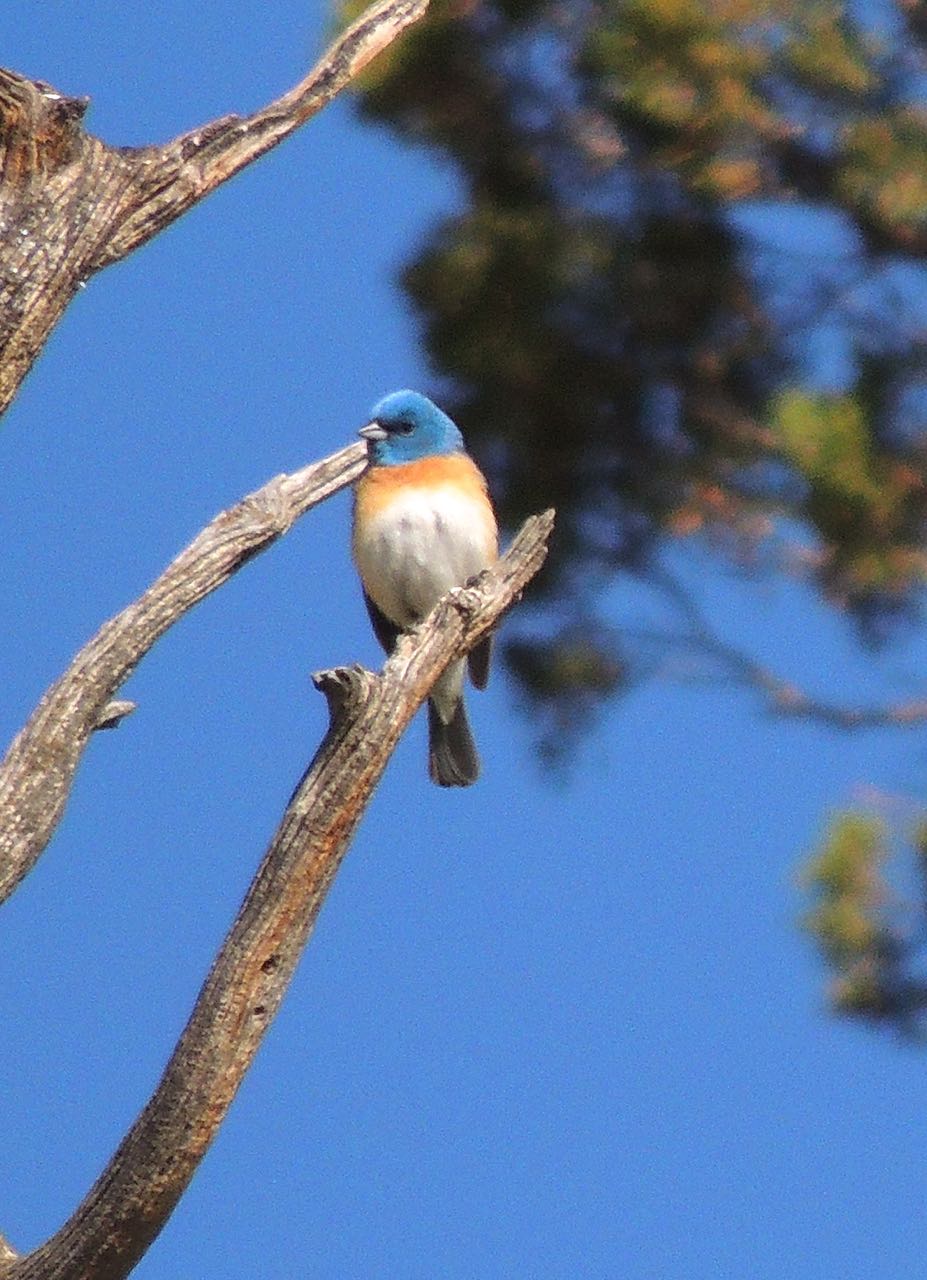 Lazuli Bunting - Photo by William Young
Lazuli Bunting - Photo by William YoungAfter the raft trip, we went over to one of the buildings in Moose to look for hummingbirds. A "Private Property" sign was posted, so I asked a woman at the cash register if we could go behind the building. She said okay, and I saw both Broad-tailed and Calliope Hummingbirds. The wings of the Broad-tailed make a loud whistle during flight. It is in the same genus as the Rufous Hummingbird, who sometimes shows up in the East during the winter. The Calliope Hummingbird was the second new bird I saw on the trip, along with the Lazuli Bunting. It is the smallest breeding bird in North America and one of the smallest in the world, at only 3.25 inches. It was named after the Greek muse Calliope and is now considered to be in the same genus as the Broad-tailed. The male has red feathers on his throat, with some white showing through.
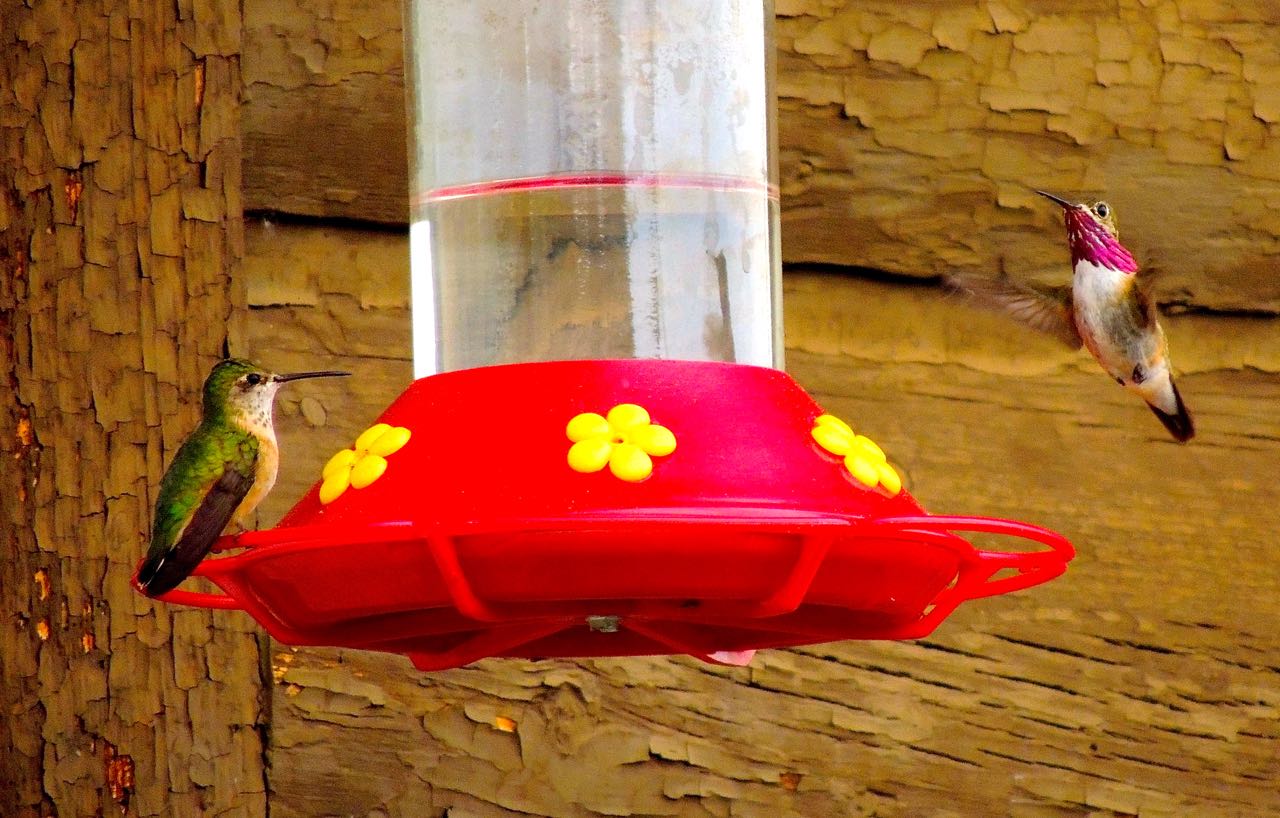 Broad-tailed and Calliope Hummingbirds - Photo by William Young
Broad-tailed and Calliope Hummingbirds - Photo by William Young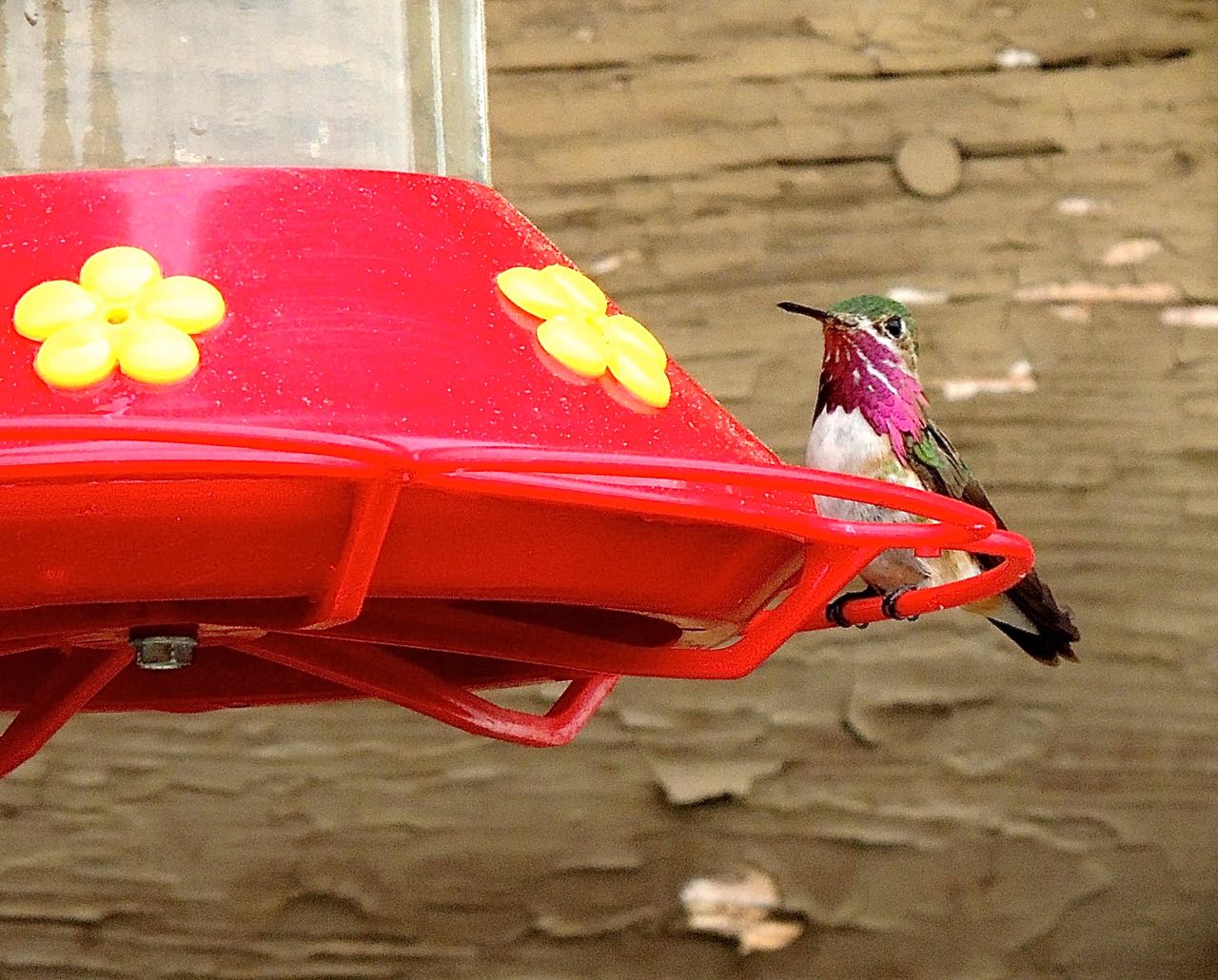 Calliope Hummingbird - Photo by William Young
Calliope Hummingbird - Photo by William Young
Mammals and Other Wildlife. Many wildlife attractions of Yellowstone and Grand Teton are non-avian. For me, the most exciting attraction was the pack of Gray Wolves at Slough Creek. We stopped there numerous times during the trip. Some researchers monitor the activities of this pack, and I learned a lot from talking to them. The species is called "Gray Wolf", but wolves come in many colors, ranging from creamy-brown to black. We saw a gray wolf and another who had a black face. We also saw three black pups, who would grow up to be black wolves. The pack had nine pups. The wolves were usually on a hill more than a mile away. I had a telescope, and we had pretty good looks. We went back to Slough Creek a couple of days later in the late afternoon and had much better luck. Three adults came down from the hillside and crossed the road about 100 yards from us. They walked past a couple of grazing adult American Bison, who paid little attention, even though wolves sometimes kill young bison. We observed a fourth adult wolf who walked on the hillside before they all disappeared into the vegetation.
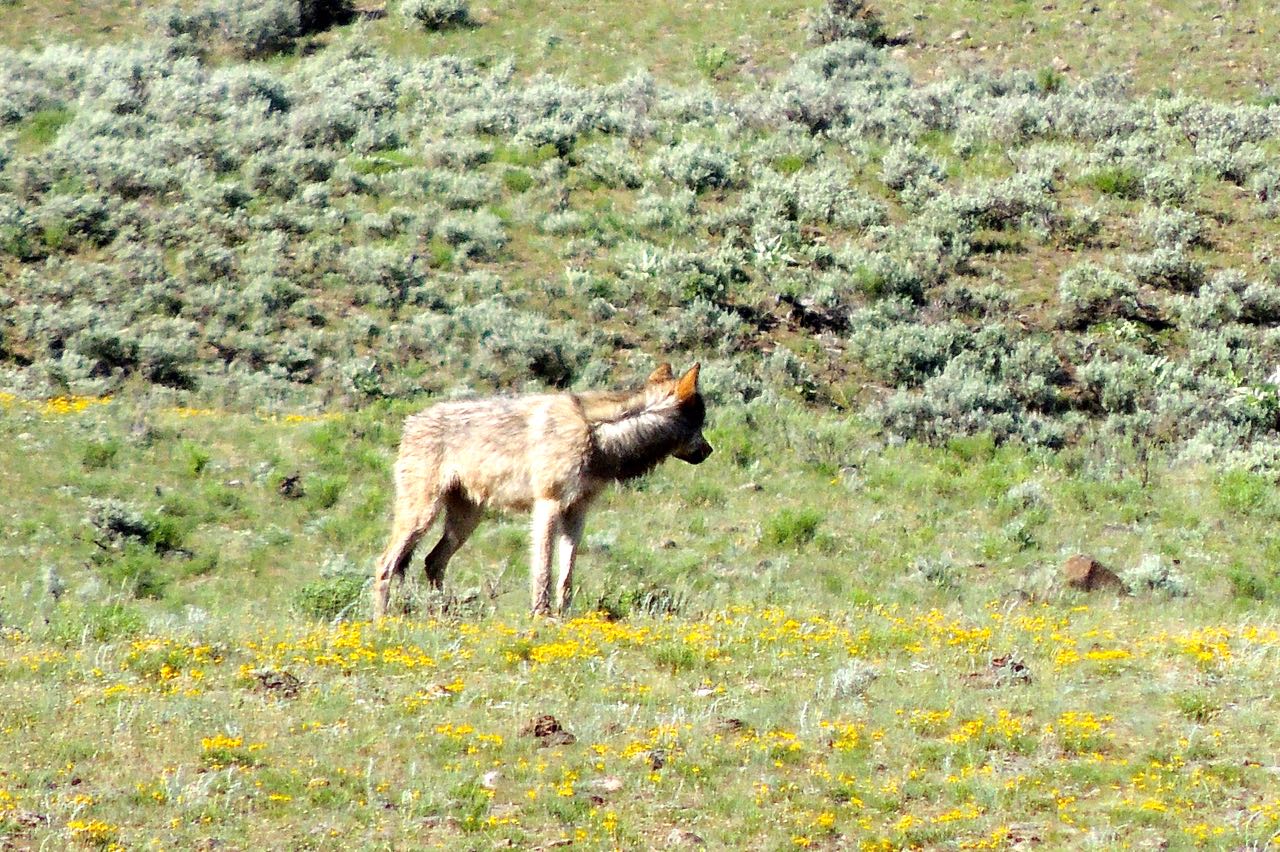 Gray Wolf - Photo by William Young
Gray Wolf - Photo by William Young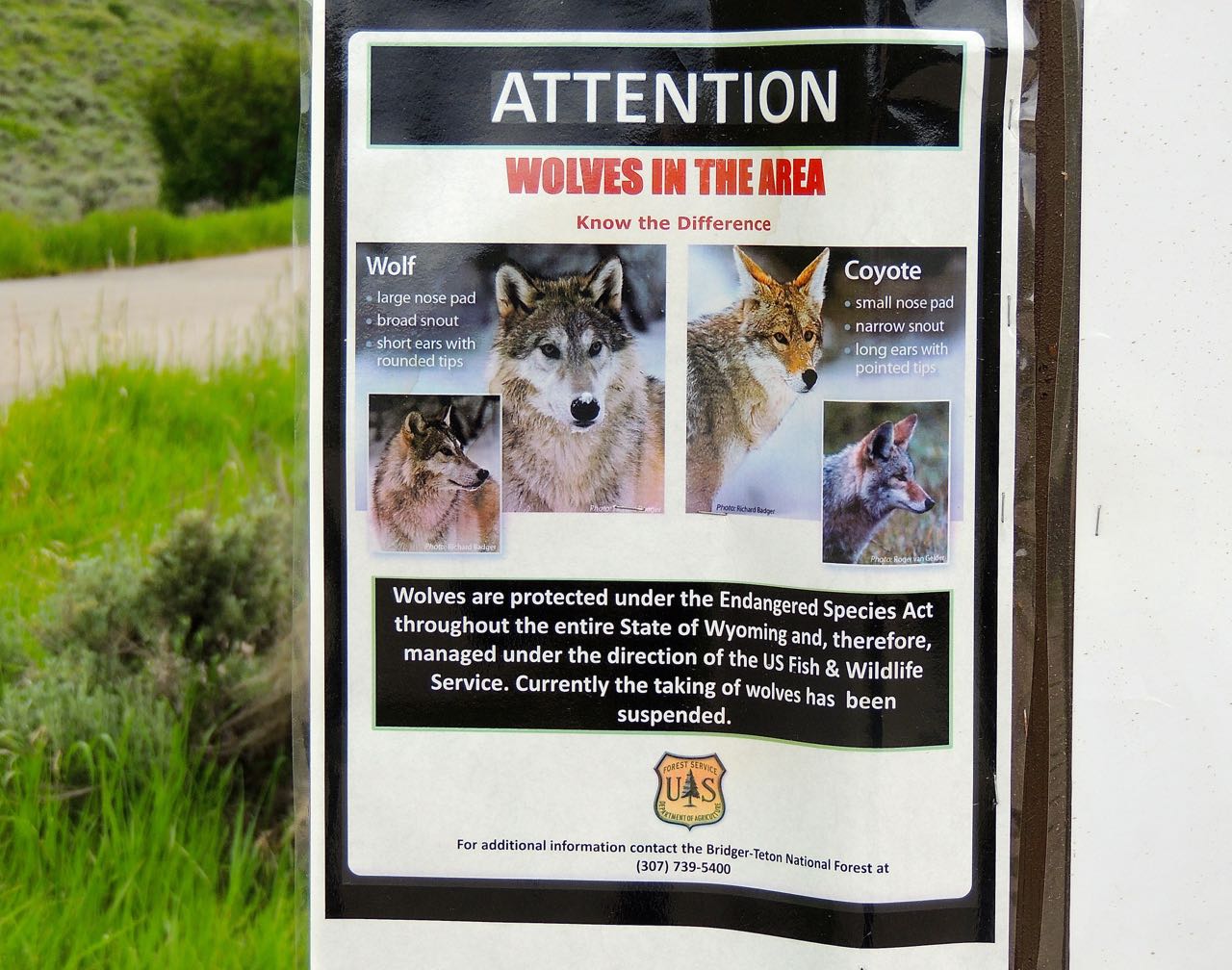 Gray Wolf Sign - Photo by William Young
Gray Wolf Sign - Photo by William YoungAnother major attraction is the bears. We saw quite a few Grizzly Bears. One of the best places to see them was on the road south of the Mammoth Hot Springs. We saw a sow feeding on vegetation with two cubs. The cubs sometimes scampered and wrestled with each other. The Grizzly Bear is a subspecies of the Brown Bear. One way to tell Grizzlies from the other Brown Bears is by the hump on their shoulders. We also saw a lot of non-Grizzly Brown Bears. In some places, we saw sows with cubs, and some of the cubs were quite acrobatic. Usually, when a bear was around, a lot of cars were stopped in the area. Outside the park, many places in Jardine had warning signs about bears. We did not see any while we were hiking, but we saw a Brown Bear in the road as we drove back to town. It was the first bear we found on our own.
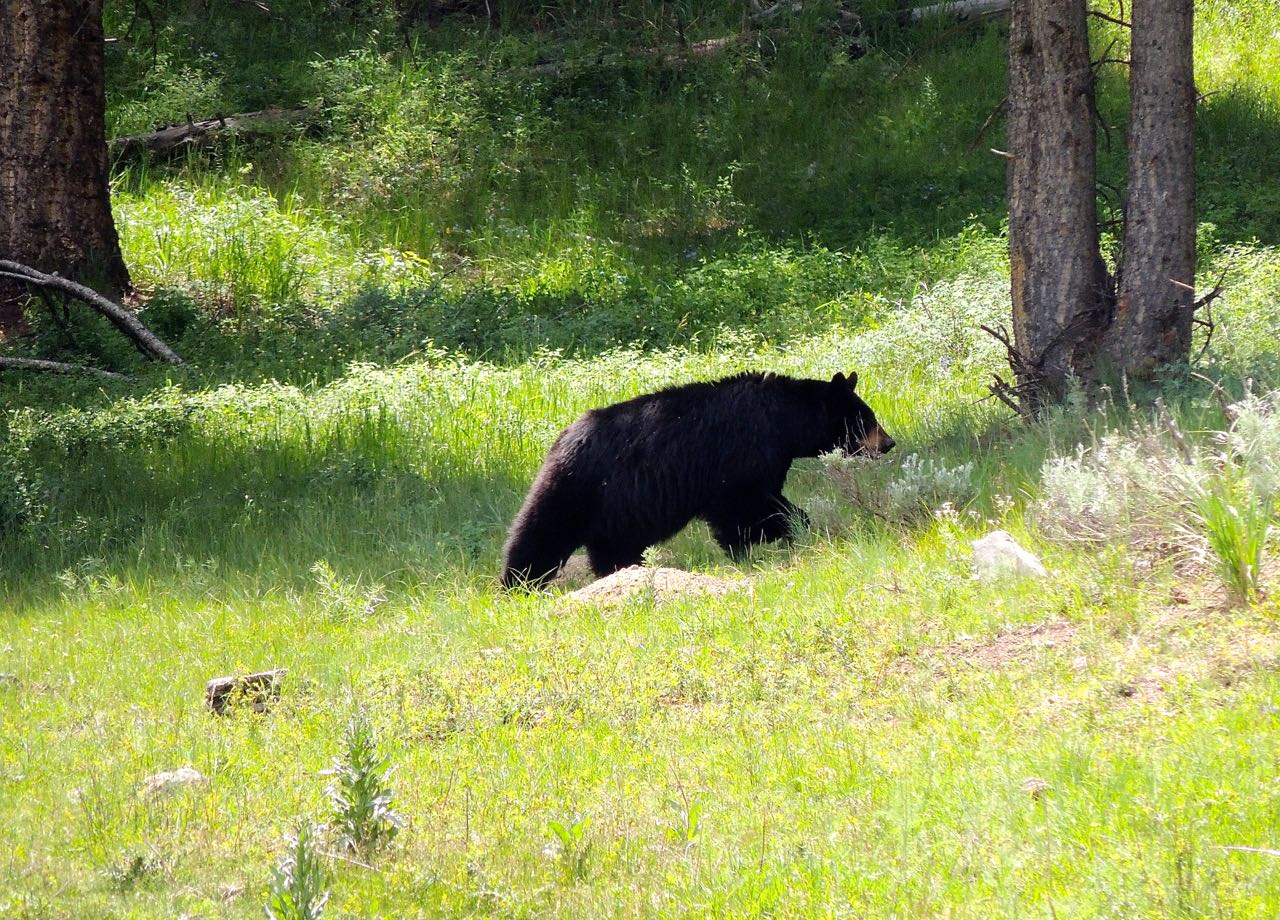 Brown Bear - Photo by William Young
Brown Bear - Photo by William Young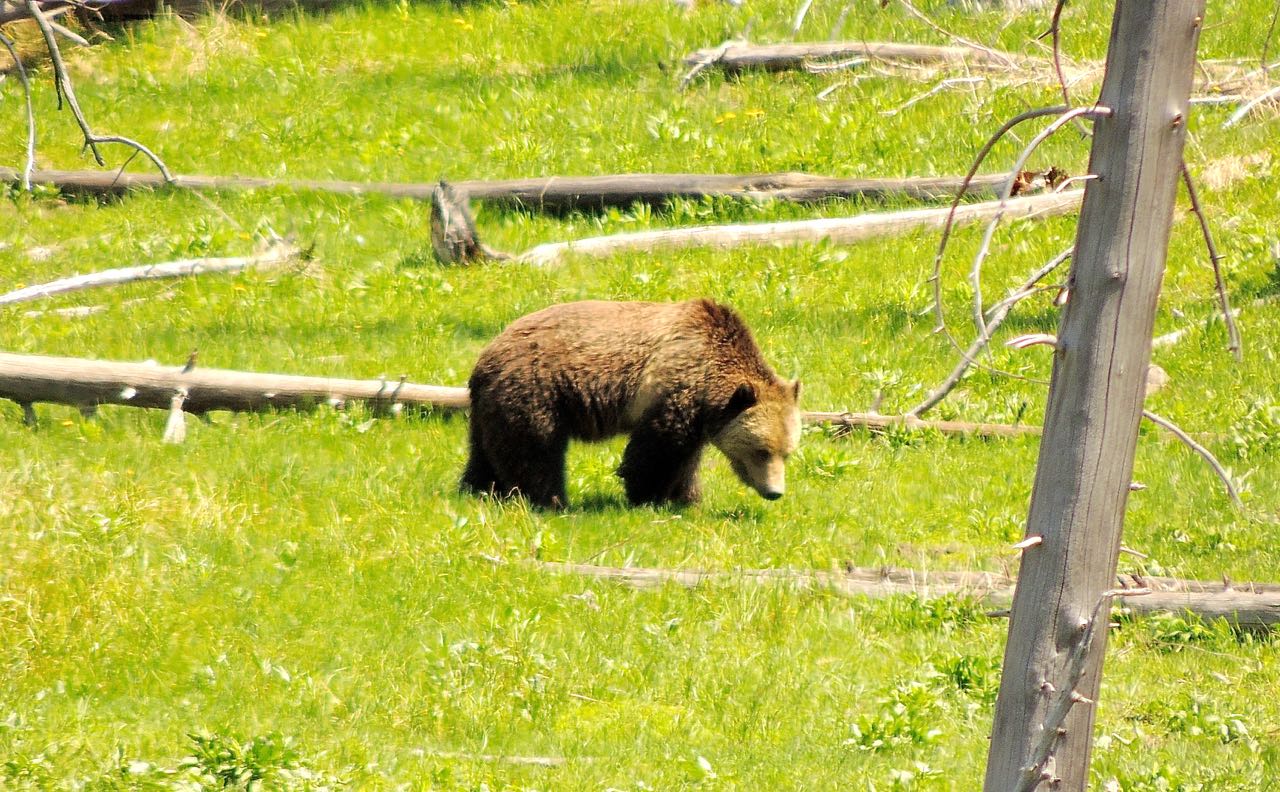 Grizzly Bear - Photo by William Young
Grizzly Bear - Photo by William Young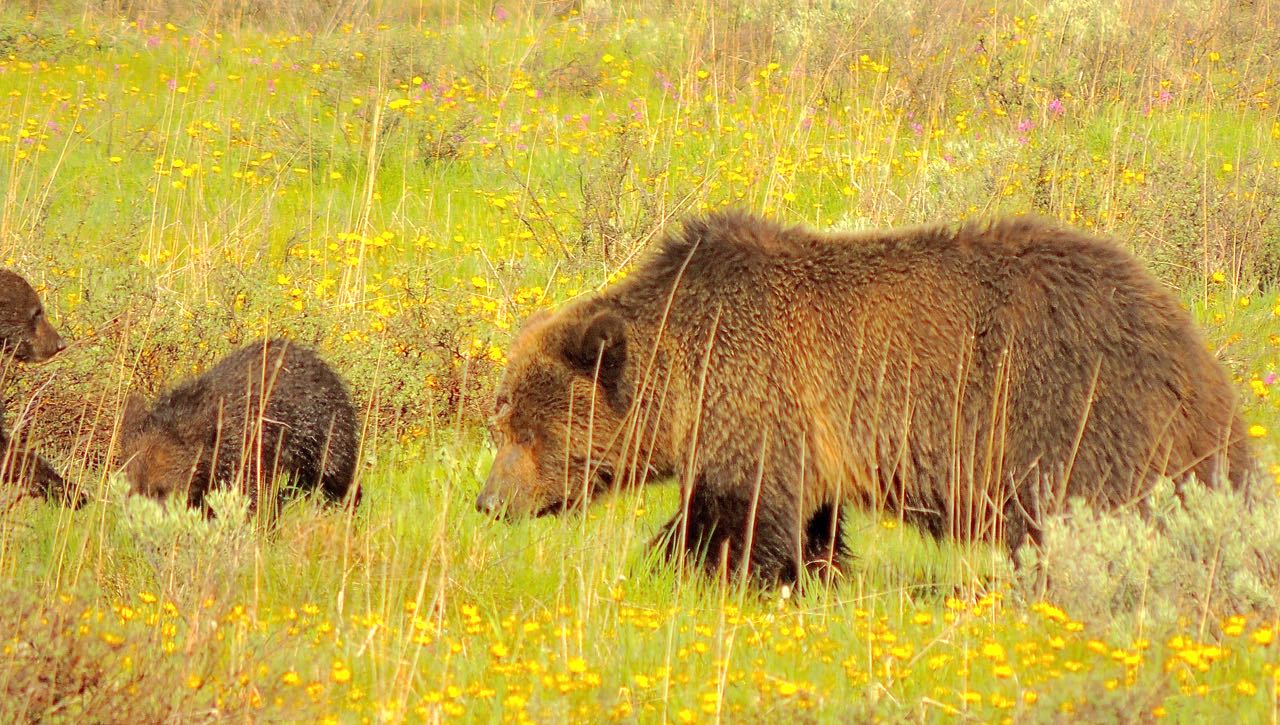 Grizzly Bears - Photo by William Young
Grizzly Bears - Photo by William Young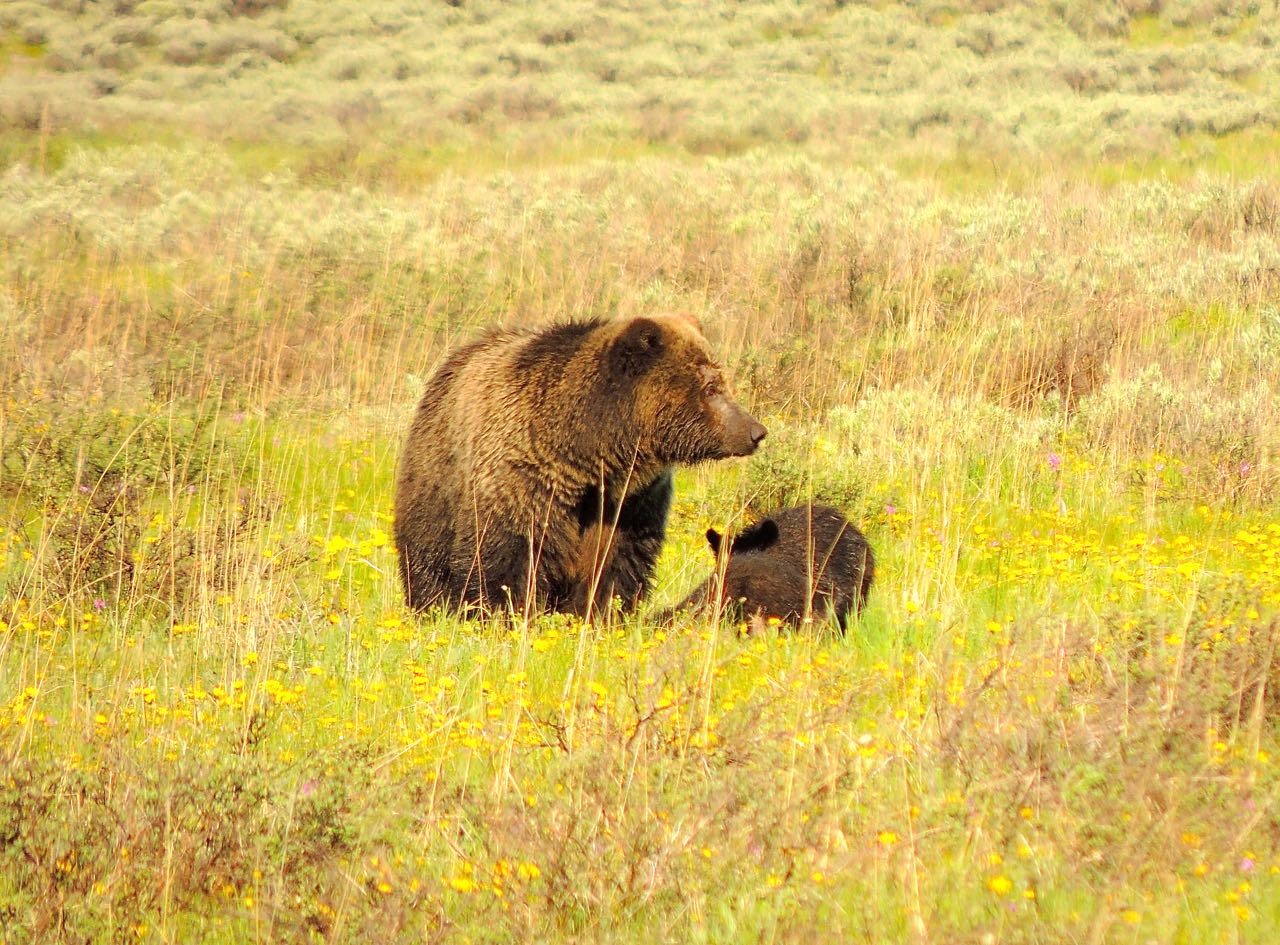 Grizzly Bears - Photo by William Young
Grizzly Bears - Photo by William YoungWe visited Yellowstone and the Tetons at a bad time to see Moose. The only Moose we saw was a male in the southern part of Yellowstone. We saw a lot of Elks, mostly females and young. Many were on the lawns near the Albright Visitors Center, and we had to be careful not to get between a mother and her offspring. Along the roads in Yellowstone, we saw a male, who had velvety antlers. We saw another male along the Moose-Wilson Road. Both Moose and Elks were very large — they are basically very large deer. The "antelope" they play with in the "Home on the Range" song are Pronghorns, who look like antelopes but are not related. We saw a lot during the trip — more while we were driving through Wyoming than when we were in Yellowstone. In a number of areas, we saw Bighorn Sheep grazing in a field next to the road.
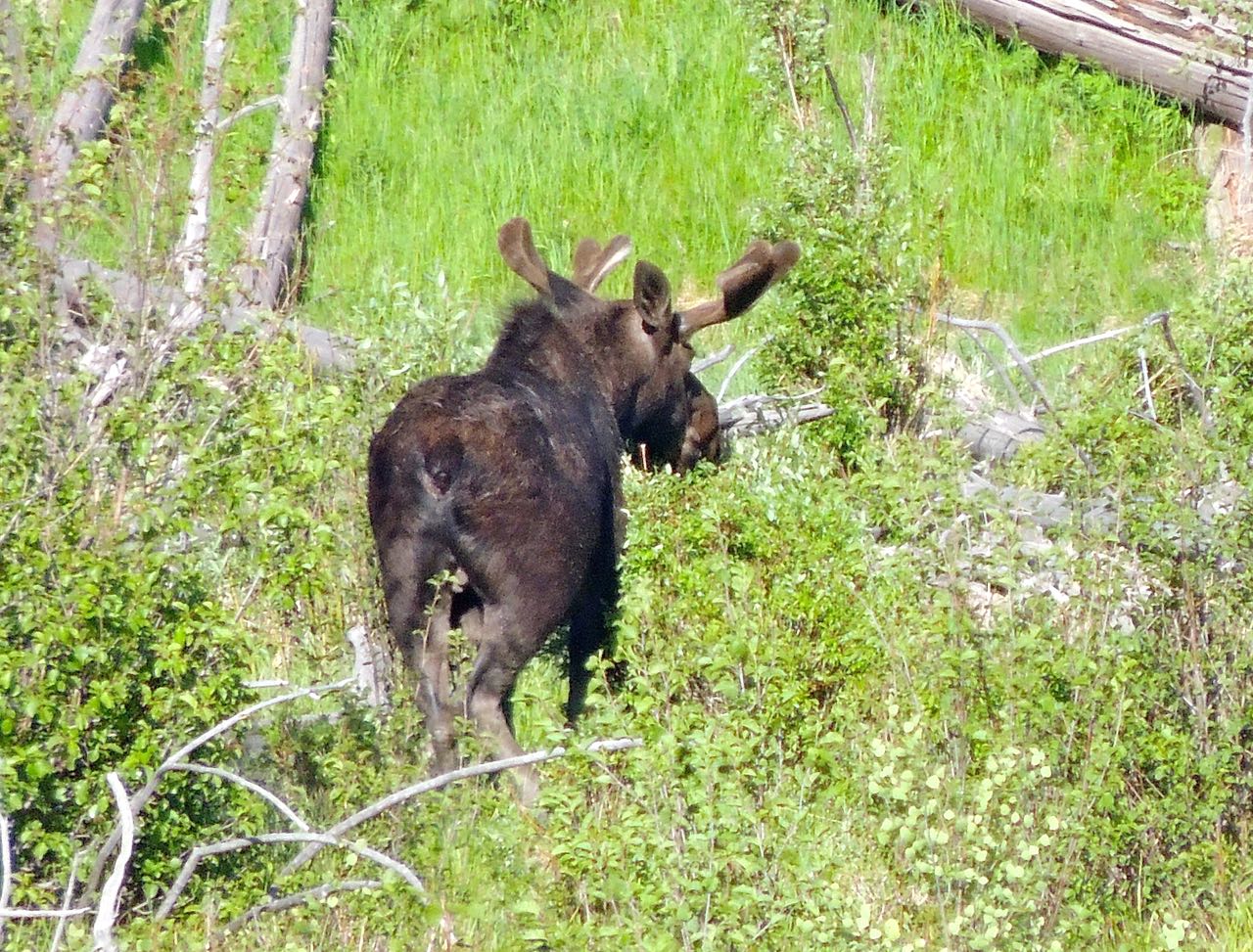 Moose - Photo by William Young
Moose - Photo by William Young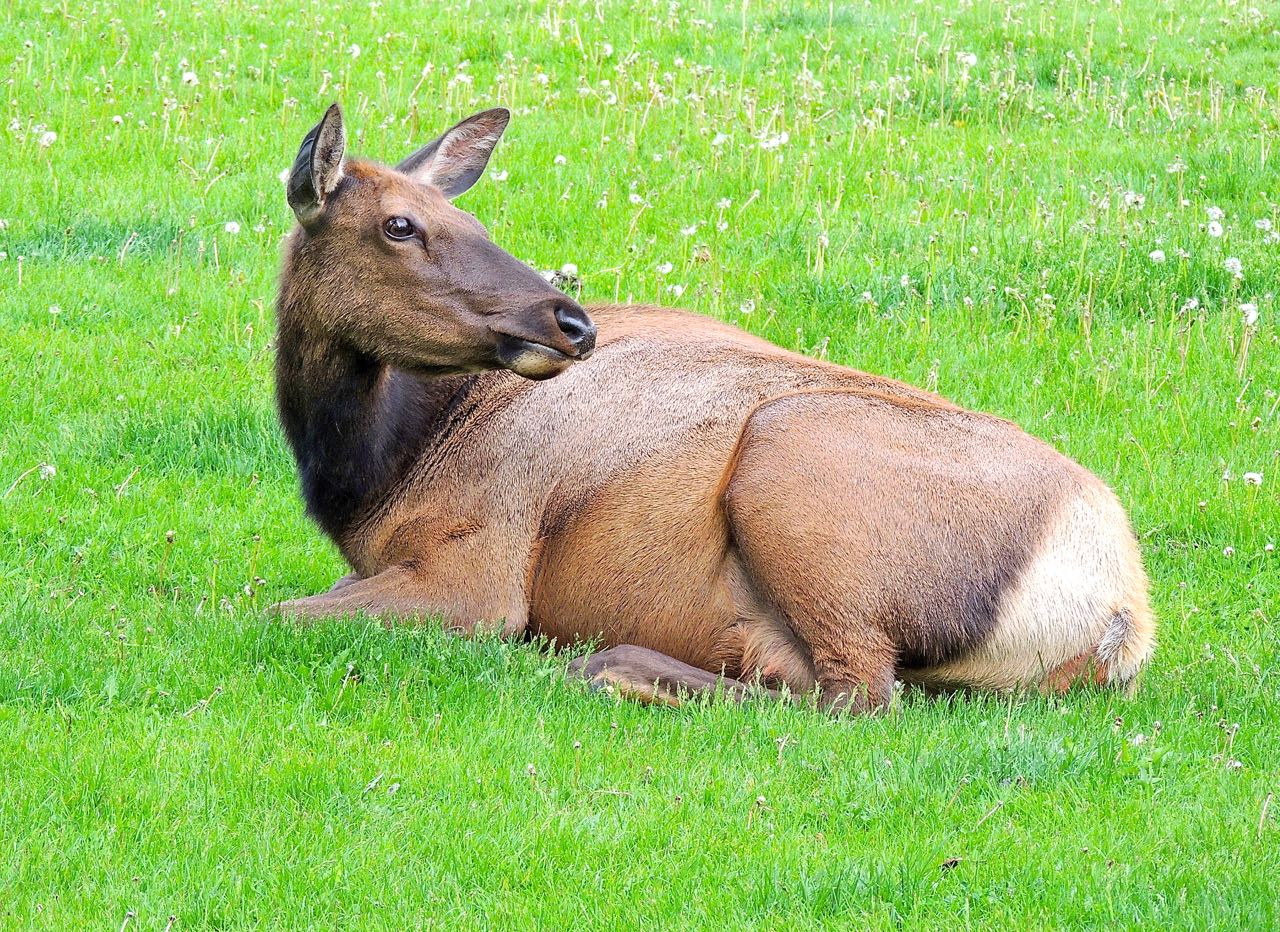 Female Elk - Photo by William Young
Female Elk - Photo by William Young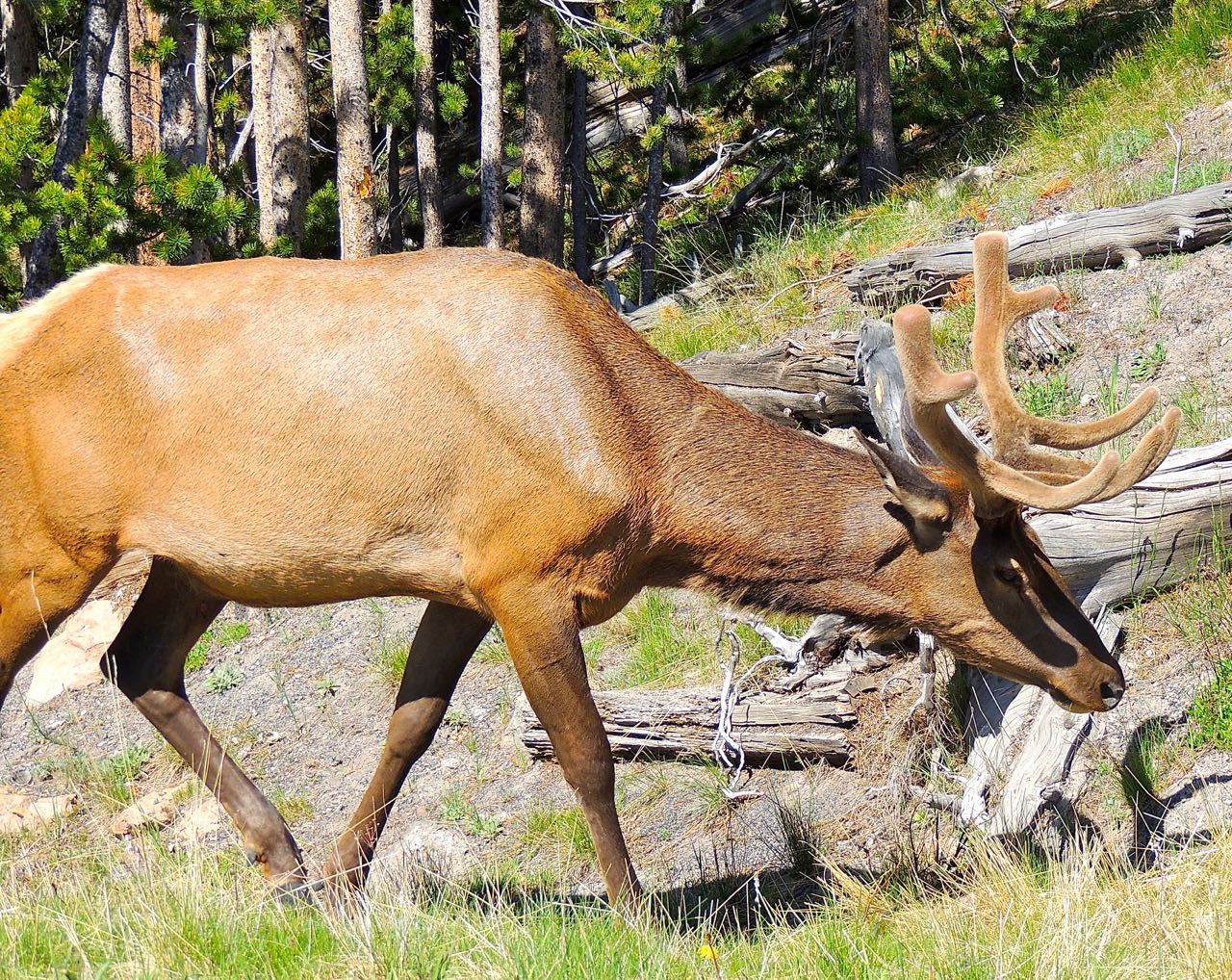 Male Elk - Photo by William Young
Male Elk - Photo by William Young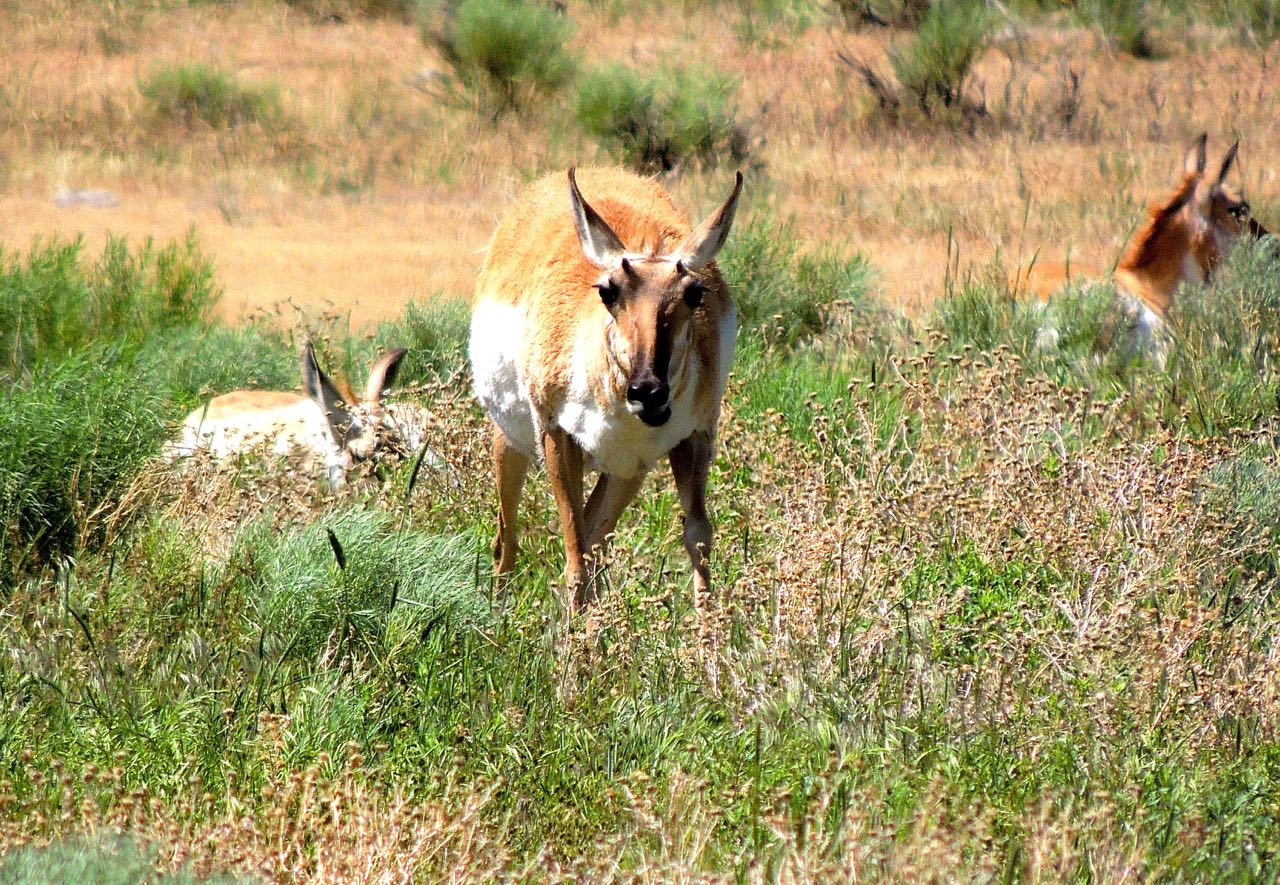 Pronghorns - Photo by William Young
Pronghorns - Photo by William Young Bighorn Sheep - Photo by William Young
Bighorn Sheep - Photo by William YoungThe archetypal animal of the American West is the American Bison. We saw our first ones in the state park in Thermopolis, and we saw many more when we arrived in Yellowstone. The ones in Thermopolis were either next to the road or in the middle of the road, so we had close looks. They appear to be covered with moth-eaten brown blankets, and their heads look too large for their bodies, like some of the athletic mascots for college football teams. One day, we saw a baby bison on the road, with Park Service officers on both sides of the road, telling passing motorists not to stop. The rest of the bison herd appeared to be about 300 yards away, so we were not sure what would become of the baby bison. About a month earlier, a Canadian was fined for putting a seemingly helpless baby bison into the back of his vehicle and bringing it to the ranger station. The bison had to be euthanized, because the rangers did not know where to find the mother, and it is illegal to give an animal from a National Park to a zoo. The person who picked it up was acting out of concern for the bison, but he received a lot of criticism for what he did.
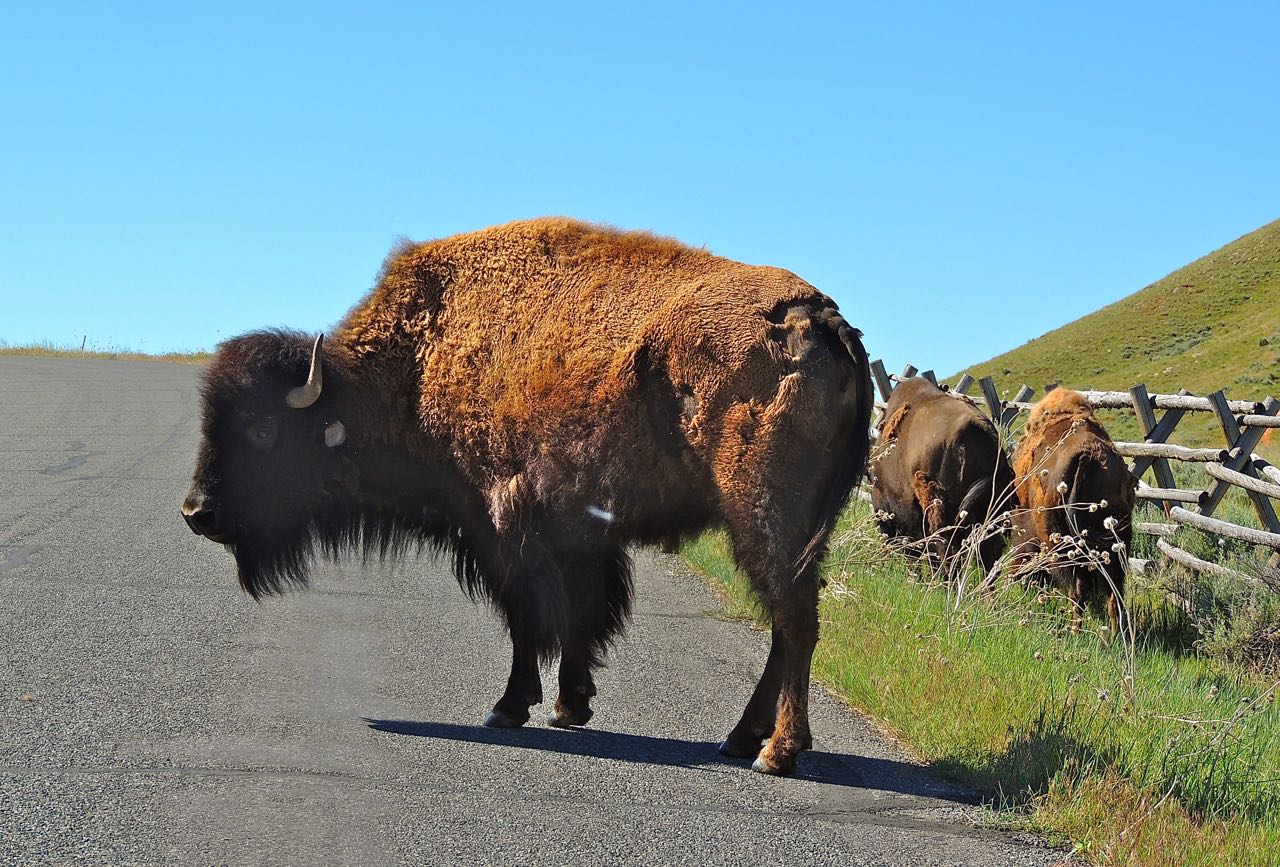 American Bison - Photo by William Young
American Bison - Photo by William YoungNear the Grand Canyon of the Yellowstone, we saw an animal cross the road whom we believed to be a Marten, a relative of weasels and skunks. Along the Beartooth Highway, we saw Yellow-bellied Marmots and Least Chipmunks. At one of the scenic overlooks, the chipmunks came near some of the tourists, looking for handouts. I saw Uinta Ground Squirrels in Yellowstone and also when we were farther south near the end of the trip. On Mormon Row, we came across a hole from which six baby ground squirrels had emerged. They were either too young to sense danger or were accustomed to being around people, because they were not alarmed when I was very close to them.
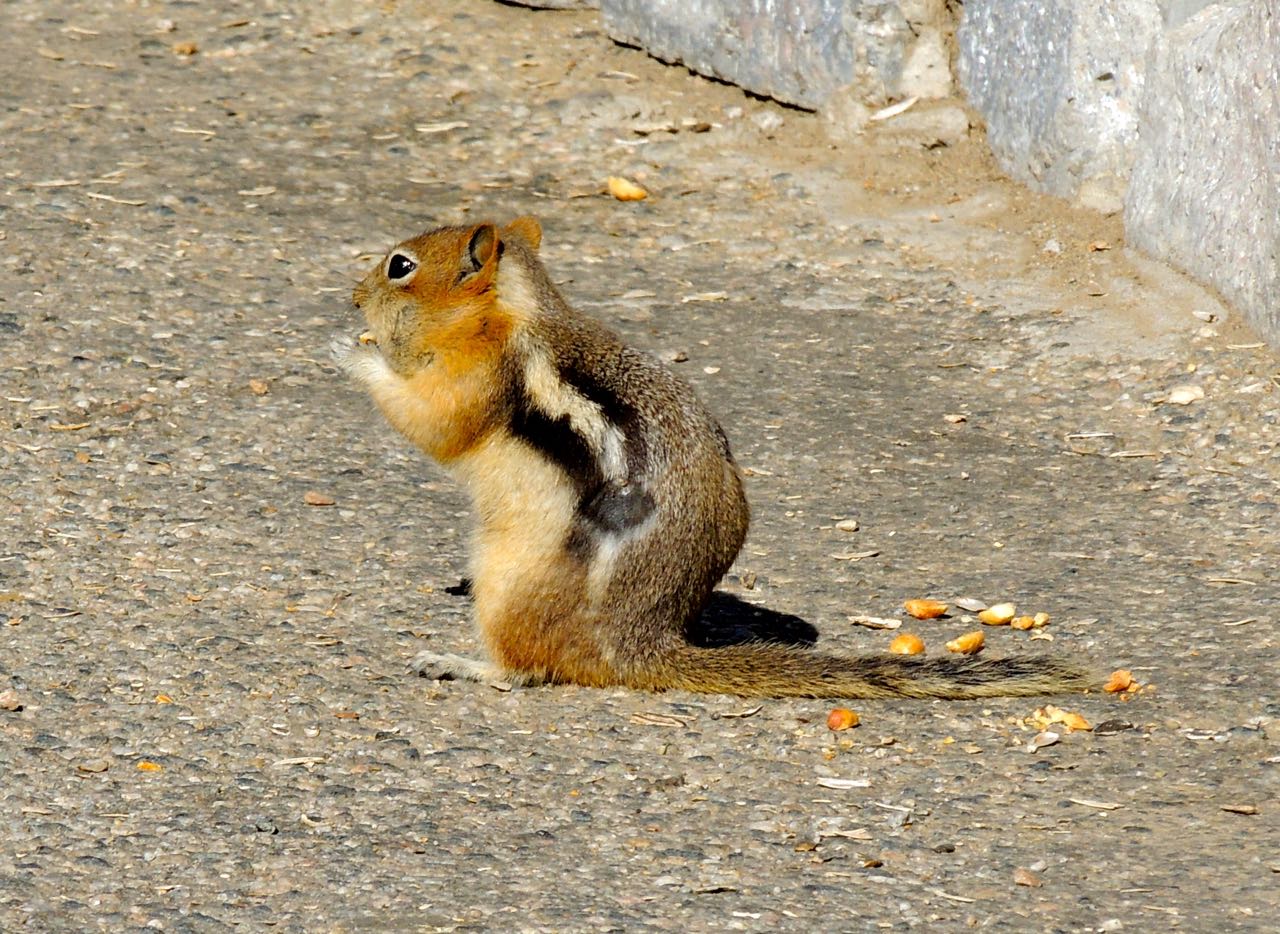 Least Chipmunk - Photo by William Young
Least Chipmunk - Photo by William Young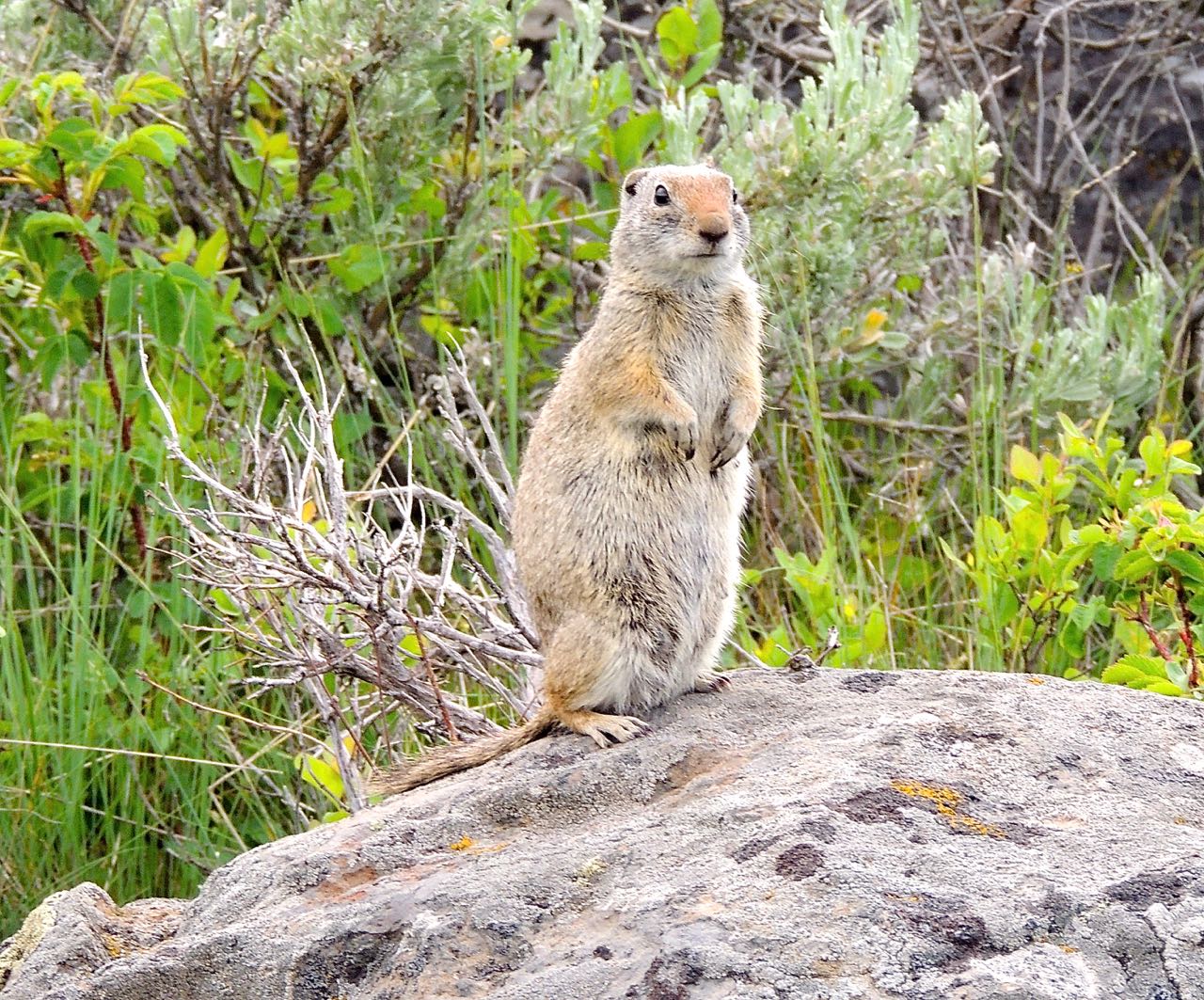 Uinta Ground Squirrel - Photo by William Young
Uinta Ground Squirrel - Photo by William Young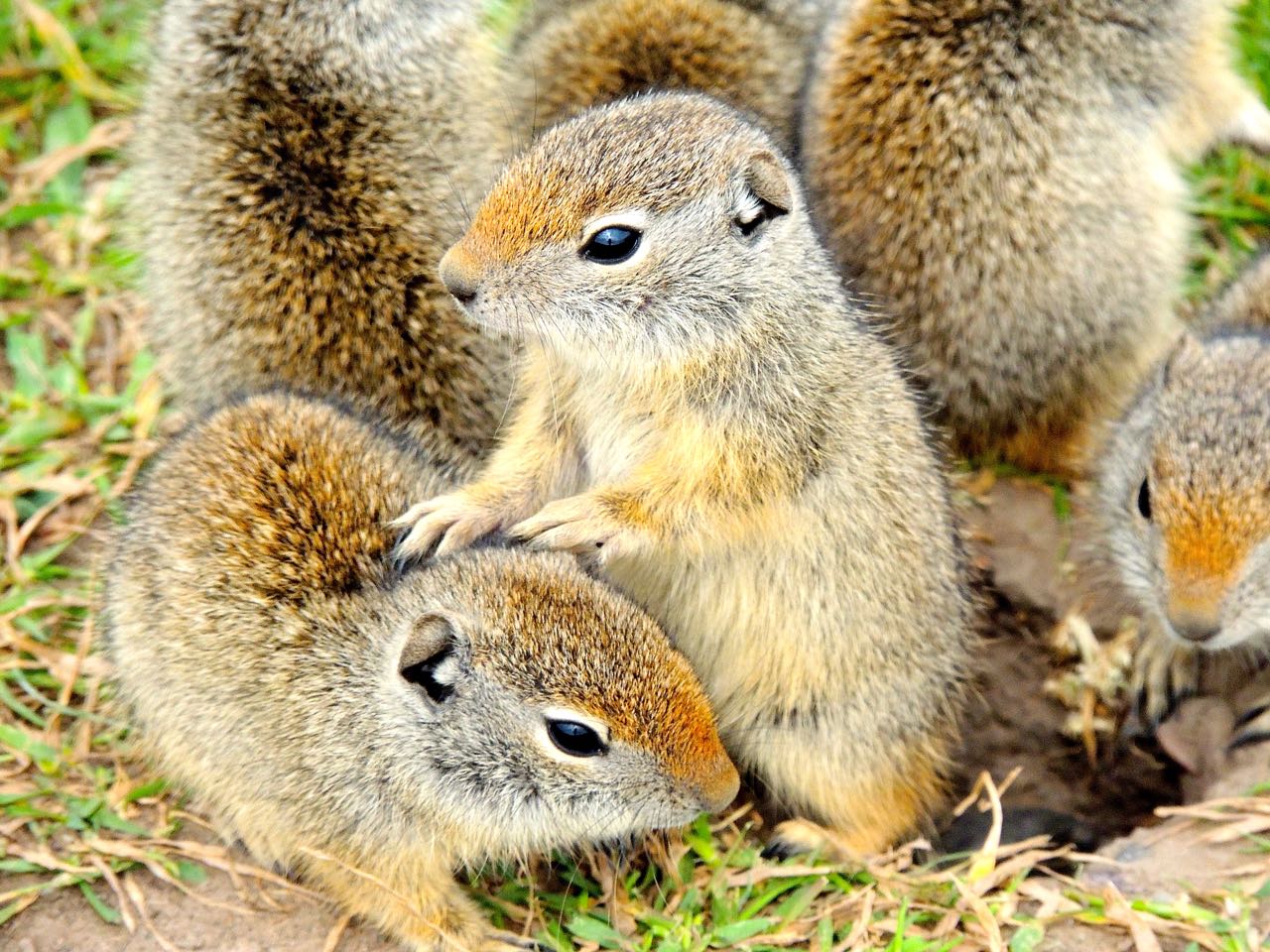 Baby Uinta Ground Squirrels - Photo by William Young
Baby Uinta Ground Squirrels - Photo by William YoungNear the Mammoth Hot Springs, I saw a Bullsnake slithering near the boardwalk. It was large and came fairly close, and I could see its forked black tongue.
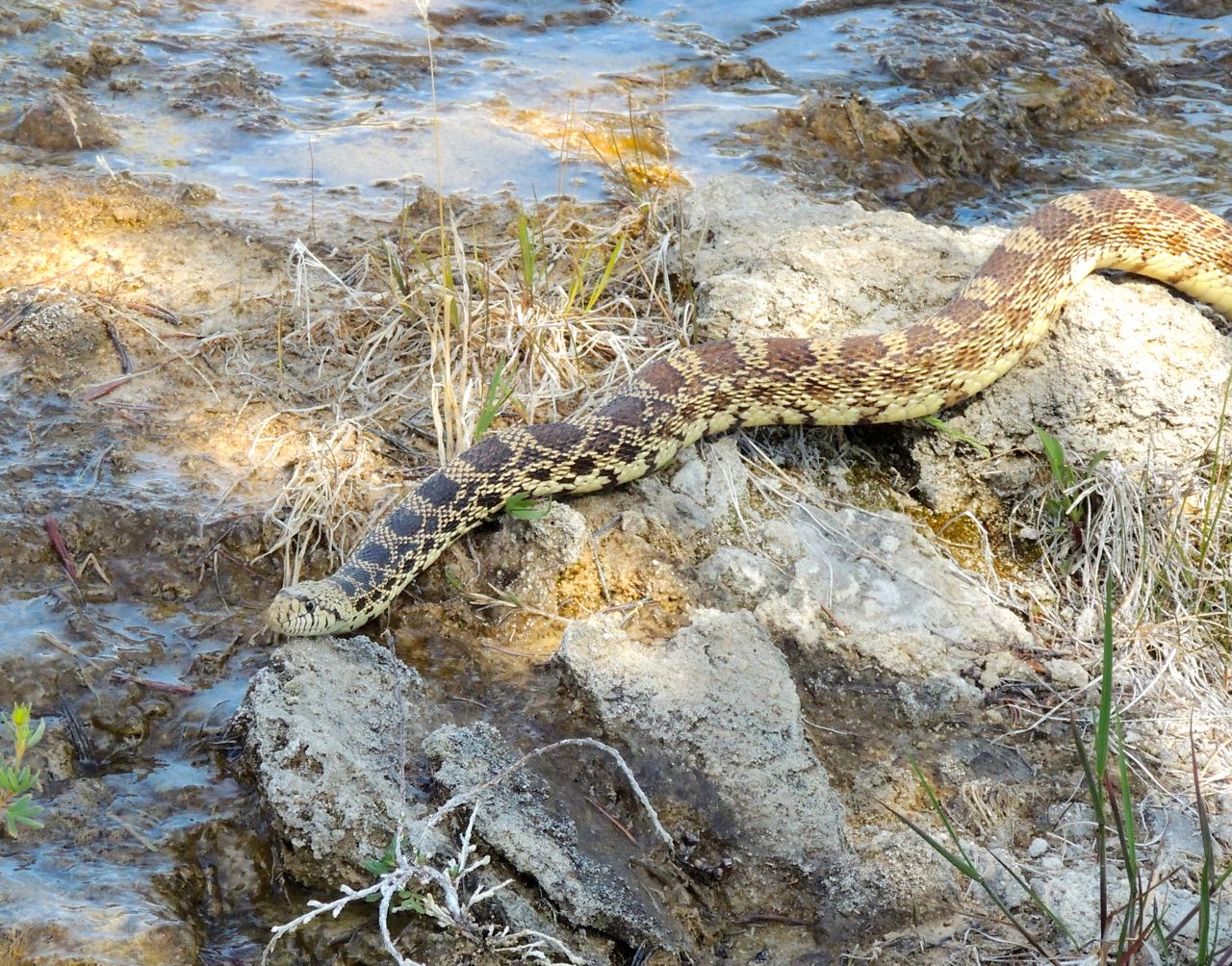 Bullsnake - Photo by William Young
Bullsnake - Photo by William Young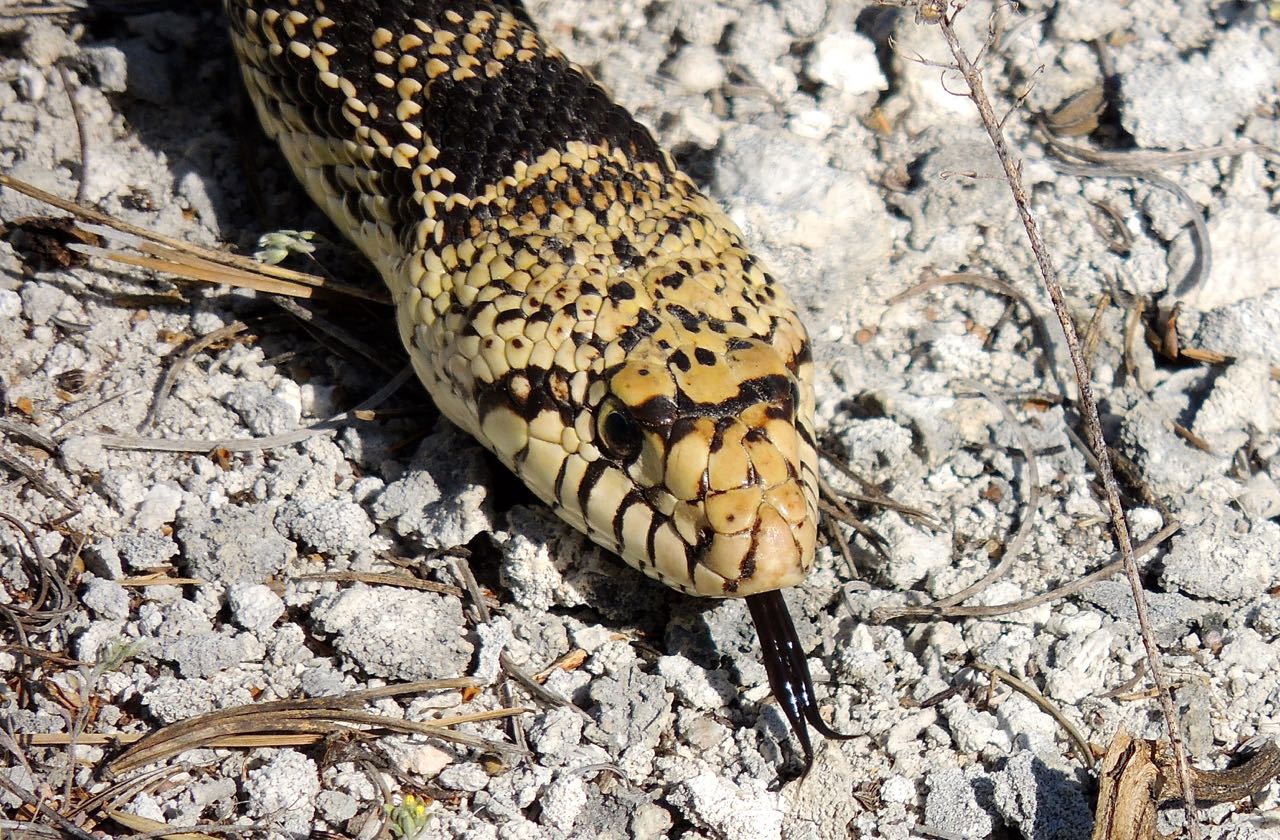 Bullsnake - Photo by William Young
Bullsnake - Photo by William Young